
HISTORYNET.com Summer 2023 CWTP-230700-COVER-DIGITAL.indd 1 4/6/23 11:05 AM
Personalized 6-in-1 Pen



Convenient “micro-mini toolbox” contains ruler, pen, level, stylus, plus flat and Phillips screwdrivers. Giftable box included. Aluminum; 6"L. 817970 $29.99
Personalized Garage Mats

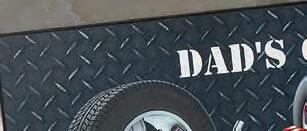




Grease Monkey or Toolman, your guy (or gal) will love this practical way to identify personal space. 23x57"W.












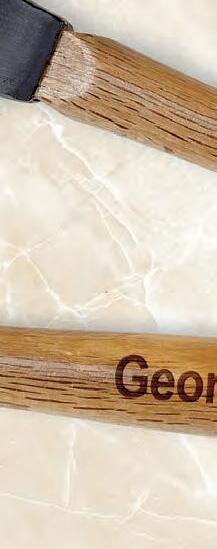
Tools 808724





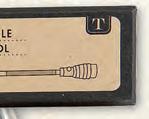
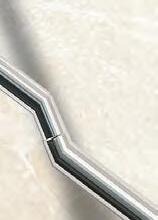

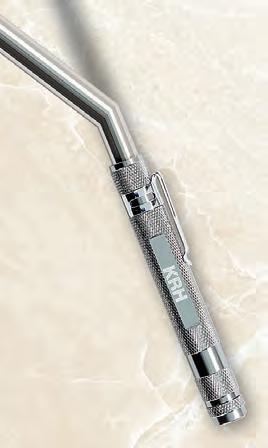









































Tires 816756 $45.99 each











Personalized Super Sturdy Hammer Hammers have a way of walking o . Here’s one they can call their own. Hickory-wood handle. 16 oz., 13"L. 816350 $21.99
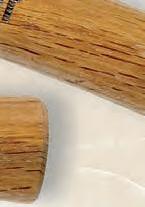
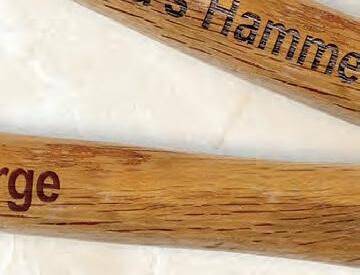



Personalized Extendable Flashlight Tool Light tight dark spaces; pick up metal objects. Magnetic 6¾" LED flashlight extends to 22"L; bends to direct light. With 4 LR44 batteries. 817098 $32.99

OFFER
CWT-230516-010 Lillian Vernon LHP.indd 1 4/6/2023 1:18:16 PM
RUGGED ACCESSORIES FOR THE NEVER-ENOUGH-GADGETS GUY. JUST INITIAL
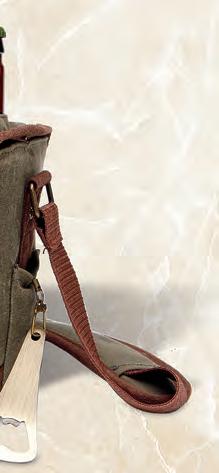



Personalized Grooming Kit


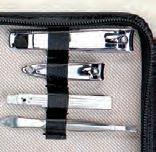

Indispensable zippered manmade-leather case contains comb, nail tools, mirror, lint brush, shaver, toothbrush, bottle opener. Lined; 5½x7".



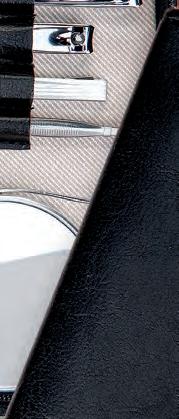

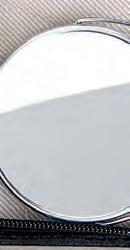
817548 $29.99






Personalized Beer Caddy Cooler Tote Soft-sided, waxed-cotton canvas cooler tote with removable divider includes an integrated opener, adjustable shoulder strap, and secures 6 bottles. 9x5½x6¾". 817006 $64.99

Personalized Bottle Opener Handsome tool helps top o a long day with a cool brew. 1½x7"W. Brewery 817820 Initial Family Name 817822 $11.99 each


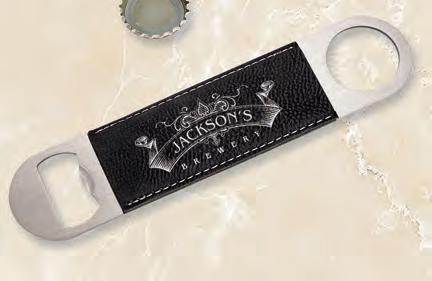
Personalized 13-in-1 Multi-Function Tool

All the essential tools he needs to tackle any job. Includes bottle opener, flathead screwdriver, Phillips screwdriver, key ring, scissors, LED light, corkscrew, saw, knife, can opener, nail file, nail cleaner and needle. Includes LR621 batteries. Stainless steel.

818456 $29.99



materials
we’ll personalize them with your good name
Go to LillianVernon.com or call 1-800-545-5426. *FREE SHIPPING ON ORDERS OVER $50. USE PROMO CODE: HISCWTM3 LILLIANVERNON.COM/CWT The Personalization Experts Since 1951 OFFER EXPIRES 8/31/23. ONLY ONE PROMO CODE PER ORDER. OFFERS CANNOT BE COMBINED. OFFER APPLIES TO STANDARD SHIPPING ONLY. ALL ORDERS ARE ASSESSED A CARE & PACKAGING FEE.
Our durable Lillian Vernon products are built to last. Each is crafted using the best
and manufacturing methods. Best of all,
or monogram. Ordering is easy. Shipping is free.*
HERE.
CWT-230516-010 Lillian Vernon RHP.indd 1 4/6/2023 1:20:10 PM
CIVIL WAR TIMES SUMMER 2023


2 CIVIL WAR TIMES SUMMER 2023
52
ON THE COVER: Andrew Tozier helped save the Union, and Joshua Chamberlain helped save Tozier.
CWTP-230700-CONTENTS.indd 2 4/5/23 10:21 AM
APPRECIATING GRANDPA Veterans of the 5th New Hampshire and their familes at the regiment’s Gettysburg monument.
28
Andrew Tozier’s Battles
By Jared Peatman
The tough life of a 20th Maine Gettysburg hero, and how he was saved by his famous colonel.


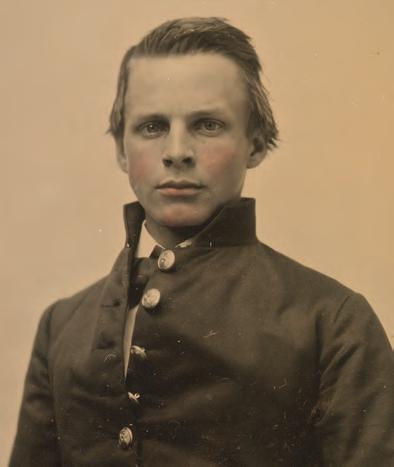
38
44
To Fight Another Day
By Stuart Sanders
A small steamboat saves a Confederate army from destruction after the 1862 Battle of Mill Springs, Ky.
‘I Was the First Who Fell’
By Harry Smeltzer
Four Confederate soldiers describe their harrowing introduction to war during the First Battle of Manassas.
52 Evolution of a Battlefield
By Michael Waricher

Rare, fascinating early photographs of the Gettysburg battlefield.

SUMMER 2023 CIVIL WAR TIMES 3 Departments Features CLOCKWISE FROM LEFT: GETTYSBURG NATIONAL MILITARY PARK; NATIONAL PORTRAIT GALLERY; HERITAGE AUCTIONS, DALLAS; PHOTO BY JOHN BANKS; COVER: MAINE STATE ARCHIVES/PHOTO ILLUSTRATION: BRIAN WALKER 44 6 Return Fire More Evidence 8 Miscellany Old Abe Standing 14 Details Riding That Train 16 Insight Sculptor of Wartime Scenes 18 Rambling A Passsion for Franklin, Tenn. 22 Interview New Brandy Station Leader 27 Editorial Fifteen Minutes of Fame 60 Armament Deadly Spencer Rifle 64 Reviews Understanding Joe Johnston 72 Sold ! Cannon for a Shelf
18 60 CWTP-230700-CONTENTS.indd 3 4/5/23 10:21 AM
Did Hollywood Get Chamberlain Right?
EDITORIAL
DANA B. SHOAF EDITOR IN CHIEF
CHRIS K. HOWLAND SENIOR EDITOR
BRIAN WALKER GROUP DESIGN DIRECTOR
MELISSA A. WINN DIRECTOR OF PHOTOGRAPHY
AUSTIN STAHL ASSOCIATE DESIGN DIRECTOR
ALEX GRIFFITH PHOTO EDITOR
CLAIRE BARRETT NEWS AND SOCIAL EDITOR
ADVISORY BOARD
Gabor Boritt, Catherine Clinton, Thomas G. Clemens, William C. Davis, Gary W. Gallagher, Lesley Gordon, D. Scott Hartwig, John Hennessy, Harold Holzer, Caroline E. Janney, Robert K. Krick, James M. McPherson, Ethan S. Rafuse, Phil Spaugy, Megan Kate Nelson, Susannah J. Ural
CORPORATE
KELLY FACER SVP REVENUE OPERATIONS
MATT GROSS VP DIGITAL INITIATIVES
ROB WILKINS DIRECTOR OF PARTNERSHIP MARKETING
JAMIE ELLIOTT SENIOR DIRECTOR, PRODUCTION
ADVERTISING
MORTON GREENBERG SVP Advertising Sales mgreenberg@mco.com
TERRY JENKINS Regional Sales Manager tjenkins@historynet.com

DIRECT RESPONSE ADVERTISING
NANCY FORMAN MEDIA PEOPLE nforman@mediapeople.com
SUBSCRIPTION INFORMATION
800-435-0715 and SHOP.HISTORYNET.COM
© 2023 HISTORYNET, LLC
Civil War Times (ISSN 1546-9980) is published quarterly by HistoryNet, LLC, 901 Glebe Road, 5th Floor, Arlington, VA 22203 Periodical postage paid at Vienna, VA and additional mailing offices. POSTMASTER, send address changes to:

Civil War Times, P.O. Box 900, Lincolnshire, IL 60069-0900
List Rental Inquiries: Belkys Reyes, Lake Group Media, Inc. 914-925-2406; belkys.reyes@lakegroupmedia.com
Canada Publications Mail Agreement No. 41342519, Canadian GST No. 821371408RT0001




The contents of this magazine may not be reproduced in whole or in part without the written consent of HistoryNet, LLC
PROUDLY MADE IN THE USA
NATIONAL ARCHIVES 4 AMERICA’S CIVIL WAR Sign up for our FREE e-newsletter, delivered twice weekly, at historynet.com/newsletters HISTORYNET VISIT HISTORYNET.COM PLUS! Today in History What happened today, yesterday— or any day you care to search. Daily Quiz Test your historical acumen—every day! What If? Consider the fallout of historical events had they gone the “other” way. Weapons & Gear The gadgetry of war—new and old— effective, and not-so-effective. TRENDING NOW A historian sheds new light on Joshua Chamberlain and his 20th Maine’s bayonet charge down Little Round Top. By Tom
historynet.com/fact-vs-fictionchamberlain
MICHAEL A. REINSTEIN CHAIRMAN & PUBLISHER SUMMER 2023 / VOL. 62, NO. 3
Desjardin
CWTP-230700-MASTHEAD.indd 4 4/13/23 8:33 AM
Our 1/30 scale metal figures are painstakingly researched for historical accuracy and detail. The originals are hand sculpted by our talented artists before being cast in metal and hand painted – making each figure a gem of hand-crafted history. Please visit wbritain. com to see all these figures and more from many other historical eras.



















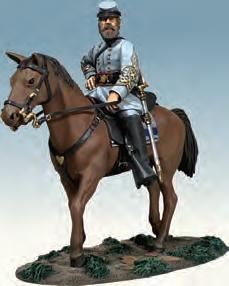














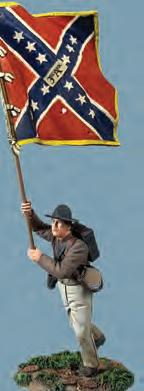



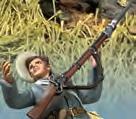
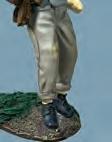

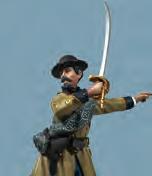















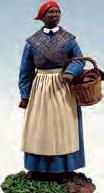






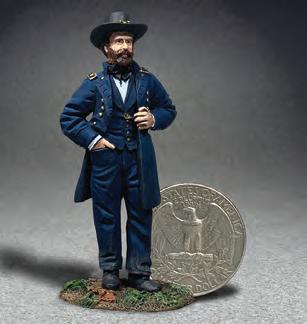







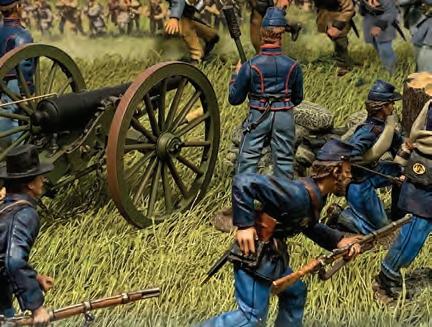

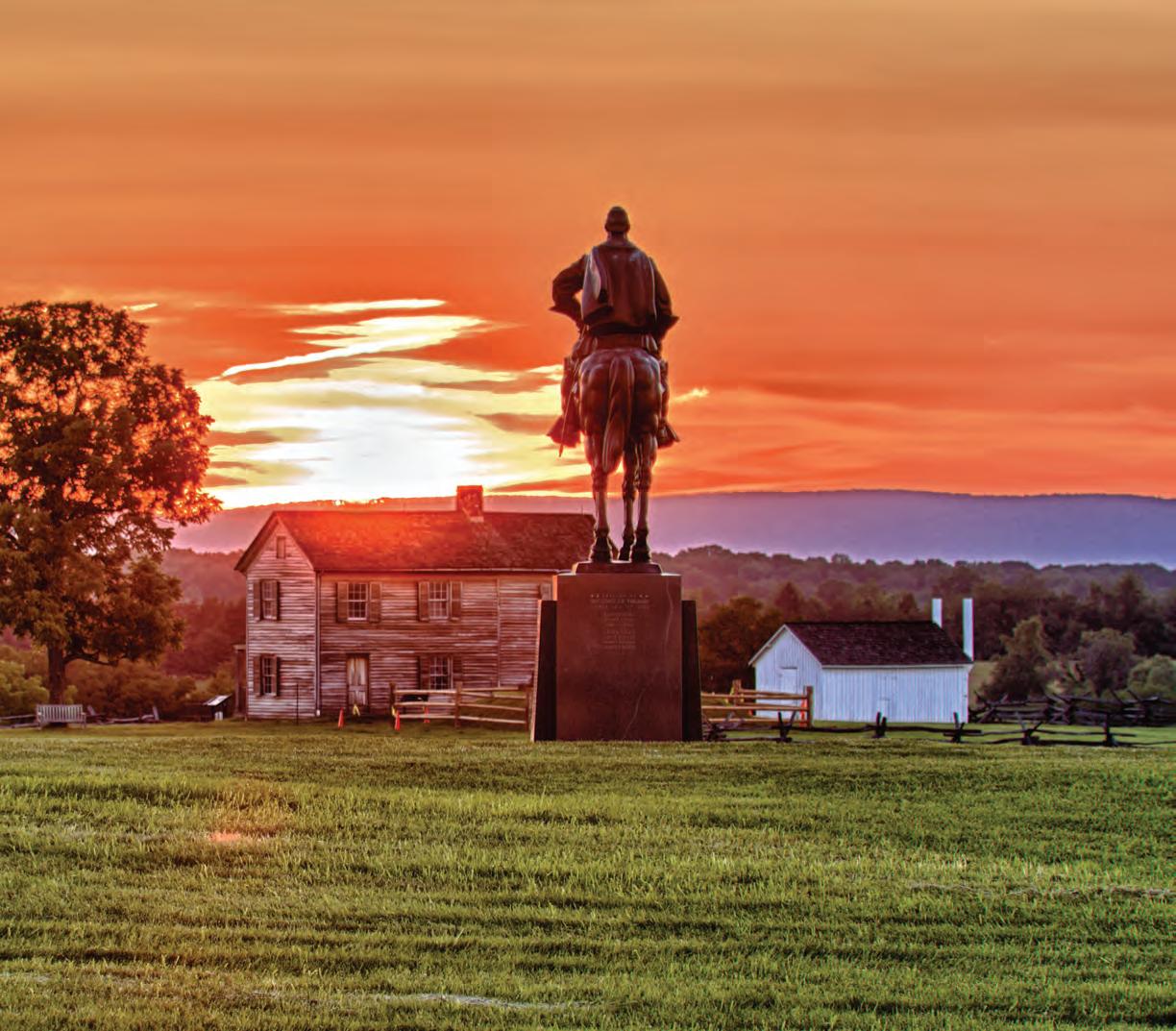
THIS HALLOWED GROUND : A TOUR YOU WON’T FORGET STEPHEN AMBROSE HISTORICAL TOURS PRESENTS May 13-21, June 17-25 or September 16-24, 2023 EXPLORE NOW AT STEPHENAMBROSETOURS.COM 1.888.903.3329 Lives Remembered are never Lost Relive Civil War history! Walk This Hallowed Ground Gettysburg and Appomattox to experience the beginning and end of the Civil War. Visit Memphis, Shiloh, Vicksburg and New Orleans on our Mississippi River Campaign , to study “the key to the Confederacy.” Explore the rivers, ridges and the battles that raged from Atlanta to Chattanooga to Nashville on our Civil War on the Rivers, Rails and Mountains Tour Our Civil War, American History and WWII tours are unrivaled in their historical accuracy! Gettysburg BOOK NOW! WBHN-CWT SUMMER ©2023 W.Britain Model Figures W.Britain, and are registered trademarks of the W.Britain Model Figures, Chillicothe, OH Follow us on Facebook: W-Britain-Toy-SoldierModel-Figure-Company Subscribe to us on YouTube: W.Britain Model Figures See these and more W.Britain 1/30 scale historical metal figures at: Tel: U.S. 740-702-1803 • wbritain.com • Tel: U.K. (0)800 086 9123
Call W.Britain and mention thisad for a FREE CATALOG Also receive a MINI BACKDROP with your first purchase! matte finish Hand-Painted Pewter Figures 56/58 mm-1/30 Scale 10094 Union General U.S. Grant $48.00 31261 Confederate Infantry Texas Brigade Advancing,
31334 Confederate
$48.00 Advancing 31316 Confederate
“Stonewall” Jackson Mounted on Little Sorrel $120.00 10085 Frederick Douglass American Abolitionist and Social Reformer $48.00 10095
54th Massachusetts $49.00 10088
American Abolitionist
10086
54th Massachusetts $48.00
Canister!
31380
10096
31394
Brigade $64.00 31389 Confederate
Texas
Texas
Confederate
CWT-230516-007 WBritian Model Figures.indd 1 4/6/2023 11:24:58 AM
No.2 $48.00
Casualty Falling
General
Colonel Robert Gould Shaw,
Harriet Tubman
$48.00
Sergeant Major Lewis Douglass,
uglass,Do 31313 Sending Mischief Down Range Federal Artillery Firing 10-Pound Parrott Gun $185.00 31395 Give ’Em
Confederate 12 Pound Napoleon and Crew $200.00
Confederate Infantry Bugler, $48.00
Sgt. William Carney, Flagbearer, 54th Massachusetts $64.00 Confederate Flagbearer, 1st Texas Flag, Wigfall Pattern, Texas Brigade
Confederate Flagbearer, 3rd Arkansas Flag, Texas
Flagbearer, 5th
Flag,
Brigade $64.00
Infantry Waving ANV Flag
Thank you for including the article “Nothing of the Kind Ever Took Place” by Marc Storch and Kevin Hampton regarding the exploits of 2nd Wisconsin Captain William Strong in the Spring issue. I have a letter in my possession written by Private Levi B. Raymond of the 6th Wisconsin Infantry that calls into question the actions of Captain Strong. I had always wondered how well known the story was, and the article paints a very clear picture of just how controversial Strong’s story was.

In the letter, dated October 13, 1861, to a friend back in Wisconsin, Raymond quotes Captain George Ely of Company D, 2nd Wisconsin, saying, “the whole story in regard to Capt Strong’s pretended adventure was a sheer fabrication from beginning to end, and the story he tells, is that the general supposition among the officers of the 2nd, is that Will made it up for his own glorification.” Raymond then goes on to spell out all of the inaccuracies discussed in the article. Toward the end of his letter Raymond further quotes Captain George Ely of the 2nd Wisconsin stating, “beginning to end a thorough piece of humbug and a miserable, disgraceful piece of charlatinism [sic].” Raymond finishes the letter asking his friend to not repeat any of the story as he is not sure what version would be retold or believed. Thank you again for the great article.
Spencer P. Davis Ironton, Wis.
RETURN FIRE
SHARPSBURG’S HARDSHIPS
I enjoyed Steven Cowie’s article, “Battle’s Hard Aftermath,” in the Spring issue. I’m glad his excellent book, When Hell Came To Sharpsburg, and the subject it covers, the hardships experienced by the citizens of Sharpsburg, Md., are getting the attention they deserve. Far too often the death, destruction, and disease civilians have to face after armies move on is glossed over by the heroics and sacrifices of soldiers. Sharpsburg’s citizens suffered a fate that no other town above the Potomac River did, considering the effects of the battle and then the subsequent six-week occupation by the Army of the Potomac. The book, and the article, is a tremendous resource on the physical and environmental destruction that civilians on both sides suffered.
Tom Leupold Baltimore, Md.
DOUBTFUL IT’S QUANTRILL
The letter by Ricky Newport in the Winter 2023 issue’s “Return Fire” column concerning the source of the image of William Quantrill published in the Autumn 2022 issue (left) caught my attention. Like Mr. Newport, I questioned the attribution that the image was Quantrill. Please note that the revolver held by the man in the image appears to be a Smith & Wesson Model No.3. This revolver was not introduced until 1870, five years after Quantrill’s death. I would suggest that the image is actually supposed to be Jesse W. James, who was known to use this model of revolver and who was certainly associated with Quantrill during the Civil War and was definitely a wellknown “Bank and Train Robber.” James was also known to wear a full beard, and indeed was wearing a full beard at the time he was shot and killed in 1882.
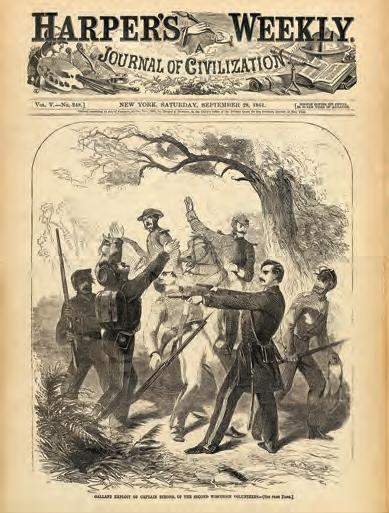
 Dale S. Snair
Dale S. Snair
Newark, Ohio
WOODRUFF GUN
Please tell me the provenance of the G.A.R. photo on page 43 of the Winter 2023 issue showing the small cannon. The tube appears to be a Woodruff gun, although the carriage is not original. I am researching the Woodruff gun, a small fieldpiece named for Connecticut inventor James Woodruff and would like to know where the photo was taken and what G.A.R. post is pictured. Perhaps the tube is still in that vicinity. How might
6 CIVIL WAR TIMES SUMMER 2023
LIBRARY OF CONGRESS; ROCK ISLAND AUCTION HARPER’S WEEKLY BANK AND TRAIN ROBBERS OF THE WEST
CWTP-230700-RETURNFIRE.indd 6 4/11/23 1:18 PM
‘CHARLATINISM’
POSSIBLE WOODRUFF?
This is the image of a small cannon used in a G.A.R. parade that appeared in the Winter issue. Is it a Woodruff? The diminutive fieldpieces did see action in the Trans-Mississippi Theater. Only about 35–40 of the cannons were produced.


I obtain a copy of the photo? Thanks for an enjoyable magazine for many decades.
Randy Baehr St. Louis, Mo.
Editor’s Note: That image is held at the Library of Congress, and you can find it at www.loc.gov/item/2014688449/ in their prints and photographs database.
DRY REGIMENT
I really enjoyed Megan Bever’s article about alcohol use during the Civil War. At the opposite end of the spectrum the 24th Iowa Volunteer Infantry was known as the “Temperance Regiment.” It was composed of “men of temperance principles and temperance habits—that is to say, of men who touched not, taste not, handle not spirituous or malt liquor, wine or cider.” They were
mustered in on September 18, 1862, and mustered out on July 17, 1865.
Jim Petersen Santa Fe, N.M.
CWT MAKES A GOOD DAY
My eyes light up when I pull a new issue of Civil War Times out of my mailbox, and I immediately start flipping through the pages. The Spring publication was packed full of interesting articles such as Gary Gallagher’s column on the French newspaper Le Temps coverage of the War of the Rebellion and Caroline E. Janney’s story about who went to war. John Banks’ “Ramblings” are always informative and entertaining. How interesting it was to read about Chris Utley, an old reenacting acquaintance, and his reproductions of Civil War–era handkerchiefs. Darn if I didn’t order
one! Carry on and by all means, keep on digging.
Mark Grimm
North Royalton, Ohio
SHARPSHOOTER IMAGE
I was excited to see the picture of the three Sharpshooter recruits, from Company E, 2nd Regiment United States Sharpshooters, in the latest issue of Civil War Times. My great-grandfather, Homer R. Stoughton, was the original company commander. He went on to command the 2nd Regiment from Gettysburg on. I have attached a photo of an original recruiting poster from Co. E, I thought you might like to see it. Note the two missing spots where it was tacked up. Thankfully the important text is all there. Thanks for your article. Would love to see more on the 2nd USSS.
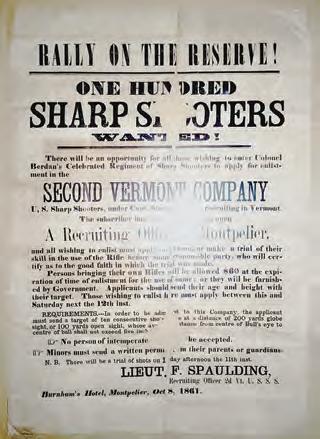 Pete Beisler
Cumberland, Maine
Pete Beisler
Cumberland, Maine
SUMMER 2023 CIVIL WAR TIMES 7 WE WANT TO HEAR FROM YOU! e-mail us at cwtletters@historynet.com @CivilWarTimes LIBRARY OF CONGRESS; ROCK ISLAND AUCTION HARPER’S WEEKLY BANK AND TRAIN ROBBERS OF THE WEST
CWTP-230700-RETURNFIRE.indd 7 4/11/23 2:34 PM
RARE LINCOLN PORTRAIT UNVEILED
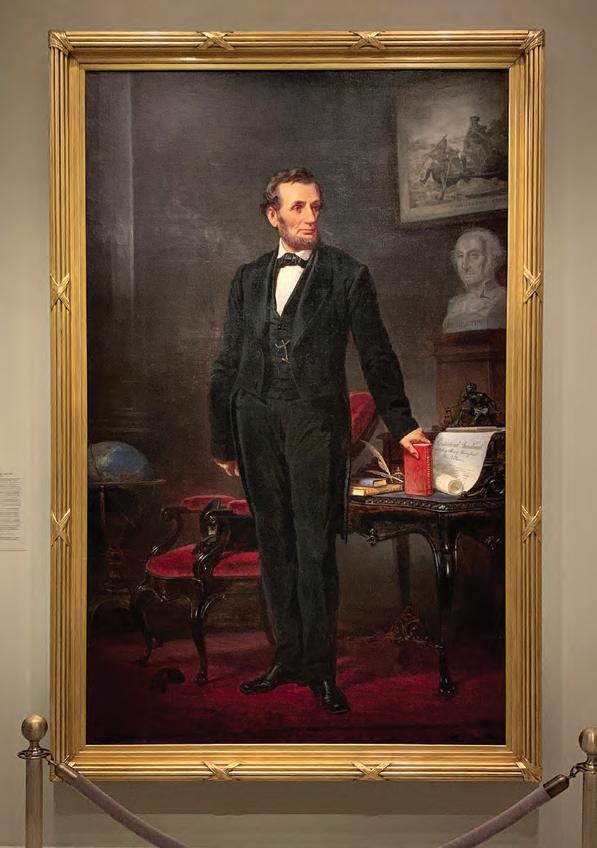
The National Portrait Gallery in February unveiled a rare portrait of President Abraham Lincoln. The nine-foot-tall portrait, painted by W.F.K. Travers in 1865, is one of only three known full-length renderings of the 16th president and will be on loan to the Smithsonian gallery in Washington, D.C., for the next five years.
FULL OF SYMBOLISM
In his portrait of Abraham Lincoln, Artist W.F.K. Travers also painted “Washington Crossing the Delaware” on the wall, a bust of the first president, the 13th Amendment, and a statue of an enslaved man breaking his chains.
The painting, which hung for decades in a municipal building in a small New Jersey town, has been restored and is now part of the “America’s Presidents” gallery.
Lincoln sat for Travers in 1864, and Travers completed the oil painting in Germany shortly after Lincoln’s assassination in April 1865. Travers then sold the painting to an American diplomat living in Frankfurt. In 1876, the painting was displayed at an exposition in Philadelphia, where Mary Todd Lincoln was reportedly “so overcome by its lifelike appearance that she fainted and was carried out of the hall.”
For years, it hung in the U.S. Capitol while Congress considered whether to purchase it, but it was ultimately sold to the Rockefeller family. In the 1930s, Geraldine Rockefeller Dodge—daughter of William Jr. and niece of John D.—built the Hartley Dodge Memorial Building in memory of her deceased son and filled it with art, including the Lincoln portrait.
In 2017, an archivist discovered that a marble bust of Napoleon sitting in the corner of the council room of the Hartley Dodge Memorial Building had been sculpted by Auguste Rodin, prompting the foundation to reassess all of the art in its collection. The loan of the Lincoln portrait to the National Portrait Gallery is part of that reassessment.
In addition to Lincoln’s likeness, the painting is filled with symbols noting the president’s place in history. He stands in front of a bust of George Washington and a rendering of the painting “Washington Crossing the Delaware” by Emanuel Leutze. Lincoln’s hand rests on a bound copy of the Constitution, next to a scroll bearing a draft of the 13th amendment. Behind the scroll is a small statue of an African American man rising as he pulls the chains from his body.

8 CIVIL WAR TIMES SUMMER 2023 MISCELLANY COURTESY OF CIVIL WAR TRAILS INC.; COURTESY OF THE WAUPUN HISTORICAL SOCIETY PHOTO BY MELISSA A. WINN
CWTP-230700-MISCELLANY.indd 8 4/4/23 10:18 AM
AGAINST THE ODDS
ON APRIL 3, Civil War Trails unveiled a new sign at the first Civil War Trails site that champions the story of Jewish soldiers. Located at the Love Hope Center for the Arts in Fayetteville, W.Va., it tells the story of men commanded by future-President Rutherford B. Hayes and camped in the wilds of West Virginia who managed to pull together the items required to properly observe the Passover holiday in 1862.
“In the midst of our nation’s darkest hour, these soldiers came together, enabled by the larger community and in doing so they offered peace and hope to a nation at war,” said Drew Gruber, executive director of the Civil War Trails program.
The project is the result of several years of dedication by local historians; Temple Beth El in Beckley; Love Hope Center for the Arts; and the New River Gorge Convention and Visitors Bureau. Dr. Joseph Golden, secretary of the Temple Beth El congregation, reads from the soldier’s diaries during their own Passover celebrations and has also researched the story of the 1862 Seder. Despite being a historic story, it rings true for the Jewish community today.
“Commemorating this Passover Seder celebrated by 20 Jewish Union soldiers has importance to the Jewish community in Fayette and Raleigh Counties. Although we are a minority, and they were a minority in the Union Army, they were and we are part and parcel of the diverse fabric that make up this nation of ours,” said Dr. Golden.
“SPIRIT OF FREEDOM”
AFTER MORE THAN two years of work, Shenandoah University’s McCormick Civil War Institute, an affiliate of the Council of Independent College’s Legacies of Slavery Project, debuted its digital history site “The Spirit of Freedom”: Preserving Emancipation’s Legacy in the Shenandoah Valley. The site centers around an array of primary documents that illustrate the ways African Americans in the Shenandoah attempted to preserve the Civil War’s emancipationist memory. Explore the site at mcwi.omeka.net.
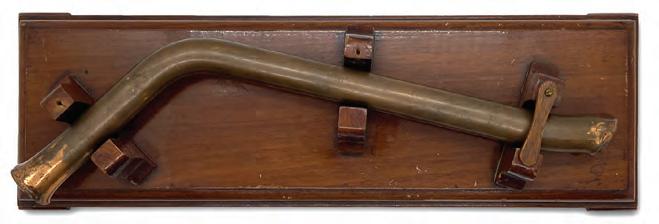
CELEBRATORY SITE
Stacey Tope, executive director of the Love Hope Center for the Arts (right), installs the new sign with Jason Shaffer, Operations Director for Civil War Trails, Inc. The center is at the base of the hill where the soldiers camped as they guarded Fayetteville. Archaeological evidence points to it being the likely location of the Passover ceremony.
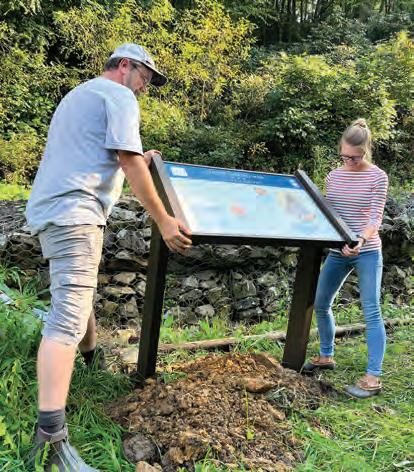
BELOW THE SURFACE
EDMUND JONES had served aboard commercial ships for many years and with the start of the war found himself acting master aboard the gunboat USS Itasca. In January 1862, his ship broke the chain boom blocking the Union fleet from entering the Mississippi River at New Orleans, and he led a band of sailors to reconnoiter that the passage was sufficiently open. He returned to Itasca, and it joined the attacking fleet only to soon become disabled. Hit 14 times, several below the waterline, Itasca was out of the fight. Naval theory indicated that cannon shots could not penetrate more than five feet below the waterline; however Itasca proved that wrong. To emphasize this, Edmund Jones kept a broken copper bolt taken from over eight feet below the waterline which, in time he passed on to his brother Elbert, who had a farm near Waupun, Wis. It remains in that town’s historical society.
SUMMER 2023 CIVIL WAR TIMES 9 COURTESY OF CIVIL WAR TRAILS INC.; COURTESY OF THE WAUPUN HISTORICAL SOCIETY PHOTO BY MELISSA A. WINN
CWTP-230700-MISCELLANY.indd 9 4/4/23 10:18 AM
SIGN, SIGN, EVERYWHERE A SIGN
EARLIER THIS YEAR, members of Historic Gettysburg-Adams County Inc. installed new signs for Civil War hospital sites in areas surrounding the Gettysburg Battlefield, including at the Crist Farm, John Sachs Mill, Shank Farm, Ross Farm, and Sarah Patterson Farm. The signs are manufactured by students in the Gettysburg Area High School’s technology program. Additional signs at other sites will be installed later this spring.
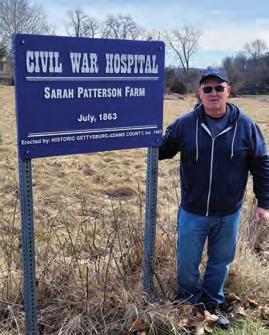
At Manassas National Battlefield Park in March, new wayfinding signs were installed to help visitors better navigate around the battlefield. New gateway signs also let visitors and passersby know they are passing through or by a National Battlefield Park.
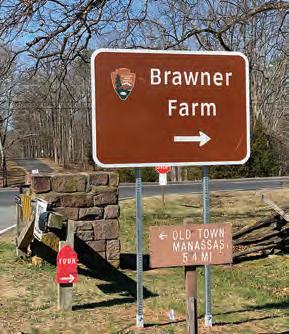
JOHN NAU III HONORED BY ABT
THE AMERICAN BATTLEFIELD TRUST awarded John Liston Nau III with its Lifetime Achievement Award, named him a member of the organization’s board of trustees for life, and renamed its existing national leadership award for federal officials in Nau’s honor. A stone marker with a bronze tablet will also be placed on his beloved Vicksburg Battlefield in Mississippi.

“John Nau is a giant in the field of historic preservation, not only because of his generosity but for his game-changing advocacy on both the federal and state levels,” said ABT President David Duncan. “His efforts have led to the creation of historic parks, the expansion of existing park boundaries, and continued funding for battlefield preservation.”
The Trustee for Life designation has been awarded only twice previously: to Edwin C. Bearss—wounded World War II veteran, historian emeritus of the NPS, and legendary battlefield guide (1923-2020)—and James Lighthizer, who served as president of the Trust for 22 years.

WA R F R AME
CHARLES MORRILL of the 60th New York was proud of his promotion to sergeant on January 11, 1863, and the next month, he had his image taken with his new stripes, including a note slipped behind the photo that indicates when the photo was taken: “Sergt. Charles B. Morrill, Co. D, 60th Regt. NYS, Aquia Creek Landing Va, February 14th, 1863.” Morrill served for three years, and his regiment was one of those in Brig. Gen. George S. Greene’s brigade that held Culp’s Hill at Gettysburg against heavy odds on July 2, 1863. The 60th was in the 12th Corps, which was transferred west after Gettysburg. Morrill fought through the Atlanta Campaign and then received a promotion to lieutenant. He survived his last fight at Bentonville, N.C., on May 19-21, 1865.

10 CIVIL WAR TIMES SUMMER 2023 MISCELLANY COURTESY OF HISTORIC GETTYSBURG ADAMS-COUNTY INC.; PHOTO BY MELISSA A. WINN; SILVER EAGLE DISTRIBUTORS; DANA B. SHOAF COLLECTION JENNIFER GOELLNITZ/AMERICAN BATTLEFIELD TRUST
CWTP-230700-MISCELLANY.indd 10 4/4/23 10:19 AM
ABT Marks Milestone Preservation Victory
After taking possession of 117 acres at Buffington Island, site of the largest Civil War battle in Ohio, the American Battlefield Trust has now protected hallowed ground at half the states in the Union. Founded in 1987 in Virginia, the Trust has saved a total of 56,000 acres across 155 sites in 25 states. Geographically, the organization’s footprint stretches from upstate New York westward to New Mexico, and chronologically from the “shot heard ’round the world” at Lexington and Concord that began the Revolutionary War to the stillness at Appomattox as the Civil War drew to a close.
The Trust first announced its intention to secure the Ohio site, adjacent to the existing Buffington Island Battlefield Memorial Park, in the spring of 2022 with assistance from the Buffington Island Battlefield Preservation Foundation.
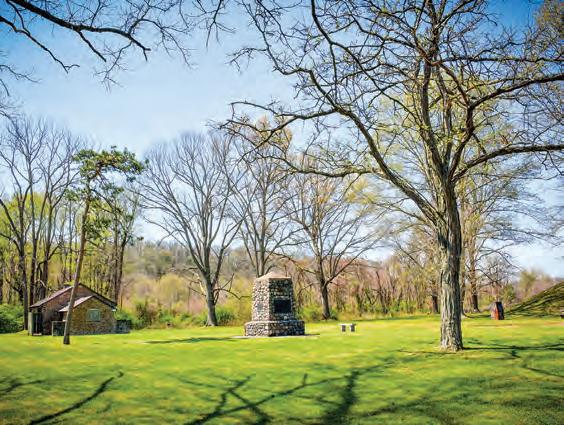
In March, the Trust also announced the protection of 47 acres across the Cedar Creek Battlefield in the Shenandoah Valley and Cedar Mountain Battlefield in the Virginia Piedmont. The land was saved with the assistance of the National Park Service, American Battlefield Protection Program, Shenandoah Valley Battlefields Foundation, Virginia Land Conservation Fund, and Trust donors.
The newly saved and transferred property at Cedar Creek is adjacent to park headquarters and on a central part of the battlefield, once touched by the determined actions of Union and Confederate troops on October 19, 1864, during the boldly executed Battle of Cedar Creek.
Pay it Forward
The Battle of New Market Heights Memorial & Education Association was awarded the Edwin C. Bearss Preservation Award on
ROUGH DAY FOR MORGAN’S RAIDERS
The July 19, 1863, Battle of Buffington Island was a significant defeat for Brig. Gen. John Hunt Morgan during his Confederate raid into Indiana and Ohio. Half his 1,930 men were captured.
February 8, 2023, at the Civil War Round Table of the District of Columbia’s meeting. The award’s grant of $2,500 will go toward educating the public about the U.S. Colored Troops who fought at the Battle of New Market Heights, including 14 Black soldiers and two of their officers who received the Medal of Honor.
On Campaign
Central Virginia Battlefields Trust (CVBT) is campaigning to save acreage that saw action on May 2, 1863, during Lt. Gen. Thomas J. “Stonewall” Jackson’s Chancellorsville flank attack on the Army of the Potomac’s 11th Corps.
Once preserved, the tract will help connect other previously saved Chancellorsville land and allow students of the Civil War to better understand this important part of the battle. The land will also add significantly to the currently available historic “greenspace” of the area where flora and fauna can flourish and people can come to enjoy nature.
The Shenandoah Valley Battlefields Foundation (SVBF) is currently working to preserve 35-acres of the Hupp’s Hill battlefield at Cedar Creek. The land sits between two other parcels that are already preserved and is bordered by Cedar Creek on a third side. SVBF is working to raise $180,000 for the project.
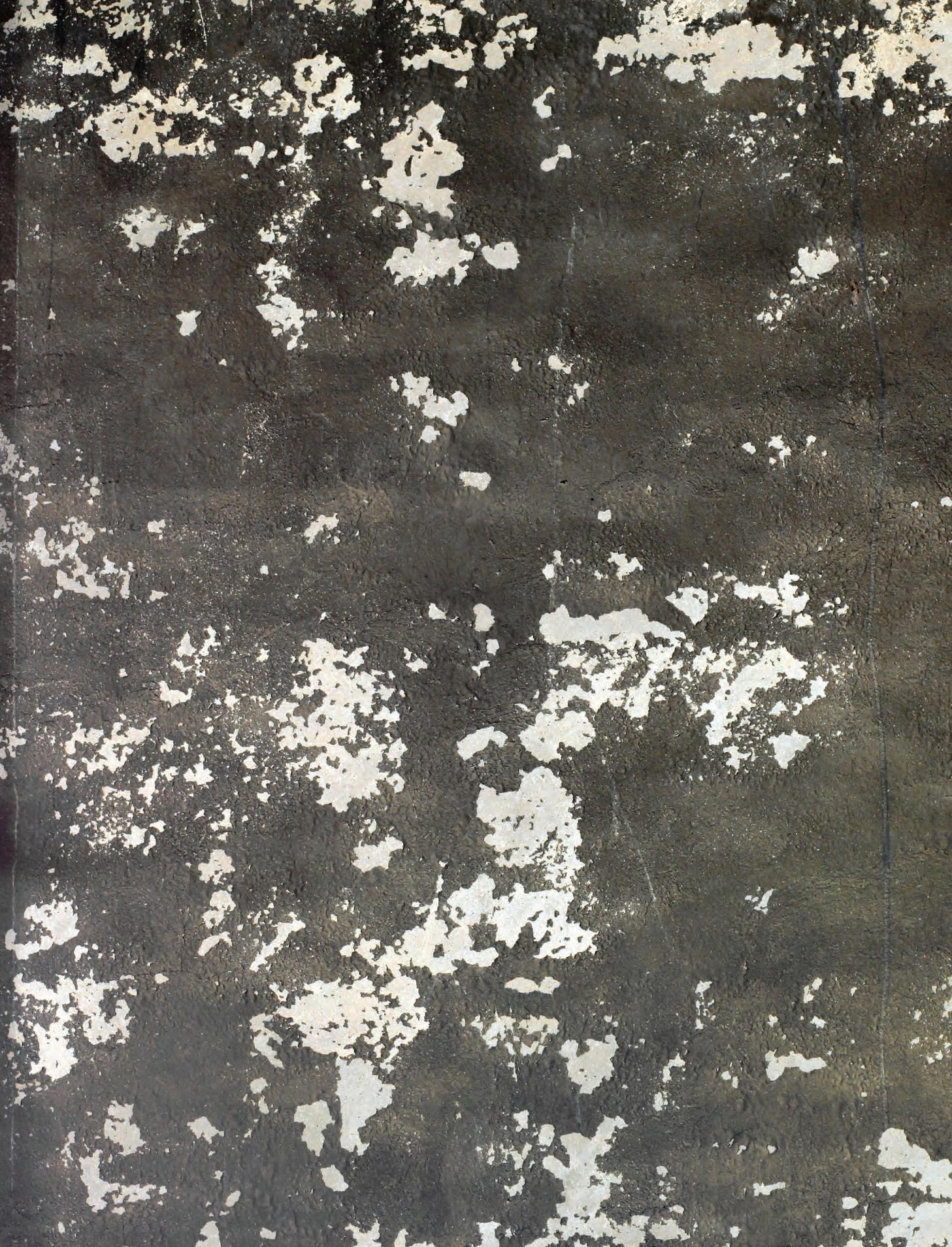
SUMMER 2023 CIVIL WAR TIMES 11 COURTESY OF HISTORIC GETTYSBURG ADAMS-COUNTY INC.; PHOTO BY MELISSA A. WINN; SILVER EAGLE DISTRIBUTORS; DANA B. SHOAF COLLECTION REGISTER JENNIFER GOELLNITZ/AMERICAN BATTLEFIELD TRUST
CWTP-230700-MISCELLANY.indd 11 4/4/23 10:19 AM
WORTH A MOVE
REAL ESTATE WITH CIVIL WAR CONNECTIONS
Always wanted to move to Gettysburg? Want to buy something there in time for the 160th anniversary events? Well, here is your chance to pick up a home built in 1850 located on desirable York Street, house number 162. It just went on the market as we were working on this issue at an affordable $160,000. Well, yes, the house is stripped down to the studs, but a little hard work never hurt a Civil War enthusiast, did it? There is no specific wartime activity attributed to the house, but you can just imagine the soldiers of the Army of the Potomac and the Army of Northern Virginia who marched by the three-bedroom home. You can walk to the battlefield from the house, and Coster Avenue (P. 55) is just a few blocks north. Lincoln Square is right down the street, so after a long day of hammering, wiring, plumbing, or whatever you are trying to get done, you can put down your tools and stagger to a local restaurant or watering hole and have someone wait on you. Don’t be like Richard Ewell, Jubal Early, or Edward “Allegheny” Johnson—or any Confederate you want to blame for failing to capture Cemetery Hill on July 1, 1863. Don’t hesitate to snap up this sweat-equity Civil War home.


QUIZ CLOSE UP !
WHO IS WEARING this ribbon, and what did it represent?

Send your answer to dshoaf@historynet.com, subject heading “Alexandria.”
ANSWER TO LAST ISSUE’S

CLOSE UP !
CONGRATULATIONS to Dennis Urban of Oak Ridge, Tenn., who identified the lead sabot on a Hotchkiss shell. The sabot gripped the rifling in the cannon’s barrel, and rifling grooves can be seen on this fired but unexploded example.
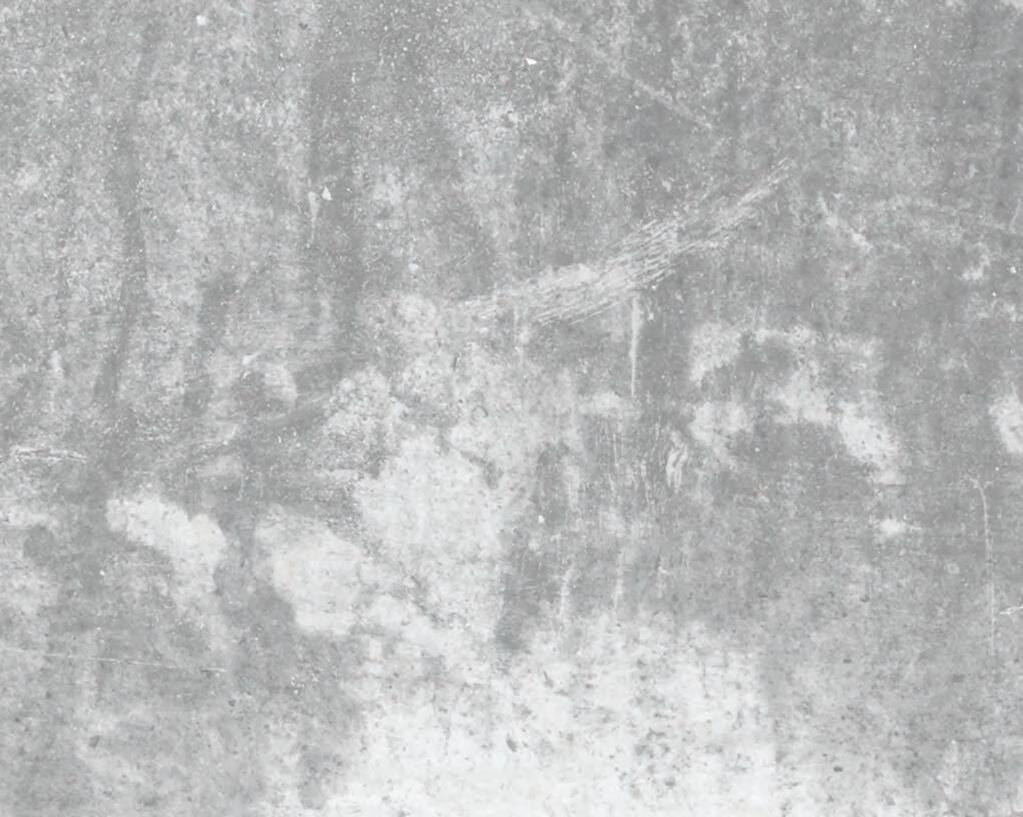
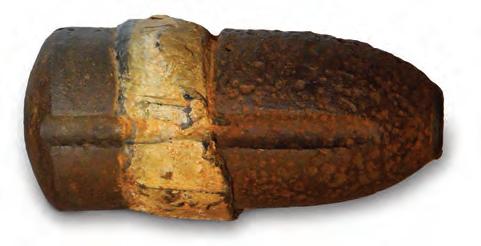
12 CIVIL WAR TIMES SUMMER 2023 CLOCKWISE FROM TOP: THE DAVID MONSOUR GROUP (2); DANA B. SHOAF COLLECTION/PHOTO BY MELISSA A. WINN; LIBRARY OF CONGRESS MISCELLANY
CWTP-230700-MISCELLANY.indd 12 4/4/23 10:19 AM
History, Competition and Camaraderie

The N-SSA is America’s oldest and largest Civil War shooting sports organization. Competitors shoot original or approved reproduction muskets, carbines and revolvers at breakable targets in a timed match. The teams with the lowest cumulative times win medals or other awards. Some units even compete with cannons and mortars. Each team represents a specific Civil War regiment or unit and wears the uniform they wore over 150 years ago.
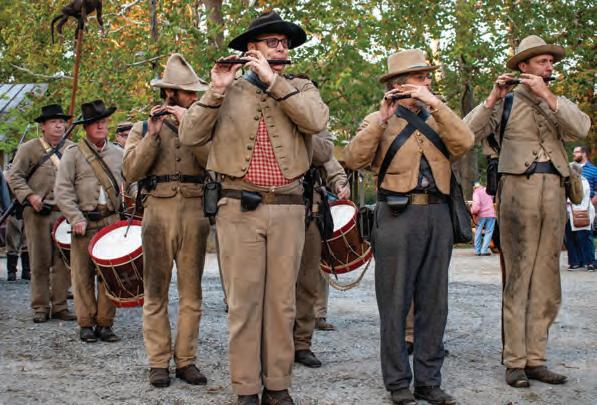


Competitions, called “skirmishes”, are held throughout the year in the association’s 13 regions. Members come from all over the country each spring and fall to national competitions held at the association’s home range, Fort Shenandoah, located just north of Winchester, Virginia. Skirmishing is an inclusive family sport with participation by men, women and young adults. There are even BB gun matches for the youngsters. There are also competitions for authenticity of Civil War period dress, both military and civilian in multiple categories.
Dedicated to preserving our history, period firearms competition and the camaraderie of team sports with friends and family, the N-SSA may be just right for you. If you’re a Civil War enthusiast or black powder shooter ready for our unique experience or are just in search of more information, visit our web site: www.n-ssa.org.
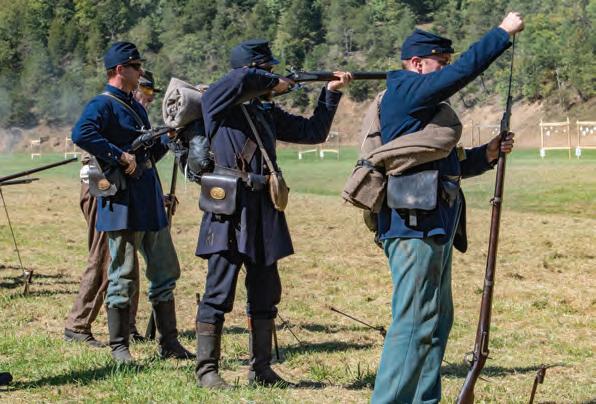
CWT-230516-005 North-South Skirmish Association.indd 1 3/30/2023 1:42:25 PM

CWTP-230700-DETAILS.indd 14 4/4/23 8:24 AM
ROUGH RIDE
THE CIVIL WAR was the first conflict in which large numbers of troops were moved by railroad. That meant it was also the first war in which troops had to suffer uncomfortable, even risky, rides in cramped boxcars, or as in this image, crowded onto flatcars. This photograph was taken in Harpers Ferry, W.Va., and the camera overlooks the Winchester & Potomac Railroad that ran from Winchester, Va., to Harpers Ferry. The W&P, operable in 1836, was a fairly short line of 35 miles with eight stations that connected to the Baltimore & Ohio Railroad at Harpers Ferry. War ravaged the railroad, and it was ripped up and repaired several times during the conflict. The Shenandoah River and the base of Loudoun Heights in Virginia can also be seen. —D.B.S.

1. The photographer would have been high on the bluff above Shenandoah Street, which ran in front of the closest row of buildings. The camera may have even been set up near the famous “Jefferson Rock.” The steeple of Presbyterian Church is visible at the bottom of the image. Just above it, a Union soldier can be seen with a wagon pulled by what may be a mule.

2. A locomotive puffs steam and smoke before heading toward Winchester. Its tender is filled with wood for the steam boiler. Most of the structures in this image are now gone, but CSX and commuter trains still creak and groan over the trestle tracks that remain in the same approximate location.
3. What appears to be a full regiment is precariously perched on top of the flatcars. Private Wilbur Fisk of the 2nd Vermont remembered a flatcar ride on the W&P through a winter storm that was the “essence of misery.” Fisk recalled, “You pull out your woolen blanket and put it over you to keep out a little of the pinching cold, and prevent if possible, your hands and feet from freezing….” The men wear sky-blue overcoats, and the trees are bare, indicating a late fall to early spring timeline. Under extreme magnification, it’s evident most of the troops are staring at the photographer, aware the image is being taken.
4. A few soldiers loiter on the end of a pontoon bridge that crossed the Shenandoah River.
5. The bridge abutments are for a covered bridge that brought the road from the southern bank of the Shenandoah into Harpers Ferry. The bridge was burnt early in the war.
6. A road skirts the base of Loudoun Heights, and a lone house can be seen on the Virginia riverbank. Harpers Ferry was Virginia soil until June 20, 1863, when it became part of the new state of West Virginia. Harpers Ferry was truly on the border of North and South, and Confederate guerrillas such as John Mosby and Elijah White prowled Loudoun Heights.
SUMMER 2023 CIVIL WAR TIMES 15 COURTESY OF THE UNITED STATES MILITARY ACADEMY DETAILS
CWTP-230700-DETAILS.indd 15 4/4/23 8:24 AM
INSIGHT
BY GARY W. GALLAGHER
SCULPTOR FOR THE UNION
A SCULPTURE TITLED
The Council of War occupies a prominent place in my library. Created in 1868 by the artist John Rogers, it depicts a seated Abraham Lincoln holding a large map and flanked by Lt. Gen. U.S. Grant and Secretary of War Edwin M. Stanton. Grant points toward the map with his right index finger while Stanton, cleaning his glasses, looks on. The idea for the grouping came from Stanton, who described a meeting in March 1864 when Grant, “after returning from his first visit to the Army of the Potomac, laid before the President the plan of operations he proposed to adopt.” Robert Todd Lincoln pronounced Rogers’ effort the most lifelike sculpted image of his father, and Stanton expressed similar admiration. Whenever I look at The Council of War, I imagine eavesdropping on three leaders who helped steer the United States toward victory during the war’s final tumultuous year.
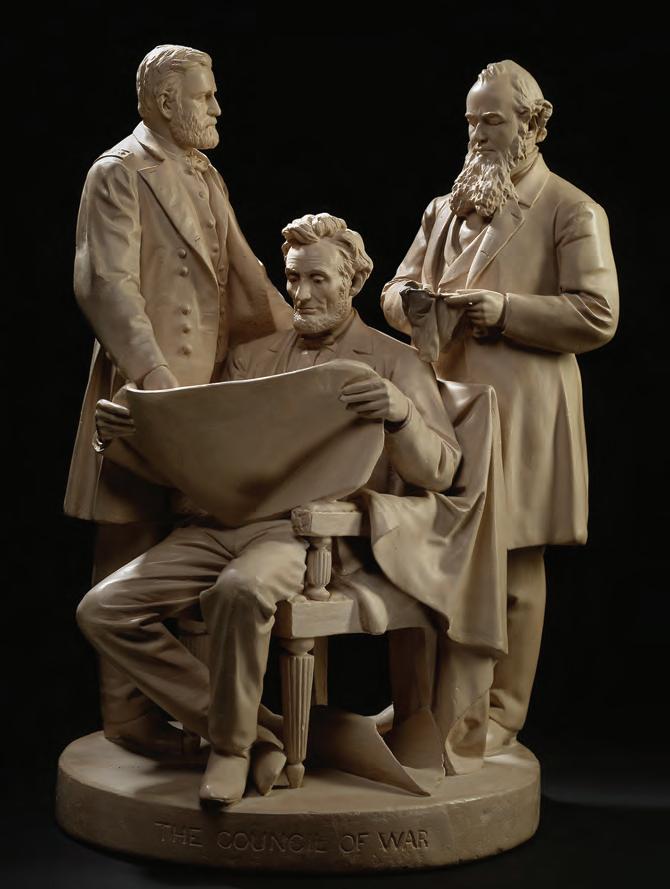
The Massachusetts-born Rogers (1829-1904) created scores of smallscale plaster sculptures for sale at modest cost to a middle-class audience. Between 1859 and the early 1890s, he sold an estimated 80,000 pieces. More than a dozen Civil War–related works reflected the artist’s staunchly pro-Union and pro-emancipation views. Although The Council of War features famous individuals, most of the works focus on common soldiers, civilians, and African Americans—usually in settings that resonated with the loyal citizenry at a fundamental level. A Boston newspaper characterized the wartime pieces as “packed with far reaching and penetrating suggestions of wide spread trials and joys.”
Two works from 1863 deal with correspondence between soldiers and their families and friends at home. Rogers explained the scene in Country Post Office: News From the Army: “An old shoemaker, who is postmaster also, has just opened the mailbag from the army. He is taking a provokingly long time to study out the address of a letter which a young lady by his side recognizes at once as for her.” One reviewer suggested the woman, eager to get her letter, could have been a wife, sister, or lover—which
16 CIVIL WAR TIMES SUMMER 2023
THE NEW YORK HISTORICAL SOCIETY; AGEFOTOSTOCK/ALAMY STOCK PHOTO SMITHSONIAN AMERICAN ART MUSEUM
JOHN ROGERS’ FIGURES BROUGHT THE WAR TO MIDDLE-CLASS MANTELS AND SHELVES
PLANNING VICTORY
CWTP-230700-INSIGHT.indd 16 4/4/23 8:26 AM
Artist John Rogers’ The Council of War captures U.S. Grant, Edwin Stanton, and Abraham Lincoln meditating over military strategy.
meant a wide range of viewers might see in Country Post Office their own personal experience. Mail Day reversed the perspective, offering a soldier with a writing table in his lap and a pensive look on his face. “It is the day for the mail to close,” wrote Rogers, “and a soldier is puzzling his brains so as to complete his letter in time.”
Rogers addressed disparate themes in a pair of works whose titles highlighted the war’s human damage. Wounded Scout: A Friend in the Swamp (1864) reflected his interest in Union combatants and emancipation. The dominant figure is a tall escaped slave who steadies a White soldier with an injured right arm. A political message resides in a copperhead snake that, Rogers observed, raises “its head to strike the negro while he is doing his friendly act.” The artist sent a copy to Abraham Lincoln, who thanked him for the “very pretty and suggestive, and, I should think, excellent...piece of art.” Abolitionist Lydia Mar ia Child thought the sculpture offered “a significant lesson of human brotherhood for all the coming ages.”
Among Rogers’ most popular pieces, Wounded to the Rear, One More Shot (1864) portrays two soldiers, one struck in the arm and the other in the leg. Ordered to leave the firing line, they have stopped to fire a last round at the Rebels. This tribute to Union courage proved a favorite with veterans. For Joseph R. Hawley, a division commander during the war and long-time senator from Connecticut, “Nothing relating to the war in painting or sculpture surpasses ‘One More Shot.’”

Several of the sculptures echo Winslow Homer’s treatments of daily life among Union soldiers. The Camp Fire: Making Friends With the Cook (1862) presents a seated soldier reading from a newspaper to an African American standing over a kettle. The two men’s body language suggests a comfortable familiarity across racial lines. The Town Pump (1862) places an infantryman holding a cup and a woman with a bucket beside a common well, evoking the plight of thirsty soldiers on the march, while Camp Life of the Card
AFFORDABLE ART
Rogers, above, had his figures cast in plaster, making them plentiful and reasonably priced. Some were painted, but most seem to have been left with a more natural finish. The accuracy and drama of “One More Shot,” below, left veterans agape with admiration.
Players (1862) shows two bare-headed Zouaves who have re-purposed a large drum as their playing surface.
Most of Rogers’ audience would have interpreted the Black figures in Wounded Scout and The Camp Fire as contrabands—Civil War parlance for African American refugees. Union Refugees (1863) deals with displaced White Unionists in the Confederacy. The three-person grouping, comprising an obviously exhausted couple and their small boy, received considerable praise when exhibited at the National Academy of Design in 1863.
Rogers devoted his last Civil War–related piece, titled The Fugitive’s Story, to emancipation. It served as an artistic bookend to The Slave Auction (1859), a commercial failure that nonetheless had garnered some national attention for Rogers. As in The Council of War, he chose three major historical figures for The Fugitive’s Story—in this case abolitionists William Lloyd Garrison, John Greenleaf Whittier, and Henry Ward Beecher. Grouped around a desk, the three listen to an African American woman, who holds her child and tells about escaping enslavement. The Independent, a New York weekly Beecher had edited early in the Civil War, reported that Sojourner Truth wept upon seeing Rogers’ treatment of an enslaved mother who had shepherded her child to freedom.
Truth’s response suggests the emotional appeal of Rogers’ sculptures. A photograph of George Armstrong and Elizabeth Bacon Custer at Fort Abraham Lincoln in the early 1870s includes Wounded to the Rear on one end of a small table and Mail Call on the other. Mrs. Custer’s Boots and Saddles (1885) mentioned “two of the Rogers statuettes that we had carried about with us for years....our attachment for those little figures, and the associations connected with them, made us study out a way always to carry them.” Close examination of Rogers’ Civil War sculptures helps illuminate why so many Americans joined Sojourner Truth and the Custers in linking the artist’s work to important elements of the conflict. ✯

SUMMER 2023 CIVIL WAR TIMES 17 THE NEW YORK HISTORICAL SOCIETY; AGEFOTOSTOCK/ALAMY STOCK PHOTO SMITHSONIAN AMERICAN ART MUSEUM
CWTP-230700-INSIGHT.indd 17 4/4/23 8:26 AM
WITH JOHN BANKS RAMBLING
PIPE SMOKE VISIONS
ON A BRISK MORNING, Chuck Byrn and I plop ourselves on a bench that often serves as his refuge from the 21st century. During the Battle of Franklin, Tenn., on November 30, 1864, the ground before us became a hellscape of bloody and broken bodies and shattered lives. A decade ago, two pizza restaurants and other urban schlock stood here. Now it’s a small park thanks to remarkable work by battlefield preservationists.
As two American flags flutter nearby, Byrn and I swap Civil War stories and a few fibs. He’s proud of his Jewish heritage as well as the Algonquin, Cherokee, Creek, Welsh, Scotch Irish, and Spanish in his blood. The 68-year-old Tennessee native—a retired history teacher, Grateful Dead and Doors fan, and docent at the historic Lotz House nearby—is also 100 percent character. I relish character, characters, and beards like Byrn’s milky-white extravaganza.
And Civil War stories, too. Byrn dispenses his in shotgun-like bursts.
In between tokes of house blend whiskey tobacco from his epic, carved Richard Nixon meerschaum pipe, he tells me about another character, Franklin’s own “Miss Annie.” Annie May Gatlin was her full name—her home once stood across Columbia Pike near the Fountain Carter House, vortex of the battle. She liked to remind Byrn that her grandaddy fought at Franklin and Confederate Brig. Gen. Otho F. Strahl died in her backyard.
In the late 1970s, Byrn served as a docent at the Carter farmhouse, which remains a popular battlefield attraction
TOUCH OF GRAY
Grateful Dead fan Chuck Byrn on his favorite Franklin, Tenn., perch, a bench where he contemplates the November 1864 battle that destroyed the Army of Tennessee. Oh, that pipe?
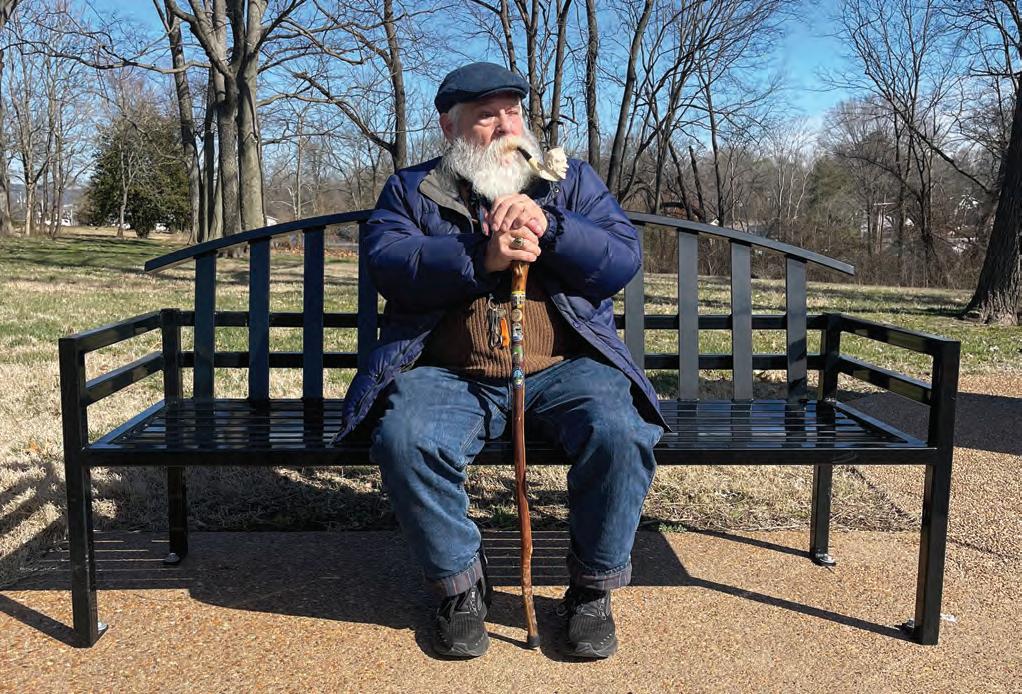
Yes, it’s a bust of Richard Nixon.
BY JOHN BANKS
18 CIVIL WAR TIMES SUMMER 2023
PHOTOS
CWTP-230700-RAMBLING.indd 18 4/5/23 10:22 AM
CHUCK BYRN PAYS HOMAGE TO THE COMMON SOLDIER HEROES OF FRANKLIN, TENN.
today. The bullet-riddled farm office yards away served as the de facto battlefield visitors center. Byrn remembers bullets from the battle filling a large terra cotta bowl there. Before he began his Sunday shift, Byrn would visit “Miss Annie,” who served him mai tais.
“And this woman could pour one,” Byrn says while a cloud of smoke from his pipe drifts into the cool Tennessee air. Good gawd, we all need a “Miss Annie” in our lives.
Besides a mai tai buzz, Byrn’s docent shift sometimes included a surprise or two. A man once beckoned him to his car and opened the trunk, revealing a bayonet wrapped in a near-pristine Goodyear rubber blanket from the war. The edged weapon, the man insisted, lay atop the belly of his 20th Tennessee ancestor, Colonel Bill Shy, who died at the Battle of Nashville. The blanket, he said, wrapped Shy’s body.
“Mind-blowing,” Byrn says.
Byrn recalls another visitor, a man in his late 90s, who said he had lived in the Carter House in the early 1900s.
“We couldn’t walk barefoot out in the yard without stepping on bone fragments and teeth,” the old man told Byrn.
On Friday, Saturday, and Sunday, Byrn works at the Lotz House astride the Columbia Pike. During the battle, the frightened Lotz and Carter families and others huddled in the Carters’ basement while the gates of hell opened outside. In a pivotal moment of the battle, Colonel Emerson Opdycke’s brigade charged past the Lotz House to plug a hole in the U.S. Army line.
About 70 minutes before his shift starts, Byrn readies the Lotz House for visitors. Then, carrying a bacon cheeseburger, coffee, and his ornate cane, he walks the short distance for a respite in the park. Yards away from his bench are foundation stones of the old Carter cotton gin, all that remains from the landmark that stood only yards behind Union lines. After parking himself on the bench, Byrn envisions a beautiful Indian summer day in November 1864.
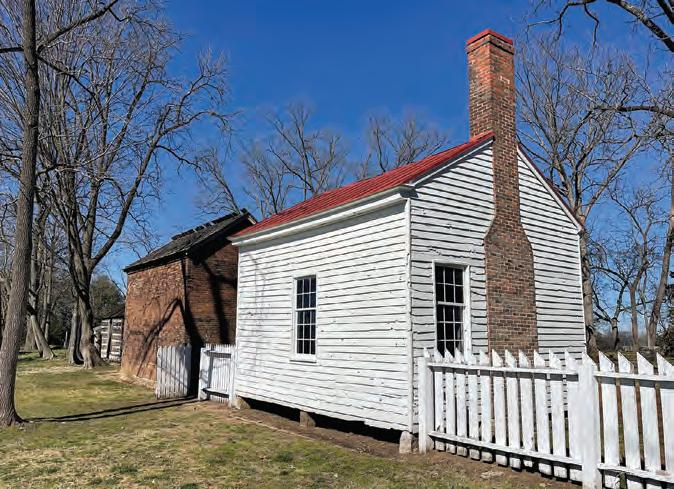
For a few minutes, Byrn blots out the sound of all modern intrusions. Then he imagines the thunderous roar of gunfire
WE BOTH MARVEL AT THE HUMANITY
even smells sweaty horses. We both marvel at the humanity lost in this small park.
LOST
IN THIS SMALL PARK
of this often-overlooked Western Theater battle. The five-hour brawl resulted in roughly 8,500 casualties—2,300 for the U.S. Army, 6,200 for John Bell Hood’s Army of Tennessee. It was one of the rare Civil War battles fought almost entirely at night.
“Thousands of screaming Confederates were rushing toward us right here,” Byrn says, pointing his cane toward a modern, residential neighborhood. Behind their earthworks, Union soldiers five and six deep fired into the charging mass.
Often alone and deep in thought during these park visits, Byrn occasionally hears a strange rustling behind him. But no one’s ever there. Sometimes he
Near us, in front of the 6th Ohio Light Battery position that’s marked today by two cannons, the “ground was literally covered with human bodies,” a 104th Ohio soldier remembered.
Another Union soldier said he “could scarcely walk without stepping on a body.”
Near U.S. Army earthworks, a Union soldier recalled a poor Confederate soldier begging “for the love of Christ” to have a pile of corpses pulled off him.
Another Ohioan recalled the dead “laid in every position imaginable.”
On this cloudless, deep-blue sky morning, a couple walks their dog over the same ground, near a gravel pathway that marks the line of Union earthworks. It is surreal.
If we expand our scope just a little beyond the park, tragic stories lurk everywhere.
To our right, across Columbia Pike, 20th Tennessee officer Tod Carter fell near his boyhood home. The 24-year-
LASTING EVIDENCE OF FURY
The bullet-riddled Carter family office that was within the Union lines testifies to the ferocity of Franklin. “It was impossible to exaggerate the fierce energy with which the Confederate soldiers...threw themselves against the works, fighting with what seemed the very madness of despair,” recalled a Federal soldier.
SUMMER 2023 CIVIL WAR TIMES 19 PHOTOS
BY JOHN BANKS
CWTP-230700-RAMBLING.indd 19 4/5/23 10:22 AM
RAMBLING
WITH JOHN BANKS
old soldier died in the house where he was born.
Across Cleburne Street in front of us, near a monument of faux cannonballs forming a pyramid, Irish-born division commander Patrick Cleburne suffered a mortal wound. Confederate soldiers found the general the next morning, his kepi partly covering his eyes.
In the far distance to our left, in the heart of what today is another modern, residential neighborhood, bullets riddled Brig. Gen. John Adams. He charged the Federals’ line astride his white steed, “Old Charley.” Strahl, Adams, and Cleburne—the “Stonewall of the West”— were three of the six Confederate generals to suffer mortal wounds at Franklin. All of them have streets named after them near where we sit.
Byrn especially admires Tod Carter, Adams, and Cleburne—“good God what balls he had,” he says of the Irishman—but prefers to focus on the “Willies and Joes.” That’s his term for the common soldiers who often reside in the shadows of history.
“I can feel their presence everywhere here,” he says of them.
One of those “Willies and Joes” is Henry Walters Cowman, a private in the 175th Ohio. The bushy-haired Cowman was just a kid, eight months shy of 17, when he enlisted in Septem-

GOOD BOY
Byrn loves Harvey, mascot of the 104th Ohio. The handsome pup, shown on a battlefield marker, survived the fight at Franklin, and so did his master.

ber 1864. He apparently lied about his age. Mom was a widow. Henry’s older brother, John, served with the 2nd Ohio Heavy Artillery.
At Franklin, the 175th Ohio’s first battle of the war, a bullet crashed into Cowman’s right arm —“over where the Bunganut Pig is today,” says Byrn. It’s a popular restaurant/beer joint about 50 yards behind us. Perhaps Cowman suffered the wound in his regiment’s desperate charge to the front.
“I tell you papa, that was a trying time for new men but I thought there was a chance for a new laurel so I started and so did all the rest,” a 175th Ohio soldier recalled of the charge. “Papa, I went mad, I did not think of danger.”
Cowman’s sister helped care for Henry in a hospital in Jeffersonville, Ind., where the teen died from a gangrene infection on January 24, 1865.

Day Elmore of the 36th Illinois is
another of Byrn’s boys. A farmer, he enlisted as a drummer in August 1861. Like Cowman, he was just a kid, only 17 when he joined the army. Elmore stood 5-foot-4 and had dark complexion with brown eyes and brown hair. In a wartime image, he posed with a Colt New Model Revolving rifle that was nearly as tall as he was.
At Chickamauga in September 1863, he suffered a serious lung wound. At Franklin, he suffered another wound, this time fatal. Elmore died a little more than a week after the battle. He was 20.
George W. Heckman of the 104th Ohio was in the fight at the cotton gin. The private is one of Byrn’s guys, too.
Heckman’s son, Walter, served in the U.S. Army during World War I. Decades after the war, he became a liaison for WWI veterans for the VA in Nashville. In 1970, Walter—who grew up in a Grand Army of the Republic orphans’ home—told stories about his dad to Byrn and his mother.
“Brother Heckman,” Byrn calls his fellow Mason.
That’s how close we are to the Civil War.
Before we depart his refuge, Byrn points to a photo on a historical marker. “Don’t forget about him,” he says.
The image is of a bull terrier named Harvey, the beloved mascot of the 104th Ohio—“The Barking Dog Regiment.” The unit had several dogs, raccoons, and at least two squirrels as pets.
Despite the 104th Ohio’s precarious position at Franklin, Harvey somehow survived. So did his master. It was a rare glimmer of sunshine amid the gloom of late November 1864.
“I love Harvey,” Byrn says.
Then, pipe in his mouth and cane in hand, he returns to the Lotz House. For now, Byrn leaves his haven and the spirits of the “Willies and Joes” behind but never forgotten. ✯
John Banks is author of three Civil War books. Check out his latest, A Civil War Road Trip of a Lifetime (Gettysburg Publishing). Banks frequently posts to his Civil War Facebook page, John Banks’ Civil War blog.
20 CIVIL WAR TIMES SUMMER 2023 TOP: HISTORYNET
ARCHIVES (2); BOTTOM: PHOTO BY JOHN BANKS
A “WILLIE” AND A “JOE”
CWTP-230700-RAMBLING.indd 20 4/5/23 10:23 AM
Day Elmore of the 36th Illinois, left, was mortally wounded at Franklin. Henry Cowman was 16 years old when shot in his arm at Franklin. The wound got infected and killed him in 1865.
Only $29!

You would be hard pressed to find a timepiece of this outstanding quality and precision at this price.
It’s Enough to Make You Blue
the Face
You need a new watch…the one you are wearing was made when Nixon was in office, but extravagantly-priced watches that add zeros just because of a high falootin’ name are an insult to your logic. Why shell out big money so some foreign company can sponsor another yacht race? It’s time to put an end to such madness. It’s absolutely possible to have the highest quality, precision classic timepiece without the high and mighty price tag. Case in point: The Stauer Urban Blue. Packed with high-end watch performance and style, minus the high-end price tag. It’s everything a high-end watch should be: Sturdy stainless steel and genuine leather construction. Precision timing that’s accurate to four seconds a day––that’s more precise than a 27-jewel automatic watch priced at over $6,000. And, good looking–– with simple, clean lines and a striking metallic blue face.
“Blue watches are one of the growing style trends seen in the watch world in the past few years”––WatchTime®


Your great escape from the over-priced watch craze. At Stauer, we go directly to the source (cutting out the middleman), and engineer our own watch designs. This means we can offer a top quality timepiece that happens to only cost the same as two well-made cocktails at your favorite bar. So, while we’re busy
revolutionizing the watch industry to bring you more real value, you can take your own stand against overpriced watches with the Urban Blue
Your satisfaction is 100% guaranteed. Wear the Urban Blue for 30 days. If you’re not convinced that you achieved excellence for less, send it back for a refund of the item price. The Urban Blue is one of our fastest sellers. It takes six months to engineer this watch so don’t wait. Take a stand against overpriced watches in impeccable style. Limited to the first 1900 responders to this ad only. Don’t miss out...call today!
Precision movement • Stainless steel caseback and crown • Cotswold™ mineral crystal • Date window •Water resistant to 3 ATM • Genuine leather band fits wrists 6 ¾”–8 ¾” 14101 Southcross Drive W., Ste 155, Dept. UBW555-02 Burnsville, Minnesota 55337 www.stauer.com
Urban
S&P
$170 1-800-333-2045
Stauer
Blue Watch $199† Offer Code Price $29 +
Save
insider
our special
Stauer…Afford the Extraordinary ® Stauer ®
Your Insider Offer Code: UBW555-02 You must use this
offer code to get
price.
Time to take a stand against overpriced watches with the Stauer Urban Blue, now only $29. † Special price only for customers using the offer code versus the price on Stauer. com without your offer code. Rating of A+ êêêêê “Are you kidding? What a great watch at a ridiculous price. Thank you Stauer!” — Gitto, Hicksville NY
in
CWT-230516-002 Stauer-Urban Blue Watch.indd 1 4/12/2023 7:45:31 AM
LIVING HISTORY
HOWARD LAMBERT was maybe 10 or 11 when, while riding his bike near his home in Culpeper, Va., he happened upon a group of Civil War cavalry reenactors engaged in a mock battle in the middle of a field. Lambert had some knowledge of the war living in Culpeper, a still-segregated community in the heart of central Virginia in the 1960s, but the reality of the moment had an immediate effect on him. The reenactors, dressed in both Confederate and Union uniforms, “had guns and were shooting at each other,” he recalled recently. “The smoke was real.”
It would be a watershed moment for Lambert, who recalls reading books about the nation’s eternal struggle that he had, as a teenager, checked out from a local library, as well as occasional glimpses through a car window of the Chancellorsville and Wilderness battlefields as his family drove toward Fredericksburg. He was likewise captivated by the respective Civil War miniseries “North and South” and “The Blue and the Gray,” and in the late 1980s turned a role as an extra in the Oscar-winning film “Glory” into a
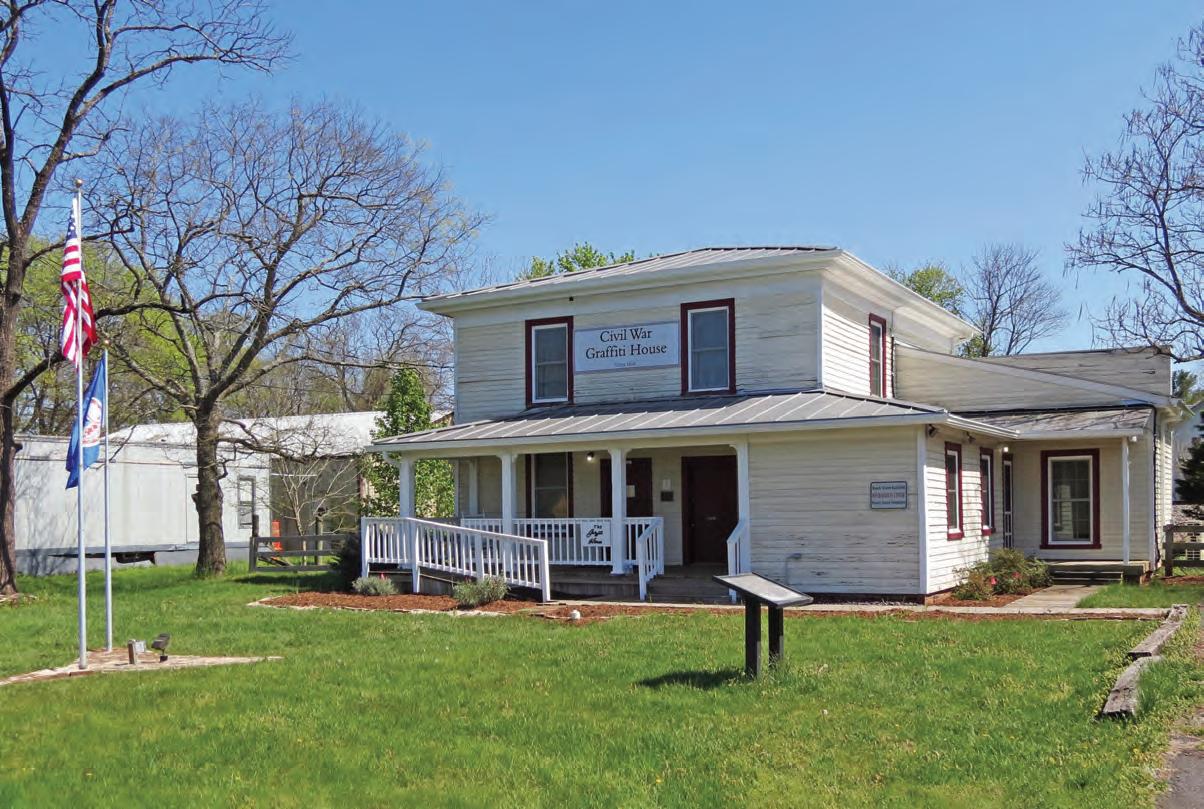
WE WERE HERE
Both Confederates and Federals scribbled in pencil or charcoal on the Graffiti House’s plaster walls, including Confederate Maj. Gen. J.E.B. Stuart and Union Colonel John Egbert Farnum.
reenacting passion of his own.
Now in his late 60s, Lambert’s life continues to revolve around the war. In August 2022, he was named the first African American president of the Brandy Station Foundation, where he is extensively involved in the preservation and remembrance of one of the Civil War’s most important historical sites: Brandy Station—in particular the June 9, 1863, battle there, recognized as the Gettysburg Campaign’s opening clash.

The Civil War, you have said, is in your DNA. Why exactly?
I mean this both figuratively and literally. Born in Culpeper, I was exposed to Civil War history from a very early age. More than 100 battles, skirmishes, and incidents took place on Culpeper soil during the war. During my family’s travels, we would frequently pass by Civil War battlefields, including the Wilderness, Chancellorsville, Spotsylvania, and Brandy Station. I always found them of great interest and was drawn to everything Civil War—“The Blue and the Gray” and “North and
22 CIVIL WAR TIMES SUMMER 2023
INTERVIEW WITH HOWARD LAMBERT
MARK SUMMERFIELD/ALAMY STOCK PHOTO; ALLISON BROPHY CHAMPION PHOTO/CULPEPER STAR-EXPONENT
CWTP-230700-INTERVIEW.indd 22 4/12/23 9:26 AM
South,” for example, and whatever books that I could get to read. But I also have a connection to a Civil War soldier. The brother of my great-great-grandfather, Lewis Turner, served. His name was Fielding Turner. He was born in Culpeper and served in the 20th New York [Infantry]. He returned there after the war.
You were the co-founder of the African American Heritage Alliance and founder of the Freedom Foundation, and now as president of the Brandy Station Foundation you have an incredible opportunity to help preserve the legacy of one of the war’s most important sites. Are you at all in awe of this responsibility?
Not at all. I believe that my many years of experience, both personally and professionally, has prepared me for this moment in time. I embrace each day and never lose sight of the fact that I do this for all men who served during the Civil War. I reflect on them each and every day. As is often said, “All gave some; same gave all.”
What is in the works for Brandy Station’s 160th anniversary in June?
The Foundation has a number of events planned. We are working with Culpeper Battlefield Tours to put on tours, reenactments, living history events, and guest speakers, including acclaimed author Gary W. Gallagher.
What other significant changes are taking place at the site?
My number one priority is the Graffiti House, which dates back to 1858. Both Union and Confederate soldiers stayed there and wrote on the walls. It is a real treasure of historic significance. We have plans to do repairs to the exterior and improve our visitor experience during tours of the interior. In addition, we are making improvements to the grounds.
As you say, the Graffiti House is such an important symbol of the history made at Brandy Station, yet the danger it might be lost to development
and time without intervention remains a threat. What can the Foundation do to make sure that will never happen?
In the short term, we have plans to make improvements to the exterior and also make the tours more dynamic for our visitors through the use of electronic means. Of course, we also have to be aware of what’s happening in the community and the possible impact of that to the Graffiti House. It is important that our voice be heard and engaged in any situation which might
knows more about Brandy Station than anyone and, poignantly, is one of the original triumvirate behind the modern, still-thriving battlefield preservation movement.
I have known Bud for many years and consider him a friend and mentor. As you may know, Bud served in our Armed Forces and is a fellow graduate of American University. He is the first person, to my knowledge, to tell the story of U.S. Colored Troops in Culpeper and as part of the Overland Campaign. I have literally spent hours with Bud traveling to various Civil War sites in Culpeper. He once told me, “It is up to us to tell the story.” Those words served, in part, as my inspiration to form the Freedom Foundation of Virginia (www.freedom foundationva.org).
We first met many years ago at the site of the 1862 Battle of Ox Hill, Virginia, during a gathering to recognize two Union generals killed during the battle, Philip Kearny and Isaac Stevens, and the preservation of what is now a Fairfax County Park. I gave testimony before the Fairfax Board [of Supervisors] to preserve the site and was an early member of a group that today is known as the American Battlefield Trust [formerly the APCWS and the Civil War Trust].
potentially impact the Graffiti House and the surrounding area. We have fostered a great relationship with our neighbors and elected officials and look forward to working with them on any future issues and concerns. In addition, as part of the Culpeper Battlefields State Park, we continue to look forward to working with the Commonwealth of Virginia on the best ways to maintain the Graffiti House and to enhance the overall experience our visitors receive. We are always looking for volunteers to help us in our mission. Volunteer help is so critical to our success.
Tell us about your deep friendship with Clark “Bud” Hall, who probably
I am still working with Bud on several projects and in bringing greater recognition to the USCTs.
What inspired you to become a reenactor? In your experience, how much has this “pasttime” changed from when you started to now?
It was the movie “Glory.” I had read an article in The Washington Post about the Battle of Antietam. In the article, the reporter interviewed Civil War expert Brian Pohanka. Brian mentioned in the article that he was involved in a project about the 54th Massachusetts and was recruiting African Americans to portray the historic regiment. I called Brian and joined the group and went off in early 1989 to be in the movie. The group of guys was mostly from the Washington, D.C., area and we
SUMMER 2023 CIVIL WAR TIMES 23
MARK SUMMERFIELD/ALAMY STOCK PHOTO; ALLISON
PHOTO/CULPEPER
BROPHY CHAMPION
STAR-EXPONENT
MY NUMBER ONE PRIORITY IS THE GRAFFITI HOUSE, WHICH DATES BACK TO 1858.
CWTP-230700-INTERVIEW.indd 23 4/12/23 9:26 AM
BOTH UNION AND CONFEDERATE SOLDIERS STAYED THERE AND WROTE ON THE WALLS.
INTERVIEW WITH HOWARD LAMBERT
Sound—he later won another for the 1990 movie “Dances With Wolves.”
The contributions USCT soldiers made to the Wilderness Campaign often get downplayed or overlooked. How are you trying to change that?
SOLEMN TRIBUTE FOR SLAIN USCT SOLDIERS
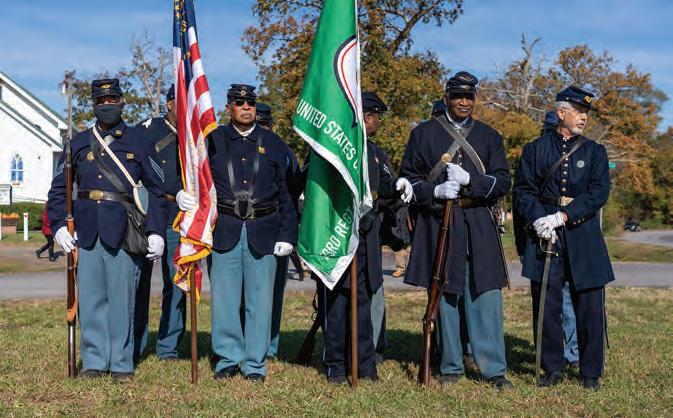
decided to stay together after the movie. Over the years, we literally have done hundreds of events, including several more movies, living history events, reenactments, etc.
What has changed for me is that I have moved from living history events, reenactments, and such to starting or being part of other organizations, including Friends of the Wilderness Battlefield; the 23rd USCT; the Freedom Foundation of Virginia [as founder and president]; the John Brown Farm advisory board; and the Brandy Station Foundation, as a longtime member before I became president.
While working on “Glory,” could you tell it would have the incredible influence it has had in informing mass audiences of the contributions of Black soldiers to the Civil War?
Frankly, I did not at the time think it would have the lasting influence over the years. I was a communications major in college (radio, television, and film) and looked forward to the opportunity of being in a feature film. I knew that the story of the 54th would be compelling and should be told, but I never thought it would end with five Oscar nominations (it won three) and
educate thousands of students on African Americans’ service during the war. Over the years, I have spoken countless times to organizations regarding the role of USCT soldiers during the war.
How much screen time did you manage? Can we find you in a freeze frame at some point?
I took part in three weeks of filming and was part of the James Island (Savannah, Ga.) and Fort Wagner (Jekyll Island) filming. I was in various scenes with the principal actors. If you did a freeze frame for a split second, I can barely be seen when Kevin Jarr says, “Give them hell 54th,” and when Matthew Broderick says before attacking Fort Wagner, “If this man should fall, who will pick up the flag and carry it forward?” It was an ensemble cast. Most of the screen time—rightfully so—was on Matthew, Morgan, Denzel, and the other up-and-coming actors. I would also like to add, the movie won an Oscar for Best Sound. It was our group that was used for much of what was called the “Wild Track” of soldiers marching and such at the polo field at Jekyll Island. Russell Williams II, a fellow American University graduate, received his first Oscar for Best
I am a member of the 23rd USCT which, as you are aware, saw action in the Wilderness Campaign. Ed Gantt is the president of the 23rd and a member of the Freedom Foundation. The two groups work closely together supporting various events. In fact, for the first time, the 23rd USCT will be doing a living history event at the Graffiti House in early May. More Culpeper-born USCTs served in the 23rd than any other regiment during the Civil War: 12. We try to tell the story of the 23rd at every opportunity. The 23rd has a full calendar of events, and we are pleased to host them at the Graffiti House.
Madden’s Tavern, on May 8, 1864, was a tragic moment in Culpeper’s Civil War History. You led a drive to have a marker placed there—the Maddensville Historic Site—in 2021. Tell us more about that effort. The project was years in the making. I have known the Madden family for many years. It was after reading the book “Seasons of War” by Dan Sutherland that I learned of the killing of USCTs near Madden’s Tavern. I later went to the Library of Virginia and looked at the actual diary of Byrd Charles Willis, 9th Virginia Cavalry, in which he writes about killing USCTs that May. I felt lead to bring recognition to this incident by putting up a memorial in their honor. I was able to work with the Madden family and later with the current owners [Crystal and George Tingler] to secure the land and create the memorial site. Of course, there were many other individuals who helped make it a reality. A marker to honor these individuals is scheduled to be in place by this Memorial Day. ✯
Interview by Senior Editor Christopher K. Howland.
24 CIVIL WAR TIMES SUMMER 2023 HUGH KENNY/PIEDMONT ENVIRONMENTAL COUNCIL
CWTP-230700-INTERVIEW.indd 24 4/13/23 11:06 AM
Reenactors representing the 23rd USCT, among them the Rev. Hashmel Turner (U.S. flag in hand) and Ed Gantt (second from right), present the colors during the Maddensville Historic Site’s dedication ceremony on November 6, 2021.
5 Countries, 5 Pure Silver Coins!

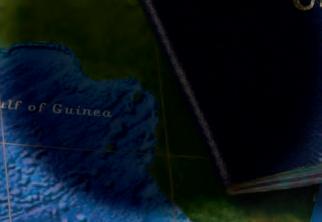
Your Silver Passport to Travel the World

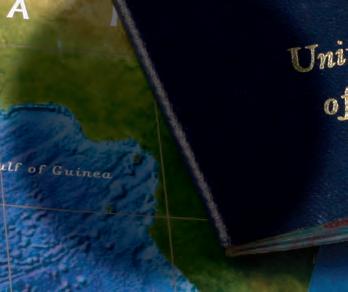

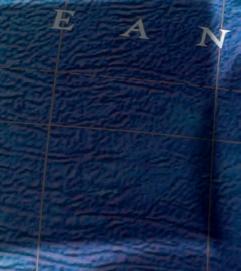




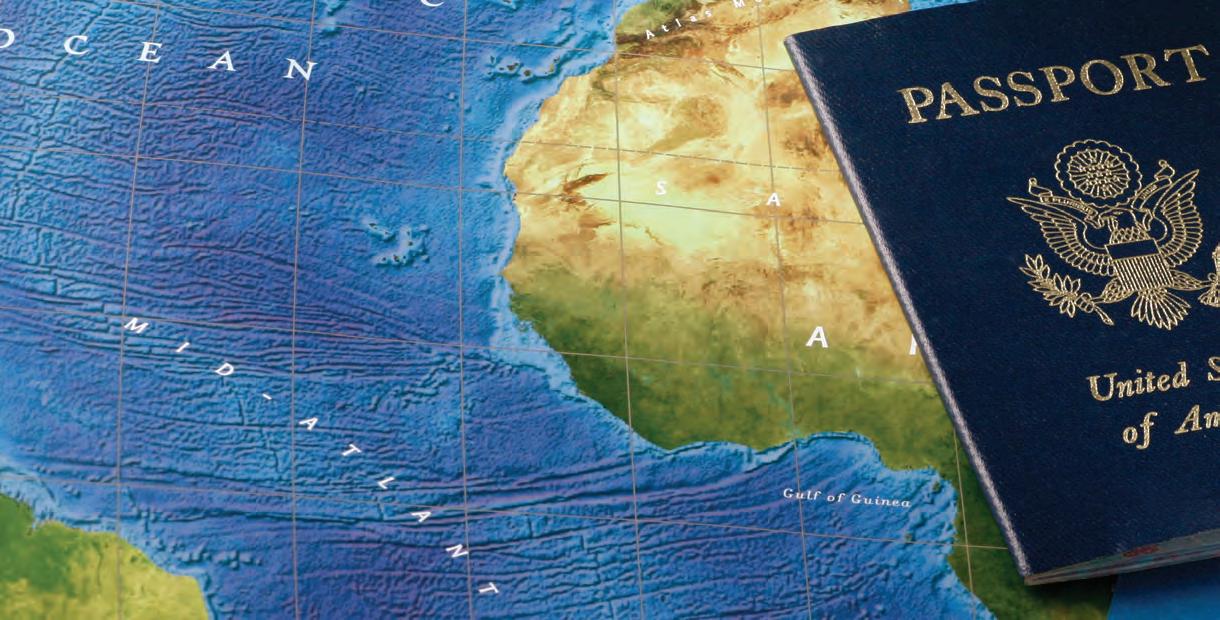
The 5 Most Popular Pure Silver Coins on Earth in One Set





Travel the globe, without leaving home—with this set of the world’s ve most popular pure silver coins. Newly struck for 2023 in one ounce of ne silver, each coin will arrive in Brilliant Uncirculated (BU) condition. Your excursion includes stops in the United States, Canada, South Africa, China and Great Britain.
We’ve Done the Work for You with this Extraordinary 5-Pc. World Silver Coin Set
Each of these coins is recognized for its breathtaking beauty, and for its stability even in unstable times, since each coin is backed by its government for weight, purity and legal-tender value.

2023 American Silver Eagle: The Silver Eagle is the most popular coin in the world, with its iconic Adolph Weinman Walking Liberty obverse backed by Emily Damstra's Eagle Landing reverse. Struck in 99.9% fine silver at the U.S. Mint.





2023 Canada Maple Leaf: A highly sought-after bullion coin since 1988, this 2023 issue includes the FIRST and likely only use of a transitional portrait, of the late Queen Elizabeth II. These are also expected to be the LAST Maple Leafs to bear Her Majesty's effigy. Struck in high-purity




99.99% fine silver at the Royal Canadian Mint.
2023 South African Krugerrand: The Krugerrand continues to be the best-known, most respected numismatic coin brand in the world. 2023 is the Silver Krugerrand's 6th year of issue. Struck in 99.9% fine silver at the South African Mint.

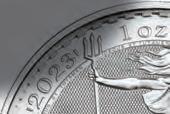



2023 China Silver Panda: 2023 is the 40th anniversary of the first silver Panda coin, issued in 1983. China Pandas are noted for their heart-warming one-year-only designs. Struck in 99.9% fine silver at the China Mint.

2023 British Silver Britannia: One of the Royal Mint's flagship coins, this 2023 issue is the FIRST in the Silver Britannia series to carry the portrait of King Charles III, following the passing of Queen Elizabeth II. Struck in 99.9% fine silver.



Exquisite Designs Struck in Precious Silver




These coins, with stunningly gorgeous finishes and detailed designs that speak to their country of origin, are sure to hold a treasured place in your collection. Plus, they provide you with a unique way to stock up on precious silver. Here’s a legacy you and your family will cherish. Act now!
SAVE with this World Coin Set
You’ll save both time and money on this world coin set with FREE shipping and a BONUS presentation case, plus a new and informative Silver Passport!
BONUS Case!

2023 World Silver 5-Coin Set Regular Price $229 – $199


SAVE $30.00 (over 13%) + FREE SHIPPING







FREE SHIPPING: Standard domestic shipping. Not valid on previous purchases. For fastest service call today toll-free
1-888-201-7070





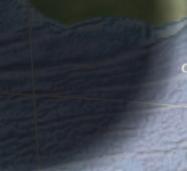















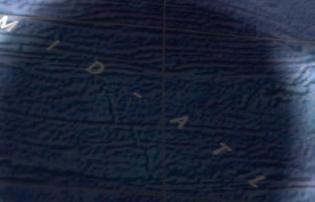














Offer Code WRD282-05












Please mention this code when you call.










SPECIAL CALL-IN ONLY OFFER
Not sold yet? To learn more, place your phone camera here >>> or visit govmint.com/WRD
GovMint.com® is a retail distributor of coin and currency issues and is not a liated with the U.S. government. e collectible coin market is unregulated, highly speculative and involves risk. GovMint.com reserves the right to decline to consummate any sale, within its discretion, including due to pricing errors. Prices, facts, gures and populations deemed accurate as of the date of publication but may change signi cantly over time. All purchases are expressly conditioned upon your acceptance of GovMint.com’s Terms and Conditions (www.govmint.com/terms-conditions or call 1-800-721-0320); to decline, return your purchase pursuant to GovMint.com’s Return Policy. © 2023 GovMint.com. All rights reserved.
GovMint.com • 1300 Corporate Center Curve, Dept. WRD282-05, Eagan, MN 55121
CWT-230516-006 GovMint 2023 World Silver Coin Set.indd 1 3/30/2023 2:45:46 PM
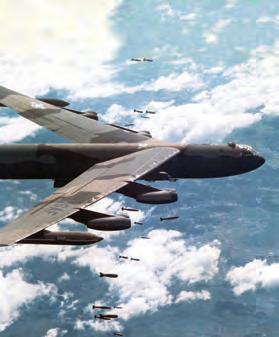

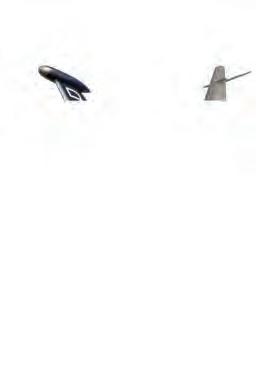
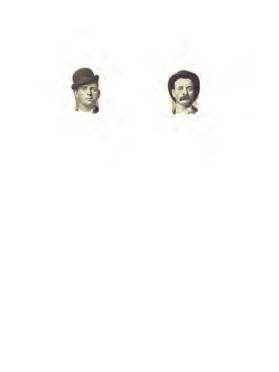


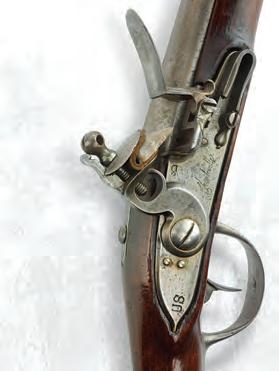
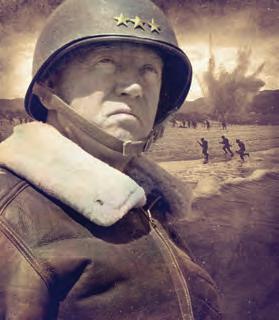

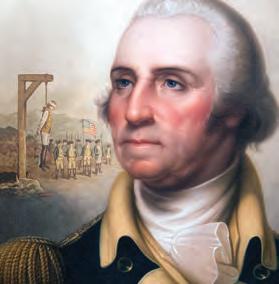

The Day the War Was Lost It might not be the one you think Security Breach Intercepts of U.S. radio chatter threatened lives 50 th ANNIVERSARY LINEBACKER II AMERICA’S LAST SHOT AT THE ENEMY First Woman to Die Tragic Death of CIA’s Barbara Robbins HOMEFRONT the Super Bowl era WINTER 2023 WINTER 2023 Vicksburg Chaos Former teacher tastes combat for the first time Elmer Ellsworth A fresh look at his shocking death Plus! Stalled at the Susquehanna Prelude to Gettysburg Gen. John Brown Gordon’s grand plans go up in flames MAY 2022 In 1775 the Continental Army needed weapons— and fast World War II’s Can-Do City Witness to the White War ARMS RACE THE QUARTERLY JOURNAL OF MILITARY HISTORY WINTER 2022 H H STOR .COM JUDGMENT COMES FOR THE BUTCHER OF BATAAN THE STAR BOXERS WHO FOUGHT A PROXY WAR BETWEEN AMERICA AND GERMANY PATTON’S EDGE THE MEN OF HIS 1ST RANGER BATTALION ENRAGED HIM UNTIL THEY SAVED THE DAY JUNE 2022 JULY 3, 1863: FIRSTHAND ACCOUNT OF CONFEDERATE ASSAULT ON CULP’S HILL H In one week, Robert E. Lee, with James Longstreet and Stonewall Jackson, drove the Army of the Potomac away from Richmond. H THE WAR’S LAST WIDOW TELLS HER STORY H LEE TAKES COMMAND CRUCIAL DECISIONS OF THE 1862 SEVEN DAYS CAMPAIGN 16 April 2021 Ending Slavery for Seafarers Pauli Murray’s Remarkable Life Final Photos of William McKinley An Artist’s Take on Jim Crow “He was more unfortunate than criminal,” George Washington wrote of Benedict Arnold’s co-conspirator. No MercyWashington’s tough call on convicted spy John André HISTORYNET.com February 2022 CHOOSE FROM NINE AWARD - WINNING TITLES Your print subscription includes access to 25,000+ stories on historynet.com—and more! Subscribe Now! HOUSE-9-SUBS AD-11.22.indd 1 12/21/22 9:34 AM
EDITORIAL
BY DANA B. SHOAF
QUIET ON THE SET!
THE MOVIE GETTYSBURG WAS RELEASED 30 YEARS AGO. BUT FOR CWT ’S EDITOR, THE ADVENTURE BEGAN THE PREVIOUS YEAR.
WHAT
AN EXPERIENCE.
In the summer of 1992, I threw all of my reenacting gear into my beat-up 1980-something Chevy S-10 pickup, and headed east down the Pennsylvania Turnpike to Gettysburg. I was exultant. I was going to go be a paid background extra for the movie “Gettysburg.” I had heard earlier that year the filming would take place that summer, and I sent in a letter of application to the production company along with a picture of me in my “kit.” They wanted guys who could do both Union and Confederate, and I remember saying something in the letter along the lines of “I could whistle Dixie and sing the Battle Cry of Freedom with equal fervor.” I can’t whistle very well and I can’t carry a tune in a bucket, but, oh well, I got the gig.
I was supposed to be there a week, but it turned into a month-plus after I got hired into the “core group” of 100 reenactors. It was early morning set calls, late nights at bars, and stories upon tales upon stories. I lived for two weeks in a tent with Rob Hodge (see Confederates in the Attic) and then we got an apartment in Gettysburg paid for by the movie company. Incredible.
From July 1 scenes to Pickett’s Charge, I was there for it all. And I had a close up. I’m in the scene just before Pickett’s Charge when Armistead is telling Fremantle how great we Virginians are. Pause it just right, and my face is the only one on screen. Not that I have done that.
But the best thing was the people. Martin Sheen (Lee) gave me a ride. I gave Patrick Gorman (Hood) a ride. Tom Berenger (Longstreet) wasn’t
exactly friendly on the set, but one day I cracked a joke loud enough for him to hear, and he laughed.
I made lifelong friends. One of those was the late Brian Pohanka. After the movie he helped me get a job with Time-Life that eventually led to me being at the mantle of Civil War Times.
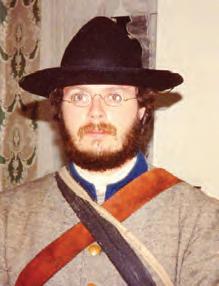
Perhaps the thing that makes me the most happy is that I know a number of young people who got interested in the Civil War because of the movie. I’m proud of that. Last summer, I attended a large living history portraying the 1st Minnesota hosted by the Liberty Rifles on the Gettysburg battlefield. As I walked through the camps and prepared to do some filming for First Mondays, I overhead a young participant say, “That guy with the gray beard was in Gettysburg, he’s an OG.” (OG means an “original”—it’s a good thing.) I have to admit, I got a little charge when I heard that, and my mind went right back to 1992, when my beard was dark, I had a 34-inch waist, and I could go all day on three hours of sleep. Man, what an experience. ✯
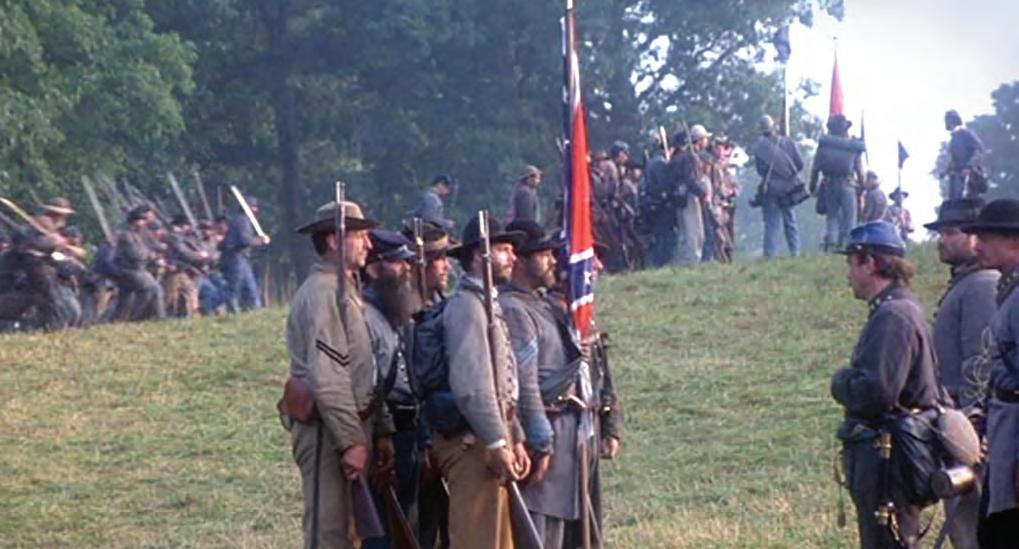
SUMMER 2023 CIVIL WAR TIMES 27
NEW LINE
CINEMA; INSET: PHOTO BY HEIDI
CAMPBELL-SHOAF
ARMISTEAD’S COLOR GUARD
CWTP-230700-EDITORIAL.indd 27 4/4/23 3:07 PM
Would you hire that myopic Reb? That was the application photo I sent in. Below, I’m front rank closest to camera. I still have that hat.
CHARGE TO IMMORTALITY
Colonel Joshua Chamberlain takes a Confederate officer prisoner during the 20th Maine’s pell-mell rush down Little Round Top on July 2, 1863, at Gettysburg. Sergeant Andrew Tozier carries the national banner, his face partially obscured by the artist because there are no known images of the flagbearer. Tozier and Chamberlain would reunite after the war under unusual circumstances.

28 CIVIL WAR TIMES SUMMER 2023
CWTP-230700-TOZIER.indd 28 4/5/23 4:26 PM
ANDREW TOZIER’S BATTLES
THE 20TH MAINE’S LITTLE ROUND TOP HERO HAD A HARDSCRABBLE LIFE
 BY JARED PEATMAN
BY JARED PEATMAN
SUMMER 2023 CIVIL WAR TIMES 29
CWTP-230700-TOZIER.indd 29 4/5/23 4:26 PM
Maine Governor Joshua L. Chamberlain looked at the recommendation for a pardon that his executive council had placed in his hands. As he read the name of the prisoner it concerned, his mind no doubt wandered to a moment from seven years earlier and 500 miles away during the Battle of Gettysburg. That hellish firefight had made his reputation, eventually propelling him to a generalship and later the very gubernatorial seat he now occupied. One image continually returned to Chamberlain’s mind: “Through the mist of the battle could be seen our colors, planted in the ground, and held firmly by our sergeant with musket in his hand. That color-sergeant was Andrew Jackson Tozier, of Plymouth, the man and place well named.” Now that bold and brave flagbearer was imprisoned. What would Governor Chamberlain do?
Born February 11, 1838, Andrew Jackson Tozier was the fifth of seven children of John and Theresa Tozier of Monmouth, Maine. The Toziers’ financial situation was precarious, with just $200 property to their name in 1850. Ten years later, they were designated “paupers.” Older brother Augustus was a sailor, and in 1851 young Andrew followed the same path. Half a century later, Andrew’s wife explained, “He went to sea at the age of thirteen years and followed the life of a sailor continuously [for a decade] accept [sic] short visits to his parents until he enlisted.” Embracing maritime culture, Tozier acquired two tattoos later described as “female on…right arm” and “five pointed star in first interosseous space of right hand.” The second tattoo was likely a nautical star symbolically intended to guide sailors back home.
When the Civil War began, Andrew returned home and enlisted in the 2nd Maine on July 15, 1861, about six weeks after the unit’s formal mustering-in. Not surprising given his worldly experience, height of 6 feet, and tattoos, Tozier stood out, and despite being a later addition to the unit,
A SONG FOR TOZIER
Follow this link to hear Color Sergeant Andrew Tozier’s war story put to music. historynet.com/song-for-tozier
he was promoted to corporal in early 1862.
June 1862 was a watershed month in Tozier’s life as he suffered the trifecta of disease, battle wound, and capture. The 2nd Maine spent much of June building roads and bridges in the swampy eastern approaches to Richmond. It was backbreaking work with severe consequences. William Jones, a member of the 2nd, remembered Tozier “did become disabled by having contracted Disease of heart, brought on by heavy lif ting in building bridges and corduroy roads and exposure to miasma in the Chickahominy swamp.” Remembered William Foss of the 2nd Maine: “Being in the mud and water and hard work he was taken with Heart trouble. He did not go away to the Hospital but staid with the Co. He had fainting spells and would have to be helped to the Doctors tent. He staid with the Co. until the Battle of Gaines’s Mill.”
On June 25, 1862, General Robert E. Lee launched his Virginia offensive known as the Seven Days’ Campaign. At Gaines Mill, on June 27, he sent 58,000 men against the Union lines. Tozier described the day in his pension file: “After Fighting from 10 oclock till after five in the afternoon on June the 27th 1862 at the Battle of Gaines Mill I was wounded through the left Hand & just after was shot on the inside of my left ankle & was taken prisoner the Ball did not go through but lodged & was taken out by a Southern Doctor the next day.”
His mobility limited by the lower leg wound, Tozier was one of 50 men from his unit captured that day. The hand wound was more severe, however—his middle finger requiring amputation at the first joint and those on either side badly damaged. In later years, Tozier’s left arm would measure three-quarters of an inch smaller than his right.
Tozier was confined at Richmond’s Libby Prison on July 13 and then moved to the prison
TOZIER’S RESPONSIBILITY
The 20th Maine’s faded and tattered silk national flag that Tozier defended at Gettysburg is held at the Maine State Museum. The oval canton pattern indicates it was probably made at the U.S. Army’s Philadelphia Depot. At Gettysburg, just over 500 men were in the ranks of the 20th, with 38 killed or mortally wounded, and another 93 wounded.
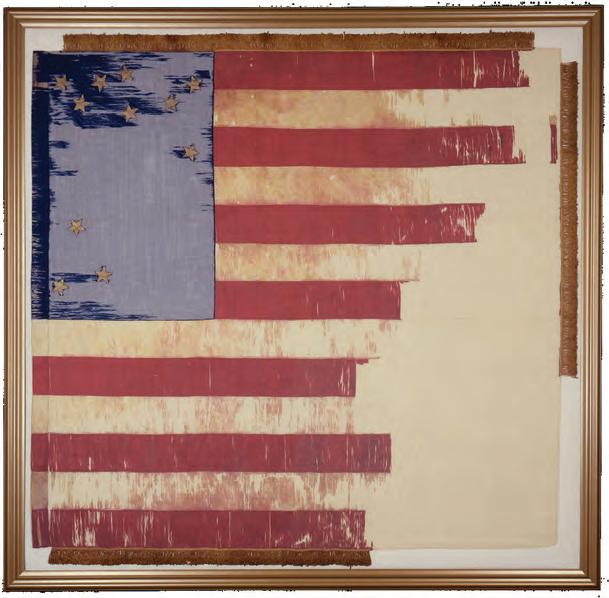
30 CIVIL WAR TIMES SUMMER 2023 LIBRARY OF CONGRESS PREVIOUS SPREAD: ©DON TROIANI/BRIDGEMAN IMAGES; THIS PAGE: COURTESY OF THE MAINE STATE MUSEUM
CWTP-230700-TOZIER.indd 30 4/5/23 4:26 PM
on Belle Isle in the James River. While on Belle Isle, Tozier came across his first cousin, Winfield Norcross of the 7th Maine, who had been wounded at Savage Station on June 29. Despite suffering from chills, fainting spells, and heart problems, Tozier dressed Norcross’ wounds and brought him water. Fortunately, Tozier was exchanged on August 3 and was sent to a hospital in Chester, Pa., to recover, remaining there until late October.
TENT PRISON
A view of the Union prison camp on Belle Isle in the James River. Richmond, Va., is visible on the heights beyond. At Belle Isle, prisoners were housed in tents, vulnerable both to searing heat and freezing temperatures. Tozier was fortunate to be confined there only for two weeks in 1862.

Tozier was promoted to sergeant in late 1862 and then to first sergeant on January 1, 1863. The 2nd Maine had been mustered into state service on May 2, 1861, having signed two-year enlistment contracts as directed by the governor. The Regular Army officer who accepted them for Federal service on May 28, 1861, insisted the men re-sign three-year contracts, though only about 20 percent did so. Later recruits who joined the unit after May 1861, like Andrew Tozier, signed three-year enlistment papers, but many were promised they would be allowed to go home when the 2nd Maine was mustered out in May 1863 at the end of its two years of service.
As spring approached, the men who had signed three-year contracts were anxious about how their situation would play out. The Union Army decided that any “original” members mustered into Federal service on May 28, 1861, regardless of what enlistment period document they had signed, would be allowed to go home. The 120 men who had enlisted after that date, however, would be held to the full three years.
In Andrew Tozier’s case, enlisting six weeks later meant he owed an extra year of service. He and the other men required to stay were sent to the 20th Maine to fulfill their obligation. When the men in that lot were told of
their situation on May 23, many mutinied and refused to go peacefully, necessitating their transfer at bayonet point three days later. Forty men continued to protest even after transferring to the 20th Maine, but the rest—Tozier included— fell into line and appeared at drill on May 27. Tozier immediately caught the eye of the 20th’s relatively new colonel, Joshua Chamberlain, who had taken command of the regiment on May 20. Chamberlain was impressed with Tozier’s “behavior + his soldier bearing + personal efficiency...an example of all that was excellent as a soldier.”
The 20th Maine had been engaged at the December 1862 Battle of Fredericksburg, but the regiment was on guard duty in the rear during the Battle of Chancellorsville because of a smallpox outbreak. In early June, a few weeks after its Chancellorsville victory, the Army of Northern Virginia was on the march, hoping to bring the war north of the Potomac River—pursued by the 20th Maine and the Army of the Potomac.
During his northward march to destiny on a rocky hill, Chamberlain was presented with a perfect opportunity to complete the integration of the former 2nd Maine men into their new unit. Elisha Coan of the 20th’s Color Guard later wrote: “A stronger enemy than rebels got the better of Color Sergeant [Charles] Proctor, as brave a soldier as we had in the 20th by the
SUMMER 2023 CIVIL WAR TIMES 31 LIBRARY OF CONGRESS PREVIOUS SPREAD: ©DON TROIANI/BRIDGEMAN IMAGES; THIS PAGE: COURTESY OF THE MAINE STATE MUSEUM
CWTP-230700-TOZIER.indd 31 4/5/23 4:27 PM
DUAL DUTY
Tozier’s fame, along with that of the entire 20th Maine, was boosted by the movie Gettysburg. This W. Britain figurine depicts him securing his colors and brandishing his musket, as he did on Little Round Top.
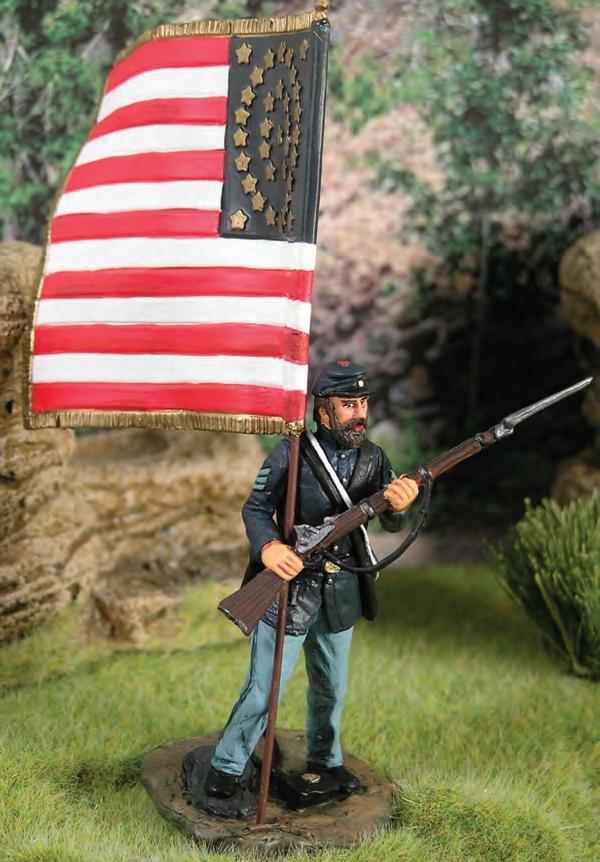
that one of the color guard assigned to protect him, Melville Day, fell dead with five bullets in him, and another, Charles Reed, would be wounded as well.
Later, Reed recounted that after he was wounded, “Sergt. Tozier said ‘Reed you take the colors and let me shoot’ and we exchanged.” Eventually, the severity of Reed’s wounds dictated that he seek aid, so Tozier took back the flag but continued to load and fire Reed’s musket simultaneously. This scene became one of the iconic images of the fight. Years later, Captain Ellis Spear wrote: “What I most distinctly remember there…was the Color Sergeant Tozier, who had picked up a musket dropped by one of the killed or wounded, and with his left arm about the colors, stood loading and firing, and chewing a bit of cartridge paper.”
The 20th Maine expended all of its cartridges. Ordering the unit to fix bayonets and charge, Chamberlain took his place next to Tozier. The surprise maneuver worked, and the Mainers captured 308 prisoners from five Confederate regiments, securing their position and helping keep the critical height of Little Round Top out of Confederate hands.
Tozier had played a significant role in the unit’s performance. “Immediately after the Battle of Gettysburg,” Chamberlain wrote, “[I] offered him a commission for the special gallantry he showed in that battle. He modestly chose to remain color sergeant.”
way—the day we marched through Frederick City Md. on our way to Gettysburg, King Alcohol, and thereby the Colors of the 20th were ‘trailed in the dust ’ for the first and only time that day.” Proctor’s indiscretion cost him his rank and the position of honor as a color bearer.
Chamberlain selected Tozier as the new national flag bearer, partially in recognition of the man’s record, partially due to his belief that Tozier would perform the duty well, and partially a continuation of his efforts to fully integrate the 2nd Maine men into their new unit. No matter the motivation, it was an inspired decision. And then came Gettysburg.
On July 2, the 20th Maine was placed on the extreme left of Colonel Strong Vincent’s 3rd Brigade, which also included the 16th Michigan, 44th New York, and 83rd Pennsylvania. The brigade occupied a position in the saddle between Little and Big Round Top. That meant the 20th was also on the extreme left of the Army of the Potomac. The story is well-known.
During a 90-minute firefight, the Maine regiment repelled six attacks from the numerically superior 15th Alabama. Partway through the fight, Colonel Chamberlain re-fused (bent back) his line to protect the flank, forming his companies into a “V” shape. Holding the colors aloft, Tozier was at the point of that “V”—a position of extreme exposure, so dangerous
In the spring of 1864, many former 2nd Maine men reenlisted for another three years, earning bounties up to $1,000. Tozier, however, did not. Perhaps his physical condition had deteriorated—his assignment to the army’s ambulance corps in late 1863 suggests that possibility. At some point previously he may also have learned of the death of his younger brother, Ezra, in a Confederate prison camp. Between the debacle with the extra year of service, Ezra’s treatment and death, and his own deteriorating condition, Tozier may have desired to get out of the Army.
Before he could return home, however, Tozier would be wounded yet again. On May 26, 1864, at the North Anna River, Tozier “recd a wound from a ball which struck the left side of head 7 inches behind & above the left eye, & part of the ball escaped & part remained in the wound.” This wound, along with the heart troubles, would become his biggest health concern.
Tozier mustered out on July 15, 1864, receiving $100 in bounty money plus $30.43 from his unused clothing allowance. He likely returned home via train, arriving in Maine in late July. In
32 CIVIL WAR TIMES SUMMER 2023 HN ARCHIVES MAINE STATE ARCHIVES
CWTP-230700-TOZIER.indd 32 4/5/23 4:27 PM
May 1863, the original members of the 2nd Maine had returned home to a parade in Bangor, and in June 1865, the 20th Maine received the same treatment in Portland. But Tozier returned home without such closure and with little idea of what to do next. He had made his living through physical labor before the war; now he had a crippled hand and ankle, heart trouble, and a bullet fragment lodged in his skull.
There was some promise. On February 28, 1865, Andrew married 18-year-old Lizzie Bolden, his third cousin. Sometime during that winter, Tozier had the lead fragment removed from his head, but the surgery brought on occa-
SCENE OF THE CRIME
Tozier and his accomplices robbed Michael Larkin’s store, indicated by the yellow circle, in Livermore Falls in September 1865. The town in eastern Maine benefited from the 14-foot-drop waterfall on the Androscoggin River, which created water power for mills and industry.

sional headaches. On May 24, 1865, he applied for a pension, claiming total disability resulting from his heart troubles, crippled hand and ankle, and head wound. The fact that he could not support himself in his current condition surely was a blow.
Lizzie became pregnant sometime around July 4. The couple might have known this by August 18 when the Pension Bureau declared that the thrice-wounded Tozier was “very slightly” disabled and deserved only onethird of a pension amounting to $2.67 a month. This appears to have been the final straw in pushing him toward crime.
The Portland Daily Press of September 1 reported, “HEAVY ROBBERY OF CLOTHING. – The store of Mr. Larkin, at Livermore Falls, was broken into Tuesday night, and clothing of the value of $2000 was stolen. A reward of $200 is offered for the recovery of it.” On the night of August 29, two men broke into Michael Larkin’s store in Livermore Falls and used a stolen cart to carry away 154 coats valued at $1,920. In mid-September, a man named Jerry Riggs was accused of the crime, but the grand jury chose not to bring a bill of indictment for lack of evidence, which proved correct. Four years later, it was determined the robbery was committed by Andrew Tozier and his half-brother, Lewis Cushman.
Immediately after the robbery, Tozier must have realized he would have
SUMMER 2023 CIVIL WAR TIMES 33 HN ARCHIVES MAINE STATE ARCHIVES
CWTP-230700-TOZIER.indd 33 4/5/23 4:27 PM
TOZIER’S FELLOW SUFFERER
Joshua Chamberlain in 1875, when he was president of Bowdoin College, and the last year the Tozier family lived with him. Perhaps one of the reasons Chamberlain sympathized with his color bearer, is that he, too, suffered from numerous wartime injuries. The groin wound he received at Petersburg in 1864 eventually ended his life in 1914.
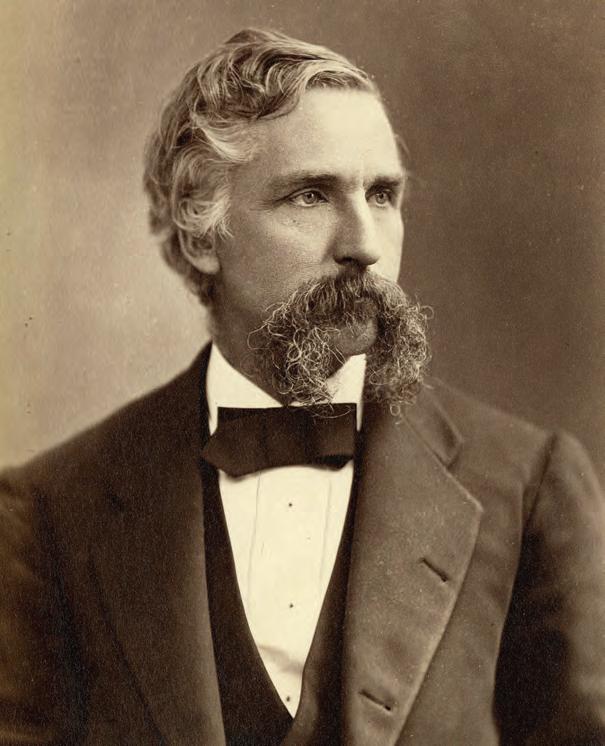
difficulty turning the coats into cash without arousing suspicion, so he hid them at his brother-in-law’s in East Dixmont. Ironically, on December 15, 1865, Joshua Chamberlain gave his first public address on the fight on Little Round Top. Reprinted five days later in the Eastern Argus, Chamberlain’s address brought the name of Andrew Tozier before readers across the state just as the man was desperate to keep a low profile.
In January 1866, Tozier underwent another pension examination, and the examiner noted in the application, “Gen. Chamberlain recommends him highly.” The Toziers welcomed a baby boy named Andrew Jr. on April 4, 1866, and three months later saw a slight pension increase that brought the monthly amount to $4. Tozier struggled during this period, for his doctor observed, “There is evidently considerable cerebral disability,” while another
noted that during a recent examination, Tozier was “so bewildered” that he had to sit down abruptly. By February 1867, the pension was increased to $6 a month, a tiny sum to support a family of three.
Desperate, Tozier again turned to crime. With Cushman and another man named Charles Shorey, he stole six oxen valued at $850 on October 9, 1868. The men drove the cattle 100 miles to be slaughtered in Augusta, but Tozier stopped short of the capital and while the other two men were seeing to the animals’ disposition, they were caught and arrested. The ensuing trial took place in Kennebec County. Both Shorey and Cushman pled guilty and implicated Tozier in the crime. Since Tozier did not enter Kennebec County while engaged in the crime, however, he was dismissed for lack of jurisdiction. This was but a small victory, as he was immediately arrested by authorities from Washington County, the locale from which the cattle had been purloined.
The April 1869 trial in Washington County drew wide attention. Tozier pled not guilty, and accomplice Shorey served as the principal witness for the prosecution—an act for which the State paid him $33.90 for his time and distance traveled. A dozen other witnesses who had seen the three men with the cattle verified Shorey’s testimony. Tozier’s attorney, George Brown, hoped to create reasonable doubt through misidentification, so he placed Andrew’s older brother and near-doppelganger George in the courtroom’s front row, closer to the witness stand than Andrew, and asked one of the younger witnesses to identify the cattle thief.
The trick backfired when the youngster passed over George and pointed to Andrew. Frustrated and perhaps embarrassed, Brown spewed that he “did not care if Tozier was found guilty—Gov. Chamberlain would pardon him.” Indeed, most of Brown’s “defense” of Tozier was a recounting of Andrew’s war record rather than a rebuttal to the evidence of a crime.
Brown had calculated well, for despite clear evidence the jury found Tozier not guilty. Three of the 12 jurors had served in the Civil War, and Foreman Luther Hanscom had a son who served in the 1st Maine Cavalry. Tozier, though, had mere seconds to celebrate his victory before he was arrested by officials from Androscoggin County and charged with robbing Larkin’s store
34 CIVIL WAR TIMES SUMMER 2023 MAINE STATE ARCHIVES; PEJEPSCOT HISTORICAL SOCIETY PEJEPSCOT HISTORICAL SOCIETY
ATTORNEY BROWN SPEWED THAT HE “DID NOT CARE IF TOZIER WAS FOUND GUILTY GOV. CHAMBERLAIN WOULD PARDON HIM.”
CWTP-230700-TOZIER.indd 34 4/13/23 8:35 AM
AT HOME IN MAINE
four years earlier. During his imprisonment and guilty plea, Lewis Cushman admitted to the theft at Larkin’s and identified Tozier as his partner. On May 14, 1869, Tozier was arraigned in Livermore Falls and released on a $1,000 bond to await trial at the next session in September.
The Maine Statutes determined that larceny—a crime committed without the use of violence and without danger to people—exceeding $100 would be punished by at least one but no more than five years in the state prison. Tozier’s sentence was “punishment by confinement to hard labor,” which was both the standard of the day and a ridiculous irony given that Tozier’s inability to labor led to his crime in the first place.
Tozier was incarcerated at the state prison on February 17, 1870, one of 53 men sent to that facility in 1870. Lewis Cushman was already serving a four-year sentence—likely reduced due to his testimony against Tozier. While incarcerated, Tozier worked manufacturing carriages, boots, or shoes, with the sale of those items making the prison economically self-sustaining.
Tozier had served just three months and six days when the executive council recommended the governor pardon his former color sergeant. Throughout his four years as governor, Chamberlain pardoned 59 men, a rate in line with his predecessor and successor. In 1870, Chamberlain pardoned 11 inmates, and Andrew Jackson Tozier would be one of those men.
Chamberlain did far more than pardon Andrew Tozier. Perhaps worried that a pardon offered only a temporary reprieve, he offered Tozier a job and a place to live. By the time the census taker appeared on August 1, 1870, the Toziers were living in Chamberlain’s Brunswick house, with both Andrew and Lizzie identified as “domestic servants.” Pension forms that Tozier filed carried a “Brunswick” heading until 1875, the period of Tozier’s rehabilitation.
By 1875, the Toziers were stable and ready to strike out on their own, and Andrew purchased a 10-acre farm on Great Chebeague Island in Casco Bay, where the family would spend the next 15 years. In 1876, Maine’s Civil War veterans held a grand reunion in Portland with 1,500 men in attendance. There, the 20th Maine formed a regimental association. The association’s minutes noted, “The ‘boys’ spent a short time recalling some of the incidents of the war, after which an invitation was accepted for an hour’s sail in Gen. Chamberlain’s yacht, which was found in charge of Color Sergeant Andrew J. Tozier.”
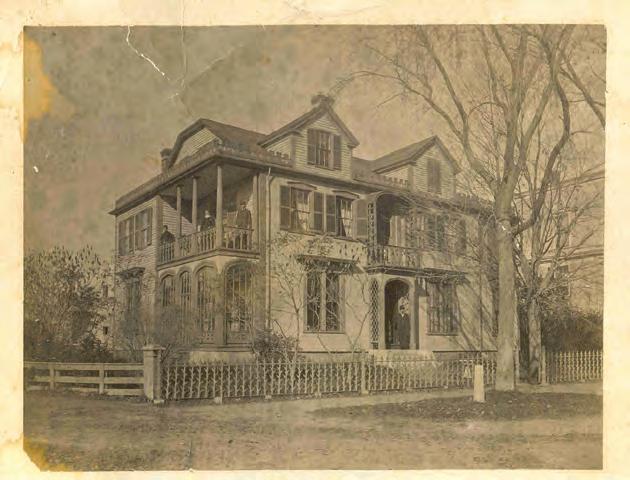
Tozier continued to fight for an increase to a full pension, and Chamberlain was a constant supporter of his efforts, writing in 1878 and 1879 of both his wartime heroism and his postwar struggles: “I know that he has since suffered much from these wounds, especially from that in his head, so much so as to be entirely incapacitated from labor at frequent intervals.”

SUMMER 2023 CIVIL WAR TIMES 35 MAINE STATE ARCHIVES; PEJEPSCOT HISTORICAL SOCIETY PEJEPSCOT HISTORICAL SOCIETY
CWTP-230700-TOZIER.indd 35 4/5/23 4:28 PM
Chamberlain’s yacht, Pinafore, above, was sometimes sailed by Tozier due to his seafaring experience. For five years, 1870–1875, Tozier and his family lived with the Chamberlains in their Brunswick home, right. There is speculation that the Toziers might be in this image.
The examining surgeon concurred, reporting a pulse of 100 and noting, “He is evidently suffering from serious nervous disturbance. The countenance is anxious and expressive of suffering. The eyes are suffused and his memory somewhat defective.” Finally, in late 1878, his rate was increased to $8, the maximum then allowed.
Happiness came to the Tozier family on October 8, 1879, with the birth of a daughter. They named her Grace after Chamberlain’s daughter, further testament to Tozier’s gratitude toward his old commander. The close relationship between the old war heroes is perhaps best illustrated in a letter from Tozier to Chamberlain in late 1880 asking his former colonel to lecture on the Battle of Gettysburg at a church benefit. After the request, Tozier moved on to personal matters:
My family are all well + I am rite smart. I go a winter fishing I have ben out two trips hoping you are all well I remain your Humble Servt
A.J. Tozier
P.S. did you get the yacht up all right?
In 1890, the Toziers moved to Litchfield, where they would be near many family members. Andrew worked at the nearby Plimpton’s Hoe and Fork Factory at light work when his health allowed from 1890 until 1902.
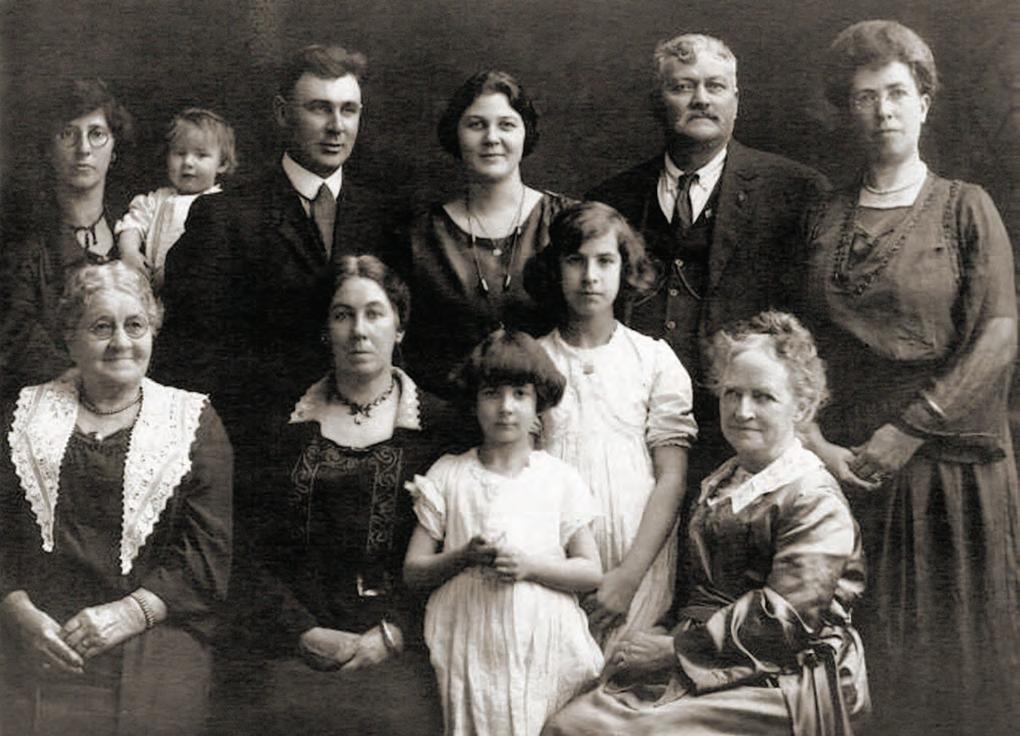
The highlight of Tozier’s postwar life came in 1898 when he received the Congressional Medal of Honor for his actions at Gettysburg. Again, his former commander was behind the recognition. In 1898, Chamberlain
PROUD FAMILY
served on the commission that published Maine at Gettysburg. Chamberlain wrote the 20th Maine’s entry and said of Tozier: “At one moment, it looked as if the colors of the Twentieth Maine must be lost. Buried from sight in smoke, when the black cloud lifted for a moment the colors were seen almost alone. All the Color-Guard and the flanks of the companies on its right and left were cut away; but the Color-Sergeant, Andrew J. Tozier, was standing his ground, the staff planted on the earth, and supported within his left arm, while he had picked up a musket and was defending his colors with bullet, bayonet, and butt, alone!”
Believing Tozier’s actions were worthy of higher recognition, Chamberlain recommended him for the Medal of Honor in 1898. When the medal was issued that August, its citation forever
36 CIVIL WAR TIMES SUMMER 2023
NPS PHOTO; PHOTO BY TOM HUNTINGTON MAINE STATE ARCHIVES
CWTP-230700-TOZIER.indd 36 4/5/23 4:28 PM
A photograph of Andrew Tozier’s family. His wife, Lizzie, is at lower left. Son Andrew Jr. stands second from right, rear row. One wishes Andrew Sr. had sat for such a portrait. Did his namesake son resemble him? The sergeant was known to be tall and thick-shouldered.
enshrined those moments on Little Round Top: “At the crisis of the engagement this soldier, a color bearer, stood alone in an advanced position, the regiment having been borne back, and defended his colors with musket and ammunition picked up at his feet.”
Over the ensuing decade, Tozier’s health declined, and he was often housebound and even bedridden for months at a time. After his house burned down in 1899, Andrew Jr. moved next door to his father, and soon there were three grandsons for Andrew and Lizzie to admire. In Andrew’s later years, Dr. Winfield Norcross, the
HE EARNED IT
The full citation for Tozier’s Medal of Honor reads, “The President of the United States of America, in the name of Congress, takes pleasure in presenting the Medal of Honor to Sergeant Andrew Jackson Tozier, United States Army, for extraordinary heroism on 2 July 1863, while serving with Company I, 20th Maine Infantry, in action at Gettysburg, Pennsylvania. At the crisis of the engagement Sergeant Tozier, a Color Bearer, stood alone in an advanced position, the regiment having been borne back, and defended his colors with musket and ammunition picked up at his feet.” Below, Tozier’s grave in Litchfield Plains Cemetery, Litchfield, Maine.
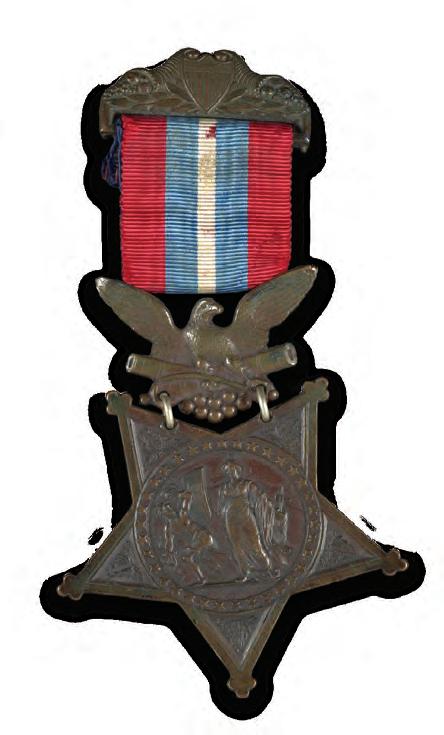
cousin whom he had nursed through their captivity in Richmond, offered him all the care he could. Finally, the heart trouble Tozier contracted in 1862 caught up with him, and he passed away on March 28, 1910.
Andrew Tozier had grown up in challenging circumstances before leaving for the sea at age 13. Shot up and worn down with sickness during the Civil War, he nevertheless answered the call when his new regimental commander asked him to take on the unit’s deadliest position, color bearer. Tozier came through for Chamberlain, both with his quiet example helping to quell the mutiny among the 2nd Maine men and on Little Round Top where he, the old sailor, set an anchor on the rocks at the center of the 20th Maine’s line and helped break wave after wave of Rebel soldiers that rolled toward him. In the postwar years, it was Chamberlain who came through for Tozier, looking past the crimes he had committed to see a warrior in need and then ensuring that his old comrade was on firm footing before he cast off on his own once again. The two Medal of Honor recipients lived divergent lives, but yet were inextricably linked.
Jared Peatman’s Four Score Consulting uses history to examine current leadership and performance challenges. His first book was The Long Shadow of Lincoln’s Gettysburg Address, and he is nearing completion of a book on the 20th Maine.
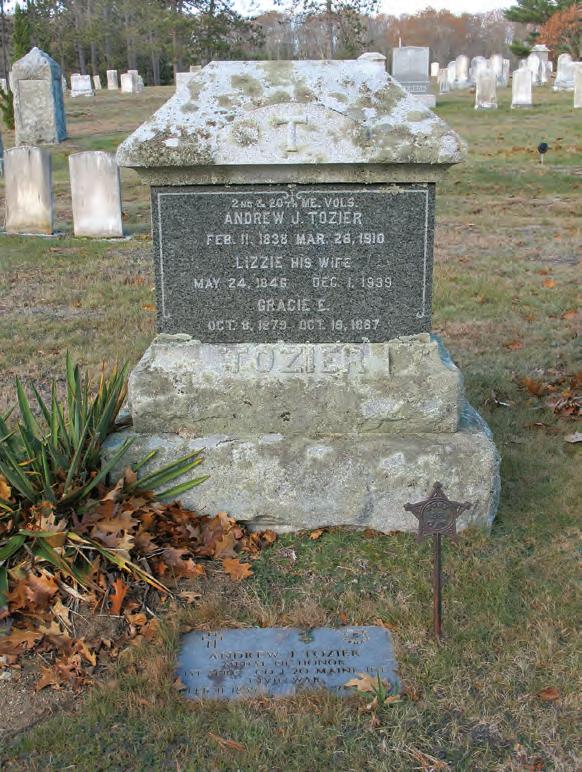
SUMMER 2023 CIVIL WAR TIMES 37
NPS
PHOTO; PHOTO BY TOM HUNTINGTON MAINE STATE ARCHIVES
CWTP-230700-TOZIER.indd 37 4/5/23 4:29 PM
THE HIGHLIGHT OF TOZIER’S POSTWAR LIFE CAME IN 1898 WHEN HE WAS AWARDED THE CONGRESSIONAL MEDAL OF HONOR FOR HIS ACTIONS AT GETTYSBURG
TO FIGHT ANOTHER DAY
SMOKE, WHISTLES, AND WAR
Steamships carry Northern soldiers on the Cumberland River in an engraving from January 1862, the same month as the Battle of Mill Springs.
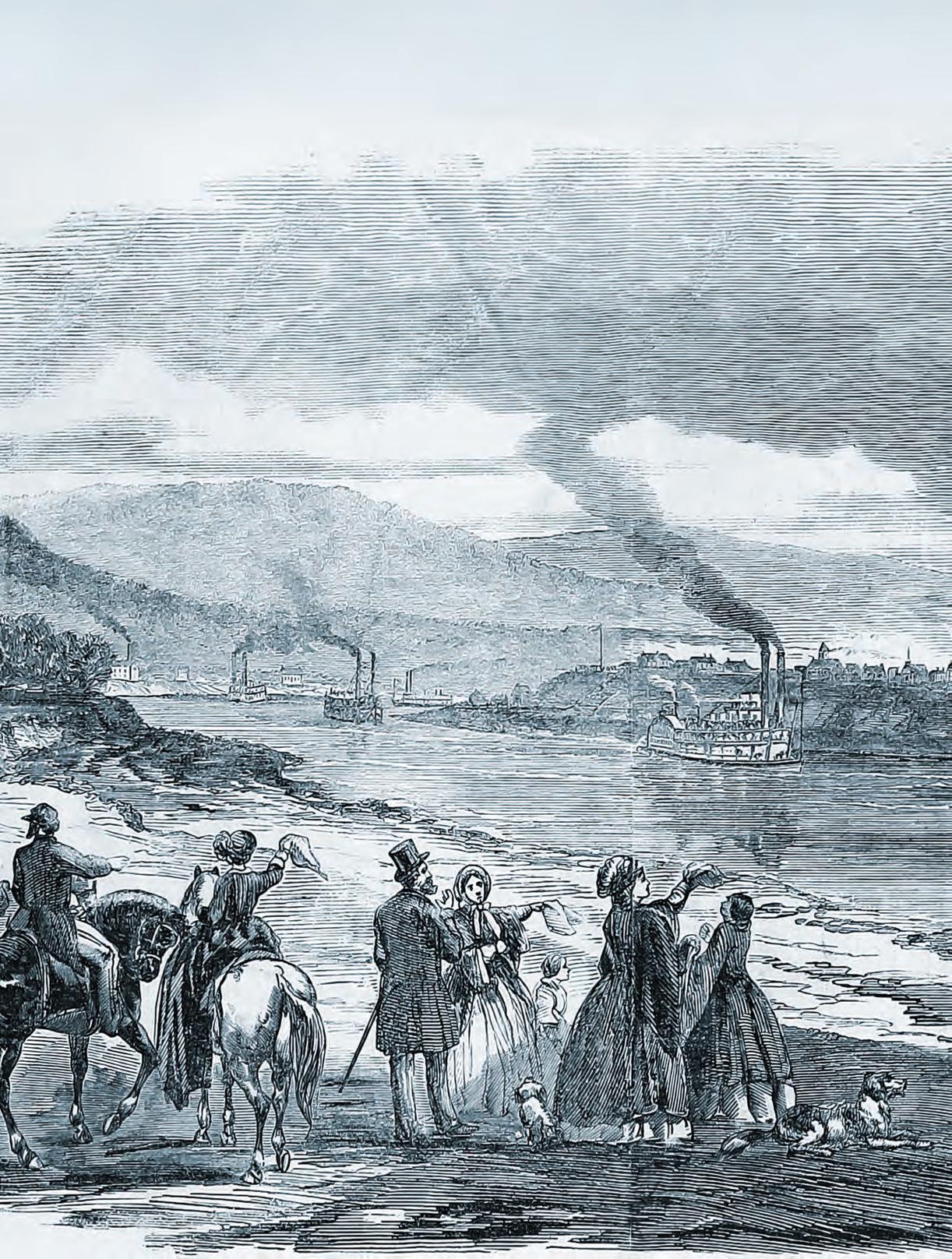
CWTP-230700-STEAMBOAT.indd 38 4/5/23 4:40 PM
Steamboat Noble Ellis saves the Confederate army after the Battle of Mill Springs, Ky.
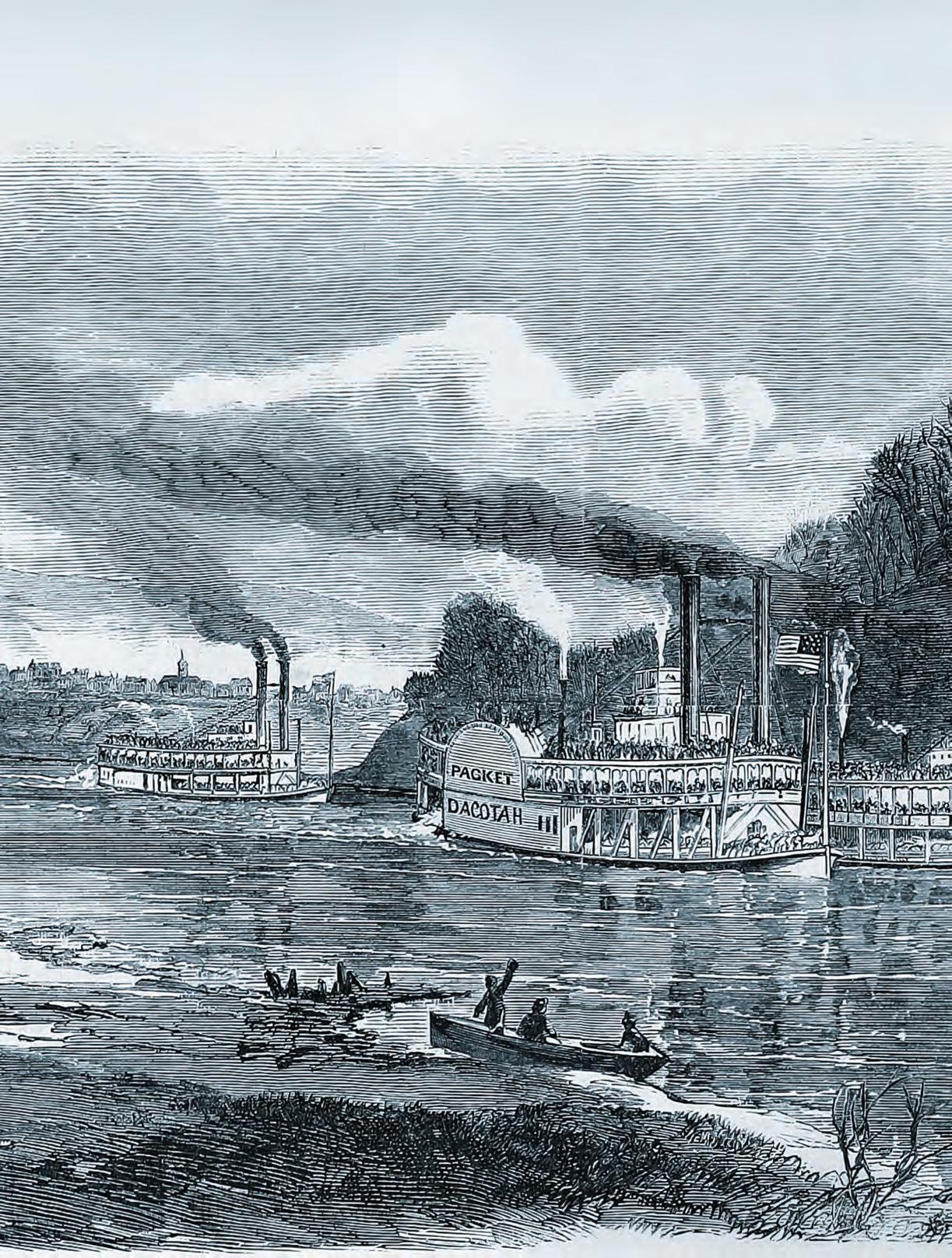 BY STUART W. SANDERS
BY STUART W. SANDERS
SUMMER 2023 CIVIL WAR TIMES 39
CWTP-230700-STEAMBOAT.indd 39 4/5/23 4:41 PM
On January 19, 1862, a Confederate army led by Brig. Gen. George B. Crittenden suffered a disastrous defeat at the Battle of Mill Springs. Fought in south-central Kentucky, the loss shattered the right flank of a defensive line that the Confederate army held across the southern half of the commonwealth. This Federal victory also led to additional military successes and helped consolidate Unionist control of the Bluegrass State at a critical time. Although the Union army sent the Confederates reeling, part of Crittenden’s command survived to fight another day. This was thanks to the small steamboat Noble Ellis, which carried Confederate soldiers across the Cumberland River after the battle. Like many of Crittenden’s troops, however, this vessel became a casualty of war.
That winter, Crittenden’s army was positioned at an entrenched camp at Beech Grove, Ky. Located approximately 20 miles from Somerset on the northern bank of the Cumberland River, the Confederate commander was unhappy with the site. Chosen by another officer, the location of the camp placed the Southerners’ backs against the water. “This river (greatly swollen), with high, muddy banks, was a troublesome barrier in the rear of Beech Grove,” Crittenden complained. “Transportation over it was, at best, very difficult. A small stern-wheel steamboat [the Noble Ellis], unsuited for the transportation of horses, with two flat-boats, were the only means of crossing.” Although Crittenden bemoaned his logistical challenges, these small vessels eventually saved his army.
Crittenden, however, did not have time to redeploy. Union troops led by Brig. Gen. George H. Thomas, who were seeking to drive the Confederates from the region, soon advanced. Realizing it would be disastrous to defend poorly positioned and incomplete earthworks, Crittenden seized the initiative. He would leave camp and strike Thomas before reinforcements reached the Union army.
At midnight on January 18, Crittenden left Beech Grove to attack Thomas at Logan’s Crossroads, a small intersection ten miles to the north.
A FINAL PUSH
It was a harrowing march. Sleet and rain churned the roads into deep mud, and it took the Confederates most of the night to reach their objective. Because of the rain, fog, and the troops’ inexperience, Crittenden kept his plan simple. His troops would advance northward up the Mill Springs road, toward Logan’s Crossroads. When they encountered the enemy, his regiments would deploy on either side of the lane and attack, using the road as their guide.
At daylight on January 19, the Confederate advance encountered Union pickets from the 1st Kentucky Cavalry. After some sporadic gunfire, the loyalist Kentuckians fell back to the 10th Indiana Infantry, who were posted in support a mile up the road.
The poor weather, mud, and limited visibility led to a piecemeal Southern assault. The 19th Tennessee and 15th Mississippi infantry regiments struck the 10th Indiana and the dismounted 1st Kentucky Cavalry near a fence located south of Logan’s Crossroads. After nearly an hour, the 4th Kentucky Infantry (U.S.A.) reinforced the Federal left flank along the fence. There, they battled the Mississippians and the

40 CIVIL WAR TIMES SUMMER 2023 CLOCKWISE FROM TOP LEFT: LIBRARY OF CONGRESS; WORLD OF TRISS/ALAMY STOCK PHOTO; LIBRARY OF CONGRESS PREVIOUS SPREAD: MOUSEOIN ARCHIVES/ALAMY STOCK PHOTO; THIS PAGE: LIBRARY OF CONGRESS
CWTP-230700-STEAMBOAT.indd 40 4/5/23 4:41 PM
Major General George H. Thomas’ troops overwhelm Confederate troops at the Battle of Mill Springs. His victory helped the Union maintain a hold on Eastern Kentucky.
20th Tennessee Infantry. One Union soldier later recalled the severity of the fight, noting that “trees were flecked with bullets, underbrush cut away as with a scythe. Dead and wounded lay along the fence, on the one side the Blue on the other the Gray; enemy dead were everywhere scattered across the open field.”
Fog and lingering black powder smoke hindered visibility and fractured unit cohesion. Moreover, as a steady rain fell, many of the Southerners’ antiquated flintlock muskets became wet and failed to fire. The poor visibility soon had more disastrous consequences. At the height of the action, Confederate Brig. Gen. Felix Zollicoffer, who led half of Crittenden’s army, accidentally wandered too close to the Union lines. Members of the 4th Kentucky Infantry shot him down. Confederate cavalryman R.R. Hancock later said, “the fall of our gallant leader was a desperate blow to the followers.”
Shortly after Zollicoffer’s death, Thomas arrived on the field. The Union commander quickly deployed the 2nd Minnesota at the fence to replace the weary 4th Kentucky. He then sent a brigade of Unionist East Tennesseans and Kentuckians to drive the Confederates out of a ravine on his extreme left flank. The 9th Ohio Infantry, a unit comprised of German immigrants from Cincinnati, then led a bayonet charge that shattered the Confederate left. Soon, other Union soldiers joined the charge, and the Rebel army fled back to their camp on the river. According to one Union colonel, “the whole [Confederate] line gave way in great confusion, and the whole turned into a perfect rout.”
The Federals had approximately 4,000 men on the field while the Rebels had about 5,500 troops. It was reported that the Union army lost 39 killed and 207 wounded, and that the Confederates suffered 125 killed, 308 wounded, and 95 missing.
When Crittenden’s troops straggled back into their entrenchments, it was clear that they were in an untenable position. There were few provisions, and the fortifications were deficient. Furthermore, Union artillery deployed on high ground above the camp and shelled the Confederate works. With disaster looming, Crittenden ordered his men to escape across the swollen Cumberland River.
The attempt would have been impossible were
PUTT, PUTT, PUTT
Not all river steamboats were glamorous, large affairs. No image of Crittenden’s savior Noble Ellis exists, but it would have been a smaller vessel, like this picket boat with an exposed boiler sketched on Florida’s St. John’s River.

A LIFE LOST, A CAREER DAMAGED
Felix Kirk Zollicoffer, left, was killed when he mistook Union troops to be his own men, and rode too close to their lines. Colonel Speed Fry of the 4th Kentucky (U.S.) took credit for shooting him. The defeat at Mill Springs drove Maj. Gen. George Crittenden, right, out of field service.
it not for the small stern-wheeled steamboat, Noble Ellis. Built in 1860, it was named in honor of Noble D. Ellis, a Tennessee politician and co-owner of a Nashville iron foundry that manufactured everything from window sash weights to bank vaults and water wheels. Before the war, Noble Ellis ran a regular route on the Tennessee River, carrying freight between Nashville and Paducah, Ky. Good hauls made the news. In September 1860, for example, the Nashville Republican Banner reported that the Noble Ellis and another steamboat had arrived “from Paducah with a cargo of sundry articles.” Within months, the steamboat saved hundreds of Confederates at Beech Grove.
Fortunately for the Rebels, Crittenden found a capable captain for Noble Ellis. When the Confederate commander gave the order to abandon camp, C.C. Spiller, a member of the 4th Tennessee Cavalry who was also an experienced steamboat pilot, traded his spurs for a steam engine. Spiller hauled scores of soldiers across the river on the Noble Ellis with the two barges in tow. Because it was a small vessel, the army abandoned most of their equipment. Crittenden reported that “Many cavalry horses, artillery horses, mules, wagons, and eleven pieces of artillery, with baggage and camp and
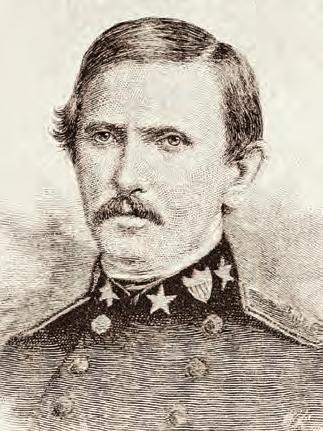

SUMMER 2023 CIVIL WAR TIMES 41 CLOCKWISE FROM TOP LEFT: LIBRARY OF CONGRESS; WORLD OF TRISS/ALAMY STOCK PHOTO; LIBRARY OF CONGRESS PREVIOUS SPREAD: MOUSEOIN ARCHIVES/ALAMY STOCK PHOTO; THIS PAGE: LIBRARY OF CONGRESS
CWTP-230700-STEAMBOAT.indd 41 4/5/23 4:41 PM
garrison equipage were left behind.”
Crittenden, however, was more concerned about the survival of Noble Ellis. When Union artillery shelled the camp, they also fired “a shot or two over the boat.” When darkness fell, the Union gunners ceased fire. They would wait until daylight to destroy the vessel. Crittenden knew that it was imperative for his troops to cross before morning. “The steamboat destroyed, the crossing of the river would have been impossible,” Crittenden explained. Therefore, that night, Noble Ellis rushed to transport the Confederate army across the water.
Within the Rebel works, the scene was chaotic. “We are on the river bank in one compact mass of excited and confused humanity,” a member of the 19th Tennessee related. “Thousands were crowded there waiting, each his turn to get on the Noble Ellis as she crossed and recrossed the river….What a racket and confusion reigned here, and right in the face of the enemy.”
As soldiers crowded on the vessels, dozens of other troops tried to swim across the river. Many were swept away by the fast current. Drowned men were later found downstream, which led Union Colonel Mahlon Manson and several newspapers to report that several hundred Southerners had died in the water. Confederate Brigadier General William H. Carroll confirmed the rumor, noting that as cavalrymen tried to swim their horses across, “many were drowned in the attempt.” Within six hours, however, most of the Rebel command had crossed safely.
When the Union artillerymen returned to their guns at daybreak, Noble Ellis was steaming the last soldiers across the water. The gunners fired smoothbore artillery at the boat, but the shells fell short. They had better luck with two Parrott Rifles. According to the New York Times, one shot went through the vessel’s chimney while another “exploded over the wheel.” Union gunner Joseph Durfee wrote that “we saw a steamer just crossing the river. We fired at her with the Parrott guns, and after firing ten shots, set her on fire….When we shelled her, she was loaded with horses and baggage. The horses jumped overboard, some were saved and some drowned.” A reporter on the scene remarked, “It is uncertain whether the steamboat was fired by our shells or destroyed by the rebels. The conflagration was watched from the hills by our men while ‘bombs bursting in air,’ lent a terrible reality to the scene.”

42 CIVIL WAR TIMES SUMMER 2023 MAP ©DLF GROUP ZACHARY FRANK/ALAMY STOCK PHOTO; LIBRARY OF CONGRESS
CWTP-230700-STEAMBOAT.indd 42 4/13/23 11:05 AM
While multiple Union correspondents said that Federal artillery ignited Noble Ellis, Crittenden later reported that the captain of the vessel had torched the boat. “Much is due to the energy, skill, and courage of Captain Spiller, of the cavalry, who commanded the boat, and continued crossing over with it until fired upon by the enemy in the morning, when he burned it by my directions,” Crittenden wrote. The Confederate commander did not want the steamer to fall into Union hands. At least one Northern soldier understood, writing, “I think it an error about our destroying the steamboat, but that the rebels had crossed and set it on fire on leaving it.”
Upon realizing that Crittenden’s army had escaped, Thomas’ troops entered the camp. They were surprised that the Confederates had abandoned so much property. “The enemy having crossed the river during the night, or early in the morning, the rout was complete,” one witness contended. “It seems as though there was a perfect panic among them, their tents having been left standing, and their blankets, clothes, cooking utensils, letters, papers, etc., all left behind. Here were all, or nearly all of their wagons, some twelve or fifteen hundred horses and mules, harnesses, saddles, sabres, guns; in fact, everything. It was a complete stampede, and by far the most disastrous defeat the Southern Confederacy has yet met with. Ten pieces of cannon, with caissons, are also here. To all appearances, they seem to have completely lost their senses, having only one object in view, and that was to run somewhere and hide themselves.”
GRAY IN THE BLUEGRASS
Many of the Confederate casualties from the Battle of Mill Springs were buried in a mass grave in space now known as Zollicoffer Confederate Cemetery. More would have died without the steamship rescue. A soldier in the 29th Tennessee remembered, “We were on the river bank in a compact mass of excited and confused humanity. Thousands were crowded there waiting, each his turn, to get on the Noble Ellis as she crossed and recrossed the river.”

burned our steamboat, destroyed our boats, and are trying to rally. The Gen. is doing everything to save his command.” That command was fractured, but thousands had been saved thanks to Noble Ellis
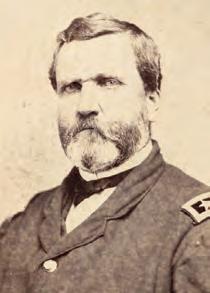
In addition to weapons and animals, the cache included sugar, rice, coffee, bacon, pork, potatoes, soap, candles, letters, watches, and tobacco. Thomas was elated, telling his superiors that “the enemy had abandoned everything and retired during the night.” Colonel Manson added that, “The panic among them was so great that they even left a number of their sick and wounded in a dying state upon the river bank.”
Although Thomas was thrilled to have driven Crittenden away, he regretted his inability to chase the Confederate army. “The steam and ferry boats having been burned by the enemy in their retreat, it was found impossible to cross the river and pursue them,” Thomas reported. Union Colonel John Marshall Harlan of the 10th Kentucky Infantry concurred. Harlan wrote, “Further pursuit was impossible, since the rebels in their retreat had utterly destroyed or removed all means of crossing the river.” The Noble Ellis had saved the Confederate army, and its destruction blunted the Federal pursuit.
Crittenden’s army had escaped, yet they were in a precarious position. One Union soldier wrote his brother that, “I learn one of their steamboats, which was carrying them across the river, was shot into and fired by our artillery, destroying all in it in toto.” He added, “After crossing the river the rebels did not stop, but ran like devils.” The day after the battle, a member of the 15th Mississippi Infantry informed his family that “they whipped us by overwhelming numbers. We
Although the steamboat had ensured Crittenden’s escape, Unionists were still elated. One called the Battle of Mill Springs “a great victory on our side,” while a Unionist Kentuckian said it was “the first blow which breaks the back of this rebellion.” Thanks to the Federal victory at Mill Springs, Confederate troops were ultimately driven from the Bluegrass State. It also began a chain reaction; in February, Fort Henry and Fort Donelson surrendered. Nashville then fell to Union forces. By the end of March 1862, the Confederates had withdrawn to Corinth, Miss. One Union soldier wrote home, “I think we have more than paid them up for Bull Run….Their army is perfectly destroyed and demoralized.” Yet, they would have been annihilated were it not for Noble Ellis
Stuart W. Sanders is the author of four books, including The Battle of Mill Springs, Kentucky His latest, Murder on the Ohio Belle, examines antebellum violence, Southern honor culture, vigilante justice, and the Civil War though the lens of an 1856 murder on a steamboat.
SUMMER 2023 CIVIL WAR TIMES 43 MAP ©DLF GROUP ZACHARY
FRANK/ALAMY STOCK PHOTO; LIBRARY OF CONGRESS
CWTP-230700-STEAMBOAT.indd 43 4/5/23 4:42 PM
Thomas
The war in their words
WAR IN EARNEST
Brig. Gen. Thomas J. Jackson leads his five Virginia regiments into the fury of First Manassas and toward the everlasting nickname “Stonewall” he would share with the brigade. The bloodletting of July 21, 1861, shocked both North and South.
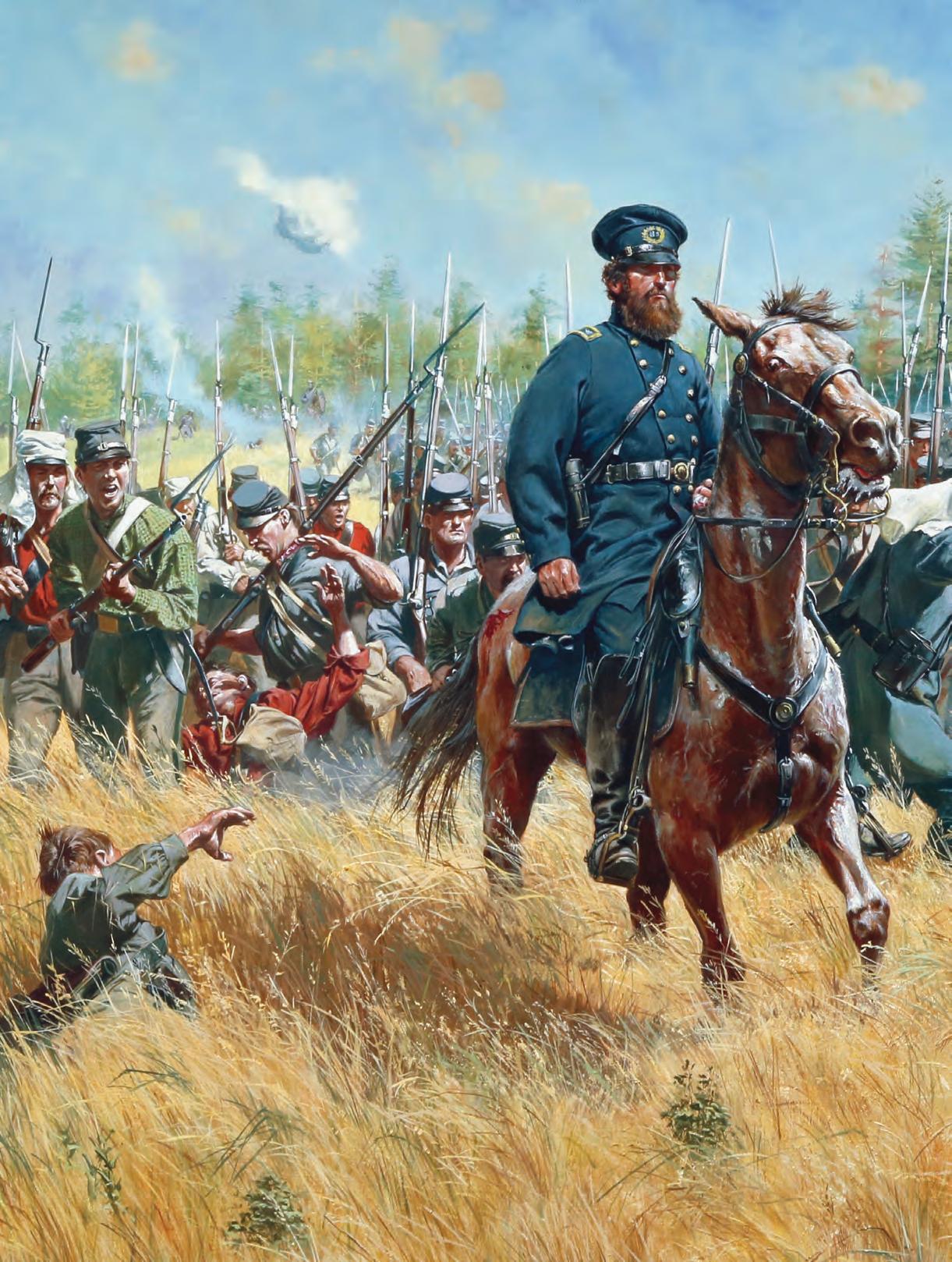
44 CIVIL WAR TIMES SUMMER 2023
CWTP-230700-WITW.indd 44 4/4/23 1:00 PM
WAS THE FIRST WHO FELL’
RAW CONFEDERATE SOLDIERS
“SEE THE ELEPHANT” AT THE FIRST BATTLE OF MANASSAS
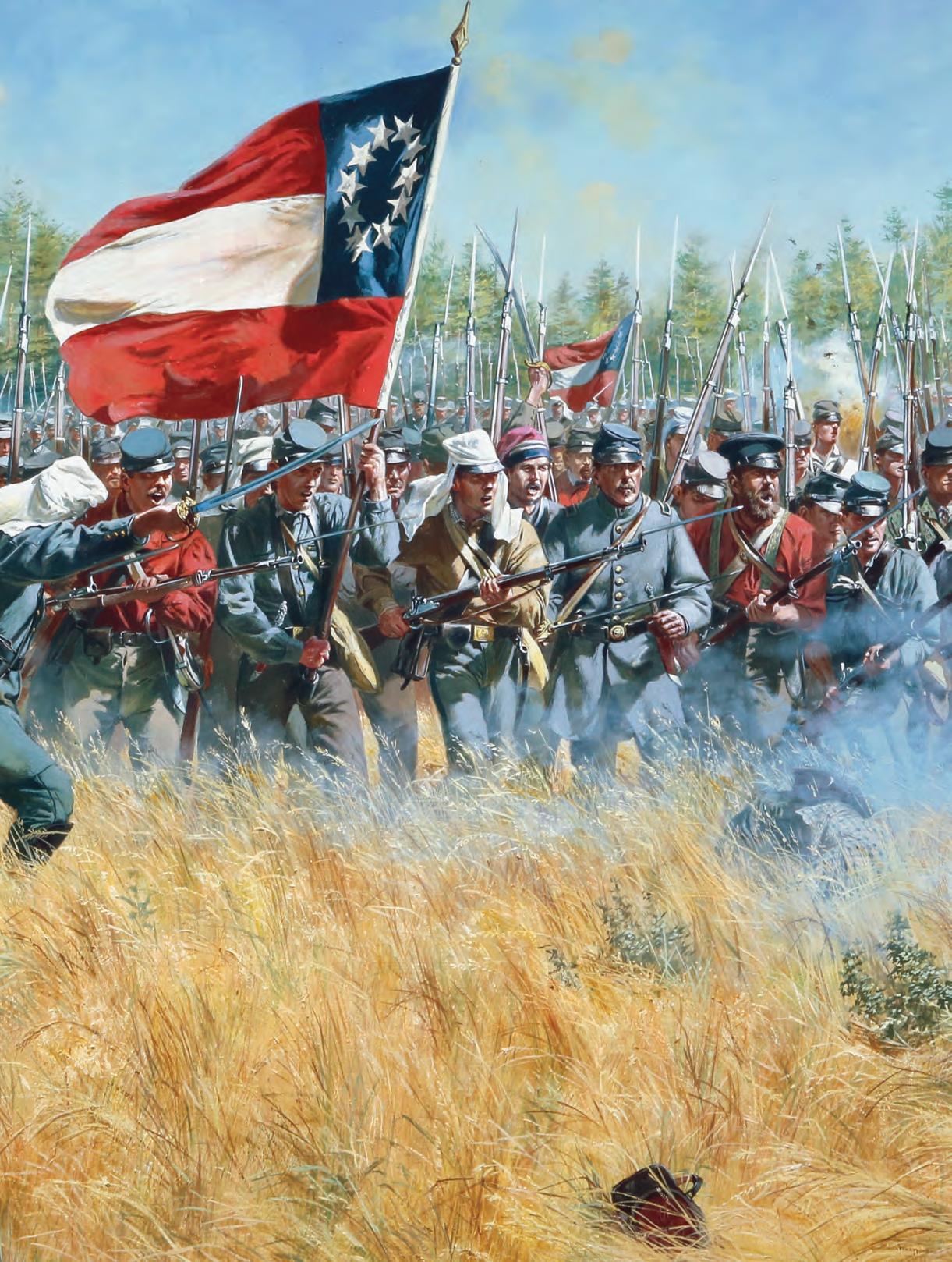 BY HARRY SMELTZER
BY HARRY SMELTZER
©DON TROIANI/BRIDGEMAN IMAGES CWTP-230700-WITW.indd 45 4/4/23 1:01 PM
‘I
The opposing forces that met on the plains of Manassas, Va., on July 21, 1861, had much in common, particularly their lack of experience with the realities of armed conflict. While a few veterans of frontier, Mexican, and foreign conflicts were present, by and large these men were about to get their first glimpse of “The Elephant” of war. After the battle, many set their thoughts down on paper to share with friends and family at home. These fell on a spectrum from vague to specific, from caustic to introspective. Some focused on their immediate experience alone, some on that of their comrades, and some expanded to consideration of what it all meant in a moral or national sense. Following are four examples from inexperienced Confederates who fought on different areas of the field that day.
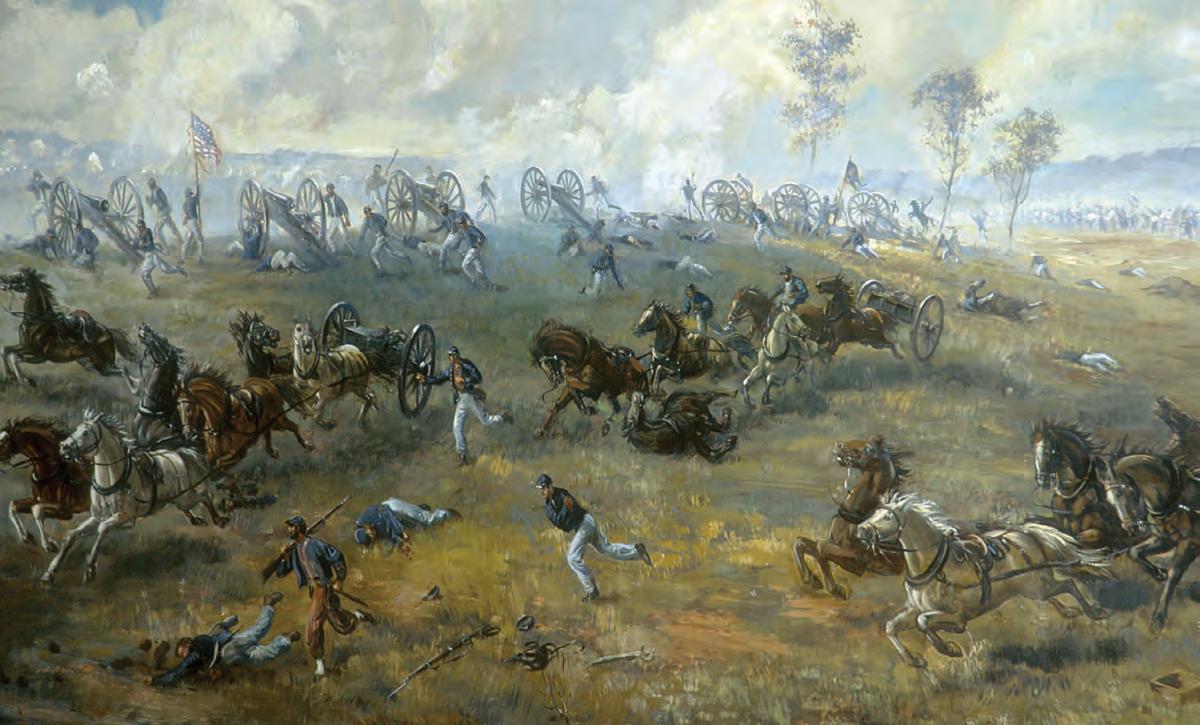
Private Green Berry Samuels was 21-year-old private in the Muhlenberg Rifles (10th Virginia Infantry, Company F). Part of a prominent family from the town of Woodstock in Shenandoah County—his father was a lawyer, judge, and former member of the U.S. Congress—he had been educated at the University of Virginia. At Manassas, his regiment was part of Arnold Elzey’s Brigade in the Army of the Shenandoah, fighting on Chinn Ridge. Five days later, he described his first battle experience in a letter to his sister from nearby Fairfax Station.
…Colonel Elzey’s brigade of which I have the honor of being a member left Piedmont on the Manassas cars early in the morning and after landing at the Junction we ran some 5 miles to the field of battle and arrived just in time to change defeat into a glorious victory. We sustained 5 volleys of musketry within the small loss of 6 killed and 14 wounded in our regiment. The ground sheltered us and connected with our throwing ourselves flat on the ground no doubt saved many a gallant soldier’s life. I cannot describe my feelings as I came into battle and heard the shrill singing of the rifle cannon shell and the whistling of
the Minnie balls. I was not afraid and I am proud to say that I think none in the company were frightened although many a pulse beat faster at the sight of death and the sound of the death dealing balls….
The hardest trial to one’s nerves is the sight of the wounded and the dead; in many cases the agony of the wounded was awful and their pitying cries for water heart-rending. As for the dead, some had died with their hands folded across their breasts with their eyes wide open looking up to Heaven with a sweet smile upon the face, some had evidently died in awful agony, with distorted faces, glaring eyes and clenched hands. I will write no more of this awful scene; it makes me sick to think of it. Would to God, Lincoln could have seen the horrors of last Sunday; we would have peace today instead of war. Our county, I understand, has lost some 20 killed, which has carried mourning into many a now fatherless home. Poor Milton Moore was engaged to be married; what must be the
A TURNING POINT
Union artillerymen of Captain James Ricketts’ battery flee from Henry Hill about 3 p.m., escaping the Confederate assault coming from the right. Ricketts was shot several times and captured, along with all of his cannons.
OPPOSITE PAGE: MANASSAS NATIONAL BATTLEFIELD PARK/EVERETT COLLECTION/BRIDGEMAN IMAGES; THIS PAGE: NATIONAL ARCHIVES; COURTESY OF THE CHARLESTON MUSEUM
CWTP-230700-WITW.indd 46 4/4/23 1:01 PM
feelings of the young lady?...
…I will send you a photograph of Colonel Ellsworth taken on the field of battle, please keep it safely as it will be a reminiscence for me in my old age should I live. Do not fail to keep it safely….
Samuels was captured twice during the war, and rose to a lieutenancy. For a time he served as an aide to Brig. Gen. Raleigh Colston. After the war he was a lawyer, and died in the soldier’s home in Richmond in 1901.
Private Charles Woodward Hutson of the Washington Light Infantry, Company A (Hampton’s Legion) was 20 years old at the time of the battle. He was from McPhersonville, S.C., and educated at what today is the University of South Carolina. His father, William Ferguson Hutson, helped draft the South Carolina Ordinance of Secession. The day after the battle, he wrote to his parents, from the University of Virginia in Charlottesville, where he was recovering from his wound. Hutson’s letter also gives his impression of how his companions behaved in action, and great detail of his wounding.
…Never have I conceived of such a continuous, rushing hailstorm of shot, shell & musketry as fell around & among us for hours together. We, who escaped, are constantly wondering how we could possibly have come out of the action alive. The words I used just now; “we, who escaped”, have a sad, sad sound to us; for we know not yet who are to be included in that category, & are filled with terrible anxieties as to the fate of dear friends. I must trace now to you my own course through the action, which I can or ought to do clearly enough, since, I was cool & confident from first to last, knowing where my trust was placed, that no real harm could befal me & that there was a duty before me which I must perform at every hazard. All of our men behaved gallantly, though few were free from excitement….I entreated the Captain to let me advance alone near enough to the ranks of those who were firing upon us to ascertain whether they were Federals or Confederate. But the Captain would not consent, & wished to go himself; this, however, Col. Hampton would not permit. Seeing, I could do nothing there, I attempted to persuade our men not to dodge, satisfied that we could never keep orderly ranks as long as the men persisted in dodging. But all my efforts in this line were unavailing; the men were fearless, &
MILITIAMEN AT WAR
As the roster above testifies, Charles Hutson was one of quite a few members of the Washington Light Infantry of Charleston, S.C., founded in 1807, who fought in the Confederate Army. The elaborate swallowtail coat at right was worn by militiaman William Muckenfuss, a comrade of Hutson’s in the Washington Light Infantry.
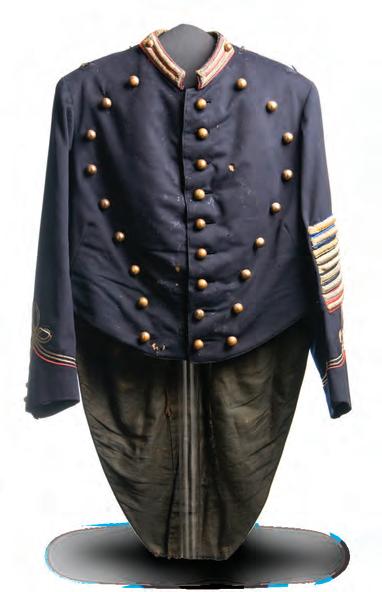
advanced undauntedly enough; but, I suppose, they thought dodging was a “help”, anyhow, to escape from the balls. Iredell Jones, & the officers kept erect; & neither they nor I were any the worse for it….I was the first who fell. I had put on my spectacles, taken good aim & fired my first shot. As I was in the act of re-loading, a rifle-ball struck me in the head, a little above the forehead; & the violence of the concussion felled me to the earth immediately. I drew off my spectacles & flung them aside; & not believing my wound a bad one, as it was not painful, I attempted to reload. But the blood was gushing over my face & blinding my eyes; & I found it impossible to do so. I knew pretty well the extent of my wound, as I had probed it with my finger as I fell; & as the gash seemed to be a deep one, I feared faintness would ensue from loss of blood, especially as there was a large puddle of it where I first lay. So, I put aside my gun for a while, & put my white handkerchief inside my hat upon the wound & tied my silk one around the hat. By the time I had finished these precautions, the company were in retreat; & with Jones & a few others I made my way to the clump of trees, whence we had advanced. Here protected by the trees & squatted down, these few detached from the company continued the fire. Jones

SUMMER 2023 CIVIL WAR TIMES 47 PHOTO CREDIT OPPOSITE PAGE: MANASSAS NATIONAL BATTLEFIELD PARK/EVERETT COLLECTION/BRIDGEMAN IMAGES; THIS PAGE: NATIONAL ARCHIVES; COURTESY OF THE CHARLESTON MUSEUM
CWTP-230700-WITW.indd 47 4/4/23 1:01 PM
having given me some water from his canteen, & my eye being by this time wiped pretty dry of the blood, I again attempted to re-load. But before I could do so, a ball from the enemy shattered my rifle to pieces. I now made the best of my way to the shelter of the house on the hill, the shell & shot of the enemy ploughing up the ground at every step I took, & the musketry rattling like hail around me. I lay behind the house quite exhausted, & much pained by the sight of some of my
THE PLAINS OF MANASSAS
The soldiers quoted in this article fought across the Manassas battlefield. Close to 5,000 men became casualties on this ground in 1861— some 3,000 Union troops and roughly 1,750 Confederates. In 1862, the same fields hosted more bloodshed.
FOR A DROP OF WATER...
A Confederate canteen brought home from First Manassas by a Union soldier. July 21, 1861, wasn’t overly hot. The temperature in D.C. was recorded as 80 degrees. The green troops, however, quickly guzzled their water. “The cry of ‘Water,’ ‘water,’ was heard above the groans of the dying,” remembered Manassas nurse Sarah Emma Edmonds.
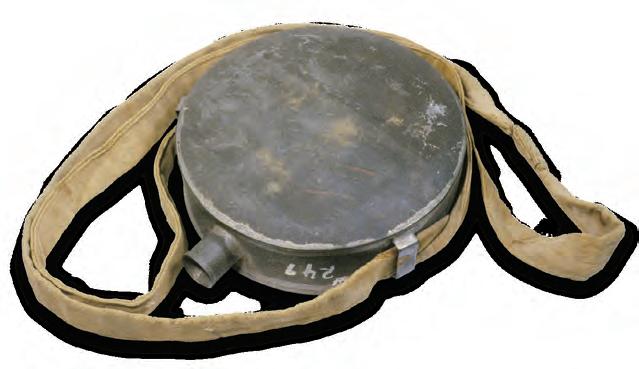
comrades badly wounded. Dr. Taylor examined my wound here, & charged me to use all my strength to reach the Hospital…
Hutson led a remarkable postwar life. He was admitted to the bar, but eschewing the practice he taught throughout the South, including at the University of Mississippi, Louisiana State University, and Texas A&M. His subjects included Greek, metaphysics, moral philosophy, history, and modern languages. He also authored numerous books on civilization and languages After his teaching career ended, he settled in New Orleans and took up painting. Though his trained artist daughter offered to teach him the basics, he insisted on an amateur’s approach. In 1917, at the age of 77, his works were first shown publicly, in New York City. His first one-man show came in 1931, at 91. He gained a solid national reputation, though his landscape artwork is hard to categorize. He lived to be 95.
The son of an Alabama physician/planter, John Pelham resigned from the U.S. Military Academy on April 22, 1861, just two weeks before his pending graduation. The 22-year-old lieutenant arrived at Manassas with elements of Joe Johnston’s Army of the Shenandoah the night before the battle, and
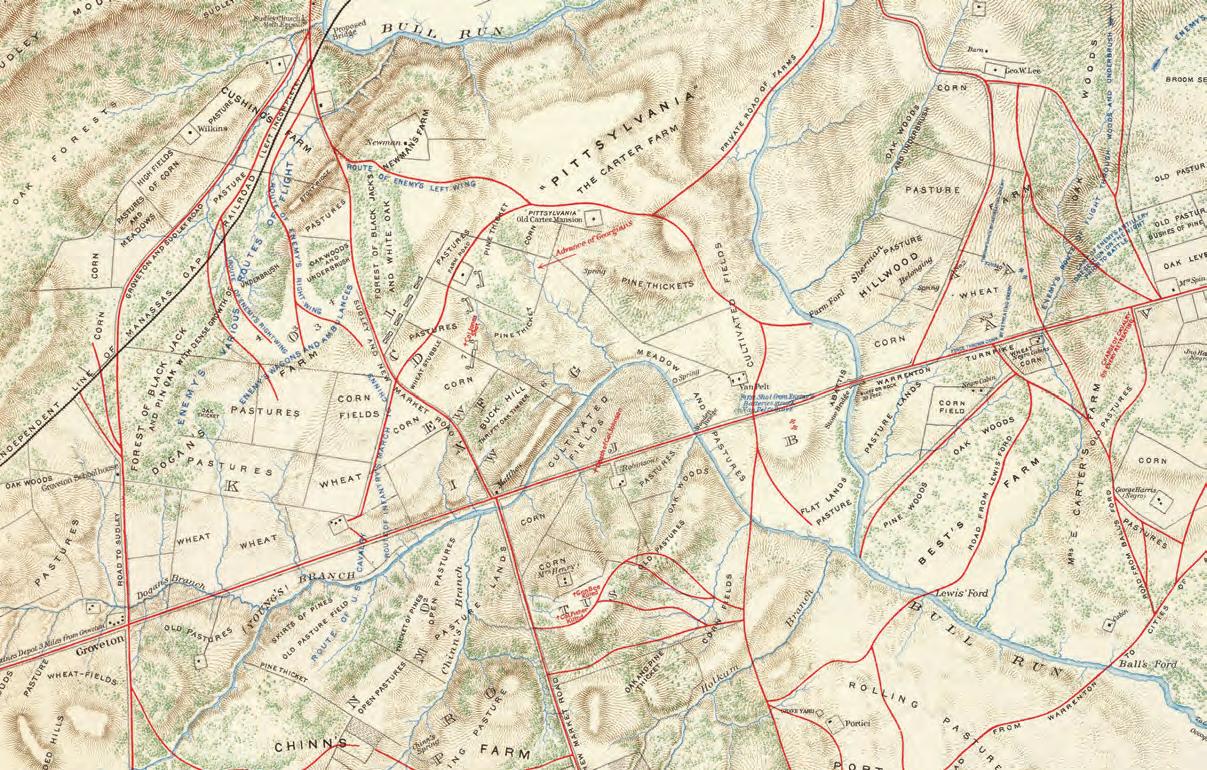
48 CIVIL WAR TIMES SUMMER 2023 DAVID RUMSEY MAP COLLECTION; ©DON TROIANI/BRIDGEMAN IMAGES NATIONAL PORTRAIT GALLERY
Green Berry Samuels
Charles Woodward Hutson John Pelham
CWTP-230700-WITW.indd 48 4/4/23 1:01 PM
Melvin Dwinell
found himself in command of four six-pounder guns of the Wise Artillery due to the absence of its captain. Two days after the battle, he wrestled with his conflicting emotions, shared his surprising introspection, and rationalized the necessity of his actions in a letter to his father at home in Alabama, which was published in the August 8 edition of the Jacksonville Republican.
I just write to let you know that we have had one of the most desperate battles ever fought on American soil. It was the most desperate— the enemy fought long and well, but victory is ours, it was a splendid victory too. Jeff Davis made his appearance on the field, just as the last of the Yankees were in full retreat. I was under a heavy fire of musketry and cannon for about seven hours, how I escaped or why I was spared a just God only knows. Rifle balls fell like hail around me. Shells bursted and scattered their fragments through my Battery—my horse was shot under me, but did not give out till the fight was almost over. I was compelled to take one of my Sergeant’s horses and ride through. At one time I dismounted and directed the guns—one of the gunners asked me to dismount and shoot the Federals flag down. I did so—you ought to have heard the cheers they gave me. I directed all my guns three or four times apiece. My men were cool and brave and made terrible havoc on the enemy. They fought better than I expected they would. The highest praise is due them….I was complimented several times on the field of battle by general officers and a great many times after the battle was over by other officers, you may want to know my feelings—I felt as cool and deliberate under the shower of lead and iron as if I had been at home by our fireside—I did not feel fear at any moment; I can’t see how I escaped—a merciful Providence must have been watching over us and our cause.…
I have seen what Romancers call glorious war. I have seen it in all its phases. I have heard the booming booming of cannon, and the more deadly rattle of musketry at a distance—I have heard it all near by and have been under its destructive showers. I have seen men and horses fall thick and fast around me. I have seen our own men bloody and frightened flying before the enemy—I have seen them bravely charge the enemy’s lines and heard the shout of triumph as they carried the position, I have heard the agonizing shrieks of the wounded and dying—I have passed over the battle field and seen the mangled forms of men and horses in frightful
abundance—men without heads, without arms, and others without legs. All this I have witnessed and more, till my heart sickens; and war is not glorious as novelists would have us believe. It is only when we are in the heat and flush of battle that it is fascinating and interesting. It is only then that we enjoy it. When we forget ourselves and revel in the destruction we are dealing around us. I am now ashamed of the feelings I had in those hours of danger. The whistling of bullets and shells was music to me, I gloried in it—it delighted and fascinated me—I feared not death in any form; but when the battle was won and I visited the field a change came over me, I see the horrors of war, but it is necessary. We are battling for our rights and our homes. Ours is a just war, a holy cause. The invader must meet the fate he deserves and we must meet him as becomes us, as becomes men. As President Davis said, several months ago, “a small mound of earth marks the place where the invader fell.”
After First Manassas, John Pelham rose to fame as the commander of J.E.B. Stuart’s horse artillery. He was mortally wounded at the Battle of Kelly’s Ford on St. Patrick’s Day, 1863, and died the next day.

LIFE CUT SHORT
John Pelham grew up in Alabama, enjoying the prosperous life of an enslaver’s son. From his youth, he exhibited a rough and tumble personality. He attended West Point, but left after the firing on Fort Sumter. On one of his last days at West Point, he confided to a fellow cadet, “I shall be in two or three fights and then be killed.”
SUMMER 2023 CIVIL WAR TIMES 49 DAVID RUMSEY MAP COLLECTION; ©DON TROIANI/BRIDGEMAN IMAGES NATIONAL PORTRAIT GALLERY
CWTP-230700-WITW.indd 49 4/13/23 8:53 AM
Melvin Dwinell was born in Vermont in 1825, but in 1853 he made his way south to Georgia. Three years later, he became editor and owner of a paper that by 1861 was known as the Rome Tri-Weekly Courier, At the time of the First Battle of Manassas, he was a 36-year-old lieutenant of the 8th Georgia Infantry’s Company A, known as the Rome Light Guards. The regiment was involved in heavy fighting on Matthews Hill during the opening phase of the battle and, by Dwinell’s count, 38 percent of its 543 men engaged in the fight were killed, wounded, or captured. He corresponded regularly with his paper throughout the war. The following, written on August 13, 1861, from Camp Bartow near the battlefield, appeared in the paper 11 days later, and is exceptional in its length and its focus almost solely on Dwinell’s feelings while under fire and his reaction to the attendant carnage.
As everything in the way of news, incidents, accidents, &c., pertaining to the great battle of the 21st, is eagerly sought for by all who have relatives or friends in the Confederate Army, and as this includes nearly every family member in the country, the writer of this is so presumptuous as to undertake “a description of one’s feelings in the battle of Manassas–it being his first experience.”
Though at different times and places our Regiment had been, some six or eight times, drawn up in line of battle, and we had gone through all the little heart sinkings, trepidations and fearful apprehensions, which most men experience, upon the eve of entering the life and death contest, yet, when we knew that a great battle was about to be commenced, yet there was such a deep and thrilling earnestness in the cannon’s first booming, as convinced us of the certainty of the fearful work about to be done, and a deep seated apprehension of danger—though not generally shown by palid cheeks or trembling limbs—was experienced. The certainty of danger became still more apparent, when coming near the range of one of the enemy’s batteries, we heard the whizzing of the death dealing missiles, as they passed with a horrid significance of what we might expect from better aim.
The “pomp and circumstance of glorious war” suddenly dwindled down to the severest kind of plain, common sense, and it very soon became apparent, that common sense rules must be the basis of all discreet actions. At the first sight of the enemy, all the bug bear delusions that may have existed in the fancy of any one, as to their appearance, were suddenly dispelled, and they looked at the distance of three hundred or four hundred yards, precisely like so many of our men.
DWINELL’S HIGH TIDE
The Georgia monument at Gettysburg. Melvin Dwinell survived First Manassas and other engagements until he was wounded on July 2, 1863, at Gettysburg. He would never again take to the field and left the Army in November 1863.

Quite different from all my fancies of great battles; this was not fought in a broad open field, where the two grand armies could be drawn up in long, unbroken lines, and approach each other in heavy columns. There is no considerable extent of right level ground on this memorable field, but is completely broken with hills and dales, meandering branches and protecting groves. And in extent, the hottest part of the battle field was about one miles by three quarters in width. On such a field, of course, the awful grandeur of appearance of the approaching armies was lost. Then when the firing commenced, that wonderful, indefinite and superhuman grandeur of movements, that my imagination had painted, all faded out, and in its place I had an ugly, dusty, fatiguing and laborious realization of the actual in battle. I experienced most fear when the first cannon ball passed over, with a tremendous whizzing, about twenty yards off; and felt the most dread apprehension, when ordered immediately after, to take a position on a little eminence, in fearful proximity to the place the ball had just passed. After our Regiment had moved forward some 200 or 300 yards, we again came both in range and sight of Sherman’s celebrated Battery, about three-fourths of a mile from us. Their shell and balls came fearfully near, and as one passed through an apple tree just over my head, a cold chill ran over me, and I suffered from agonizing fear, for probably, three or four seconds, but after this, during the entire battle, though I was in almost constant expectation of being killed, yet there was no painful realization of fear, such as would make one hesitate to go wherever duty called, or prevented a full and free exercise of all the faculties of body and mind. As the dangers really increased, and friends were seen falling thick upon either side, the apprehension, or rather the fear, of them became strangely less, and without feeling secure there was a sort of forced resignation to calmly abide whatever consequences should come.
At no time did I experience any feeling of anger, or discover any exhibition of it in others. A stern determination and inflexible purpose, was the predominant expression of countenance of all, so far as my
50 CIVIL WAR TIMES SUMMER 2023 EVERETT COLLECTION/BRIDGEMAN IMAGES GETTYSBURG DAILY
CWTP-230700-WITW.indd 50 4/13/23 8:38 AM
OPENING ACTIONS
Union Brig. Gen. Ambrose Burnside’s regiments, foreground, battle Colonel Nathan “Shanks” Evans’ troops on Matthews Hill in the morning phase of the engagement. Evans delayed Burnside’s advance on Henry Hill long enough for Southern reinforcements to arrive. The afternoon portion of the fight shifted in the Confederates’ favor.
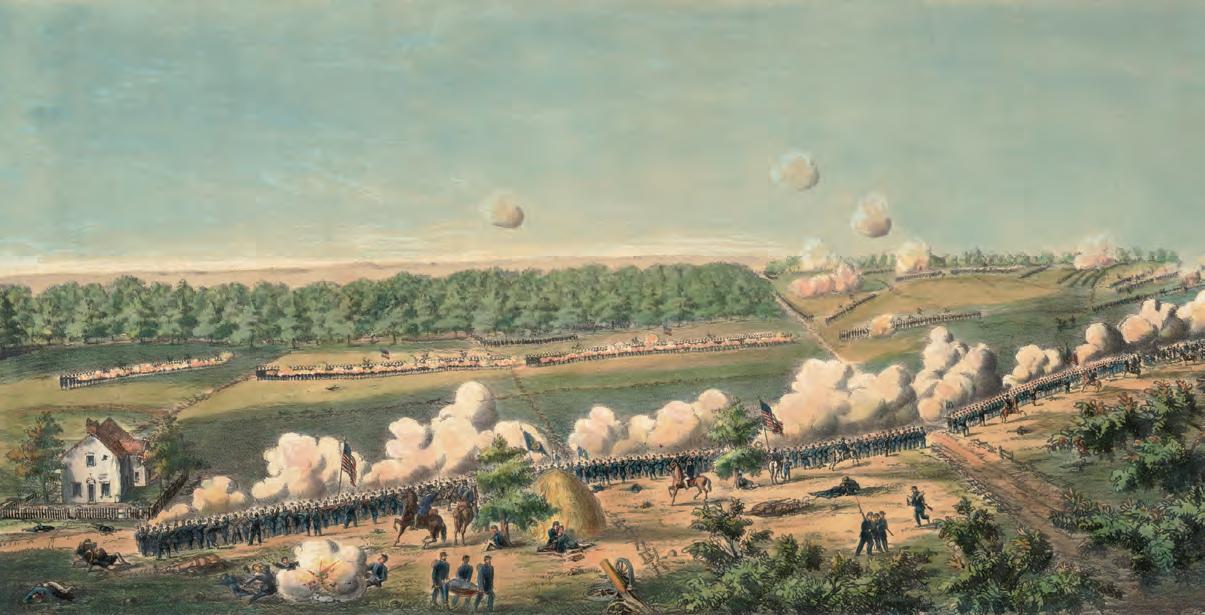
observation extended, and any sudden exhibition of passion would have seemed ridiculous.
One of the most remarkable mental phenomena, was the sudden and strange drying up of sympathetic feeling for the suffering of the wounded and dying. I could never before look upon even small operations, or persons in extreme pain from any cause, especially when blood was freely flowing, without intense pain and generally more or less faintness. But on this occasion I beheld the most terrible mutilations, the most horrid and ghastly expression of men in the death struggle, men with one arm or a leg, shot off, others with the face horribly mutilated, heads shot through and brains lying about, bodies half torn into, and at the hospital, some 50 men with legs or arms jut amputated and a half cord of legs and arms, and men in all degrees of pain, from the slight flesh wound to those producing death in a few moments, and viewed all this with far less feeling that I would ordinarily have seen brutes thus mutilated. This obduracy I am truly glad, was only temporary. Only two days after the battle I caught myself avoiding the amputation of an arm.
I have written thus much of my own feelings, not because they were peculiar, but according to my best knowledge and belief, were nearly the same as those shared by a great majority of all those who were in the heat of battle, for the first time, on the “glorious 21st.”
Melvin Dwinell was wounded at Gettysburg on July 2, 1863. He remained on wounded furlough until his resignation in November 1863. He represented Rome in the Georgia Legislature until the end of the war and continued to publish the Courier until selling it in 1885. He died two years later, at 62. His wartime correspondence with the Rome Tri-Weekly
Courier can be found in “Dear Courier”: The Civil War Correspondence of Editor Melvin Dwinell, edited by Ford Risley.
The above are fairly representative of surviving letters so far as the writers’ self-reported composure under fire and the horrific nature of combat. In the case of their composure, the self-serving nature of letters home renders it difficult to determine if what they wrote is an accurate reflection. Those who felt less than cool or detached or unafraid may have been reluctant to record their lack of equipoise, either out of consideration for themselves or for the concerns of those at home. Some few recollections are less “heroic”: one Virginian recalled, “Not being a warrior but a plain citizen, I saw nothing especially entertaining in such a hubbub….We lay as flat as flounders.”
These few hours of fighting, suffering, and surviving forever changed the men who fought at Manassas. The extent of that change is certainly a factor of the contrast between what they experienced there and the relatively peaceful antebellum lives they led. How their world views would continue to change over the next four years, only time would tell.
These and hundreds of other letters, diaries, memoirs, testimonies, and reports associated with the First Battle of Manassas can be found at Harry Smeltzer’s website, www.bullrunnings. wordpress.com.
SUMMER 2023 CIVIL WAR TIMES 51 EVERETT COLLECTION/BRIDGEMAN IMAGES GETTYSBURG DAILY
CWTP-230700-WITW.indd 51 4/4/23 1:02 PM
FLYING OVER LITTLE ROUND TOP
This photograph was taken June 6, 1924, and the hillside’s look remains similar. The course of Sykes Avenue, however, is different— realigned in 1897 to create two viewsheds on the summit. The northern vista is at the left. The avenue makes a sharp turn near the 155th Pennsylvania monument to pass behind the Gouverneur K. Warren and 91st Pennsylvania monuments and the guns commemorating Charles Hazlett’s battery before arcing to the west by the 140th and 44th New York monuments at the right of the photo. In 1935 the roadway was straightened, as it remains today.

52 CIVIL WAR TIMES SUMMER 2023
CWTP-230700-GETTYSBURG.indd 52 4/4/23 8:27 AM
EVOLUTION OF A BATTLEFIELD Photographs
 BY MICHAEL WARICHER
BY MICHAEL WARICHER
SUMMER 2023 CIVIL WAR TIMES 53
of Gettysburg’s
Commemorative Era
CWTP-230700-GETTYSBURG.indd 53 4/4/23 8:28 AM
Igrew up only 25 miles north of Gettysburg, and the battlefield has been a second home to me. In February 2012, I created a Facebook page, “Michael Waricher’s Gettysburg Perspectives” to share photography of the Gettysburg battlefield I had been collecting.
The period that most captivated me was the Commemorative Era, generally defined as 1864 through the battle’s 50th anniversary in 1913. During that time, veterans returned to visit with their families and for reunion encampments. Monument dedications were frequent, and a large portion of the battlefield infrastructure was built. The park was transitioning from the grassroots oversight of the Gettysburg Battlefield Memorial Association (1864-1895) to that of the federal government’s War Department (1895-1933).
Bringing Gettysburg photographs back to the light of day and endeavoring to share the stories they depict has been an
enjoyable 11-year journey for me. The daily process of researching facts and details to accompany an image has made me a more thorough historian. As a result, the page has grown and become more engaging. I find it a unique means of perpetuating the memory of the battle’s veterans while also retelling the story of the battlefield itself and its builders.
This collection of images offers an appealing Commemorative Era sampling from a variety of locations. In some photographs, things appear starkly different, and in others they look quite similar to today. We are seeing the battlefield evolve through a half-century of intensive toil and expenditure.
The next time you’re on the battlefield, take a moment to look around you. That monument, cast iron sign, gun carriage, or the avenue on which you are driving were all products of the Commemorative Era at Gettysburg. It truly was a golden age for the park.
The curious, oversized jumble of boulders known as Devil’s Den was a popular destination for late 19th-century visitors and a lucrative spot for local photographers to ply their trade. Tourists found the opportunity to have a family photo taken in front of the massive formations tremendously appealing.
DEVIL’S DEN
This circa 1895 photograph captures a typical summer’s day of the time. The camera gazes across a gently flowing Plum Run toward Devil’s Den’s northern approach. Neatly situated below the looming Round Tops, carriages deliver passengers for an afternoon of leisurely exploration. Here, stands of mature trees grow with random abandon among the diabase boulders while the grounds present a carefully maintained appearance. A worn network of
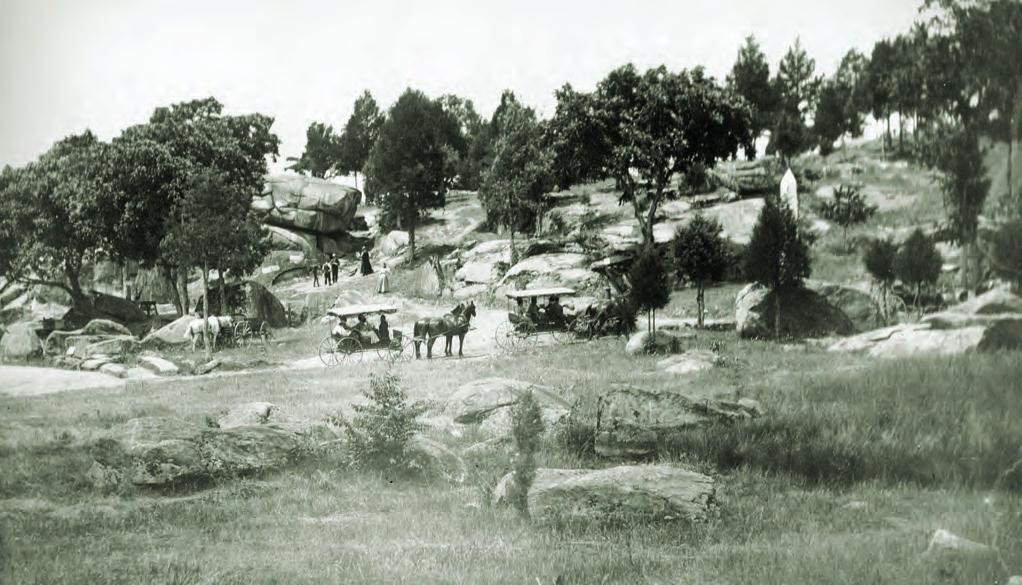
footpaths and wagon traces pass through the rocks to various points of interest.
The precariously balanced “Table Rock” peeks from between the trees at the left-center portion of the image, its face marked by white chisel gouges resulting from recent efforts to remove years of accumulated graffiti. In the right-center of the photo, the white tip of the 4th Maine Infantry obelisk defies a tree’s best effort to obscure it.
Survivors of the 4th Maine dedicated and presented the monument to the Gettysburg Battlefield Memorial Association on October 10, 1888.

54 CIVIL WAR TIMES SUMMER 2023 COURTESY OF GETTYSBURG NATIONAL MILITARY PARK; PHOTO BY MELISSA A. WINN PREVIOUS SPREAD: NATIONAL ARCHIVES; THIS PAGE: COURTESY OF GETTYSBURG NATIONAL MILILTARY PARK
CWTP-230700-GETTYSBURG.indd 54 4/13/23 8:40 AM
154 TH NEW YORK MONUMENT
On July 1, 1890, the surviving members of the 154th New York Infantry gathered in a trimmed field east of North Stratton Street to dedicate a memorial to their actions 27 years prior. On this spot, as the 11th Corps lines crumbled to the north, they and their brigade comrades commanded by Colonel Charles Coster had courageously attempted to slow the enemy’s rush.
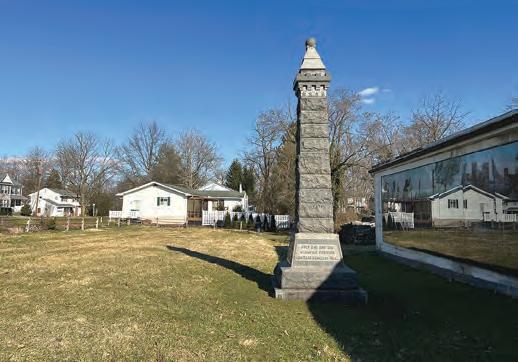
The 154th had numbered nearly 600 men before the Battle of Chancellorsville. As a testament to the severity of their actions in that battle, only 239 were present at Gettysburg. On July 1, 1863, they suffered 200 casualties, most captured while attempting to extricate themselves from the Confederate assault that afternoon.
By 1890, monuments were rapidly dotting the battlefield, and the avenues to carry visitors to those sites were either being planned or in the early construction stage. It was a high point of the Commemorative Era for the battle’s veterans. The Gettysburg Battlefield Memorial Association, the park’s oversight entity, had purchased a parcel of land on the outskirts of Gettysburg’s northern limits to further their work. Nearly the length of a football field and a mere 20 yards in width, Coster Avenue would provide the land for the brigade’s tributes.
SURROUNDED ONCE AGAIN
This image of the 154th New York Infantry’s 18-foottall granite monument offers a fleeting glimpse into the park’s history. It was a moment not destined to last. Generally, the battlefield’s monuments have stood on lands protected from development. Often, a photograph taken in 1890 appears relatively similar in surroundings and setting to a photo taken in 2023. In this instance, while the narrow avenue remains a grassy haven to history, the surrounding lands have fallen victim to Gettysburg’s growth.

SUMMER 2023 CIVIL WAR TIMES 55 COURTESY OF GETTYSBURG NATIONAL MILITARY PARK; PHOTO BY MELISSA A. WINN PREVIOUS SPREAD: NATIONAL ARCHIVES; THIS PAGE: COURTESY OF GETTYSBURG NATIONAL MILILTARY PARK
CWTP-230700-GETTYSBURG.indd 55 4/6/23 9:51 AM
Photographer William H. Tipton meticulously documented the Gettysburg battlefield’s development. In 1888 or early 1889, he captured this view to the west while standing on Culp’s Hill’s northwest slope.
The most prominent features of Tipton’s image are the recently reconstructed earthworks of the Iron Brigade, running east to west through the center of the photograph toward Stevens’ Knoll. The earliest commemorative features on that hill are the artillery pieces of Captain Greenlief T. Stevens’ 5th Maine Battery. A closer inspection also reveals the finished base for that unit’s yet-to-be-completed monument. Major General Henry Slocum’s equestrian monument is still 13 years from its appearance on the hill.
STEVENS’ KNOLL
This unique perspective yields a remarkable, richly detailed glimpse of Cemetery Ridge on the horizon. The conspicuous two-story house beyond the knoll is the Wright House (today’s park law enforcement office), and the white structures to its left are Lydia Leister’s house and barn—Maj. Gen. George Meade’s headquarters during the battle.
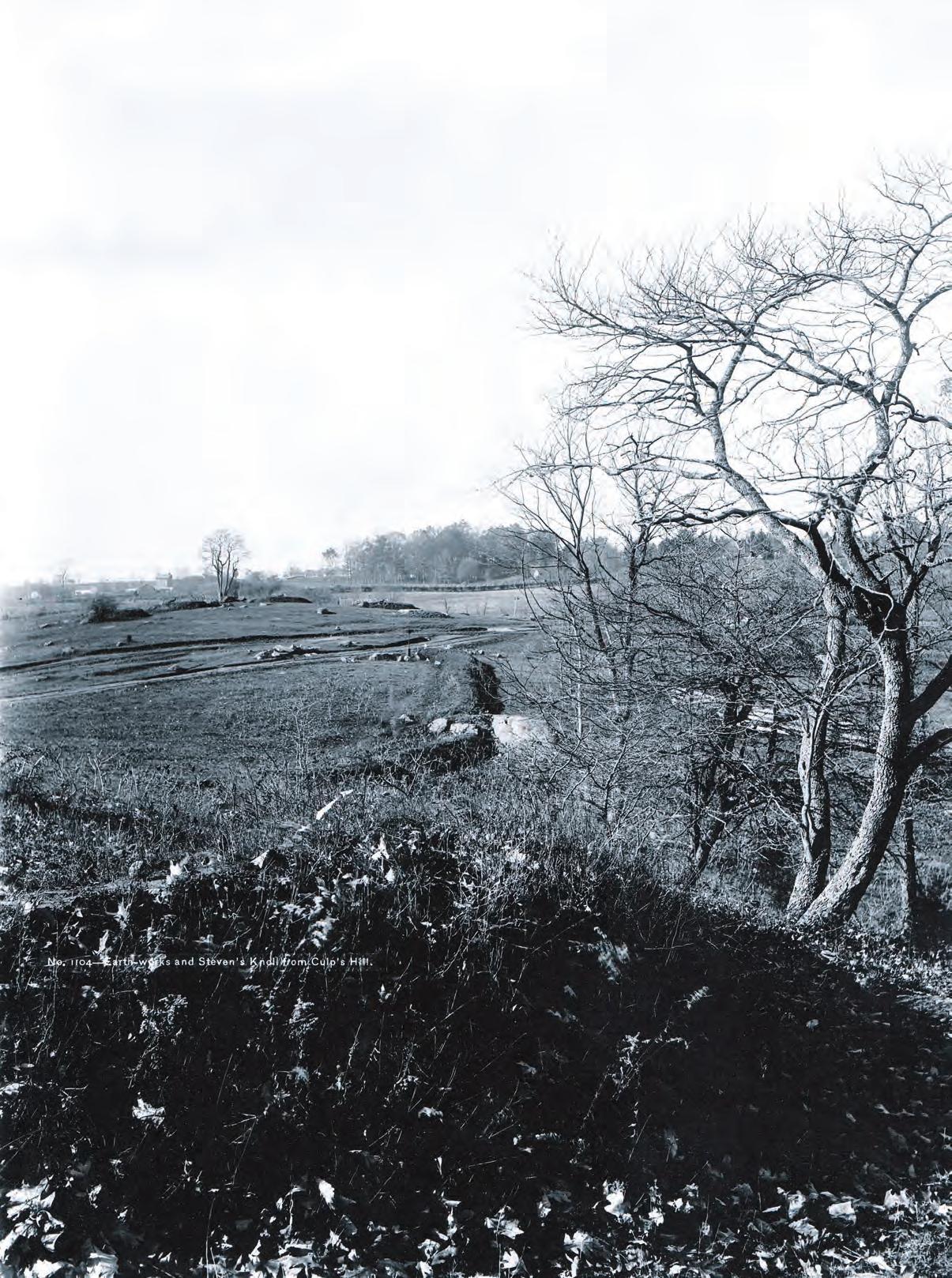
A striking aspect of this view is the open landscape, as a returning veteran would have witnessed during the battle’s 25th anniversary. In this instance, it’s a vista long lost to modern visitors through changing land use and management practices.
A VISTA LOST
The same Iron Brigade trenches now thread through the woods. Though adjacent to the park road, they are often overlooked by visitors. The famous Midwestern regiments held this position on July 2–3. Although Gettysburg National Military Park has sought to restore vistas on some parts of the battlefield, this location remains very different from its 1863 appearance.

OPPOSITE PAGE: COURTESY OF GETTYSBURG NATIONAL MILITARY PARK; PHOTO BY MELISSA A. WINN; THIS PAGE: COURTESY OF GETTYSBURG NATIONAL MILITARY PARK (2)
CWTP-230700-GETTYSBURG.indd 56 4/4/23 8:29 AM
LITTLE ROUND TOP
The monument in this 1885 image was dedicated by 91st Pennsylvania veterans in 1883. Six years later, the monument moved onto a flat, etched stone dedicated to the memory of Brig. Gen. Stephen Weed and Lieutenant Charles E. Hazlett, both mortally wounded nearby. In 1889, the Pennsylvania veterans would erect an impressive 25-foot granite specimen at the site of the original.
In May 1885, the GBMA ordered 30 iron gun carriages from the Navy Department, at a cost of $20 per piece, like those seen here. Such carriages began to be phased out in the late 1880s when the park contracted with the local Gilbert & Smith Foundry for 30 more realistic iron models. Examples of these Gilbert & Smith carriages remain on the battlefield.
This early 1880s photograph depicts East Cemetery Hill and the guns of the New York and Pennsylvania batteries that had defended it. With the exception of the small, white marker at the center of the photo, East Cemetery Hill was relatively devoid of monumentation. The veterans of Battery B, 1st Pennsylvania Artillery (Cooper’s Battery), placed this marble-capped memorial in 1879. It was the first artillery marker on the battlefield.
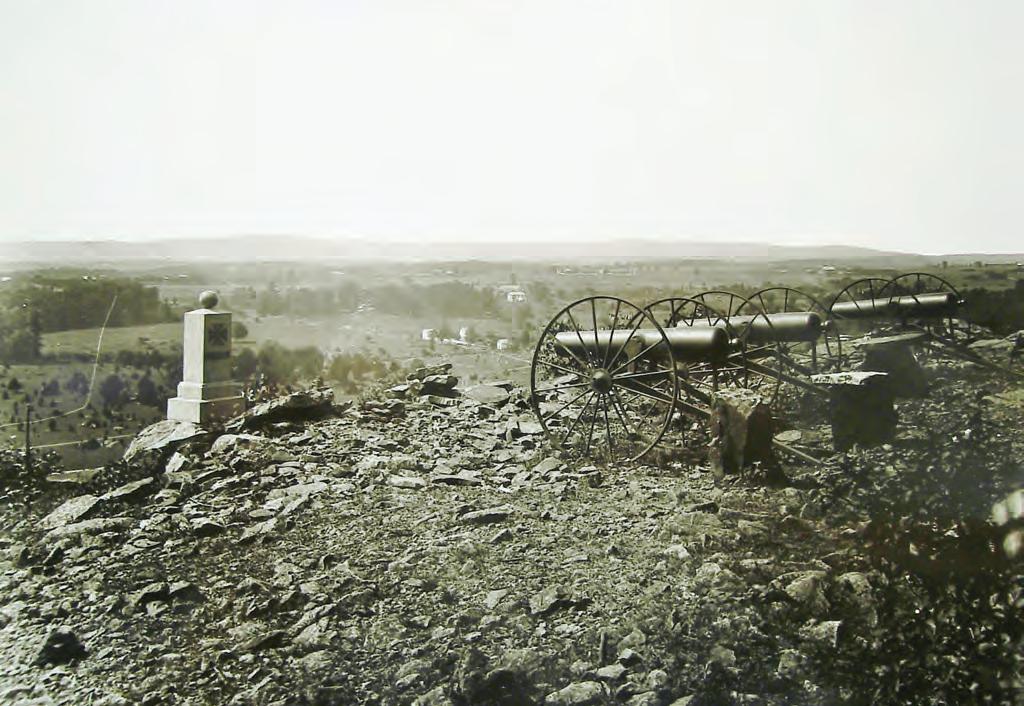
The wooden observation tower was constructed in the spring of 1878. It stood 50 feet tall with viewing platforms at its midpoint and peak. The observatory would gradually deteriorate before being sold and dismantled in 1895. The Maj. Gen. Winfield Scott Hancock equestrian monument would stand on its footprint the following year.
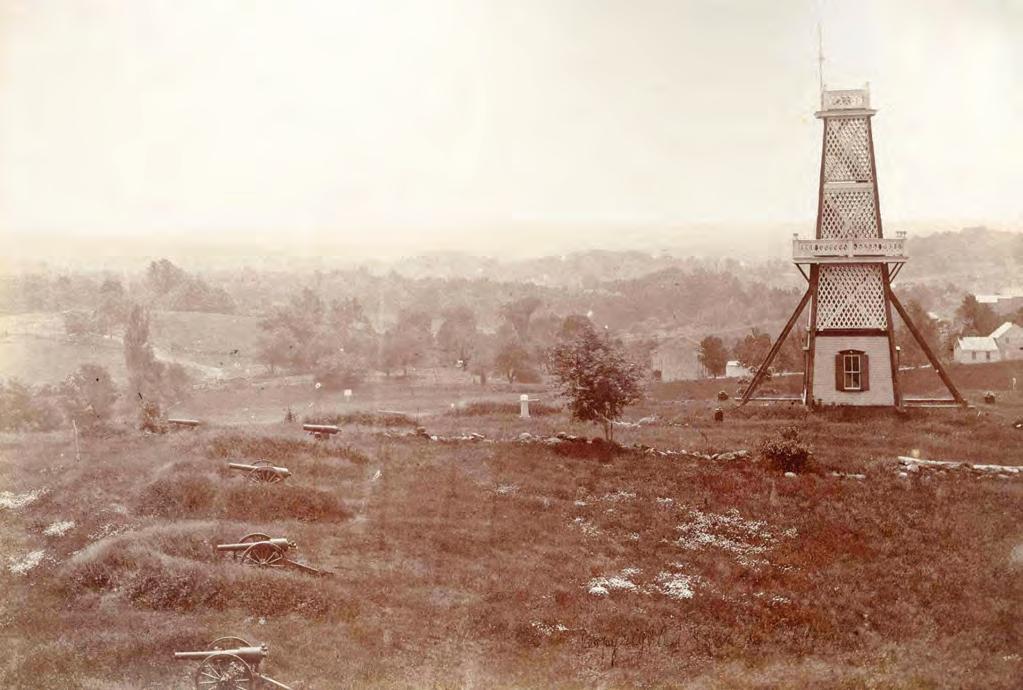
EAST CEMETERY HILL
SUMMER 2023 CIVIL WAR TIMES 57 PHOTO CREDIT OPPOSITE PAGE: COURTESY OF GETTYSBURG NATIONAL MILITARY PARK; PHOTO BY MELISSA A. WINN; THIS PAGE: COURTESY OF GETTYSBURG NATIONAL MILITARY PARK (2)
CWTP-230700-GETTYSBURG.indd 57 4/6/23 9:51 AM
RAILROAD CUT BRIDGE

By the mid-1880s, the monumentation of the Gettysburg battlefield was burgeoning, and the Gettysburg Battlefield Memorial Association provided avenues to accommodate the growing visitation.
The ferocious fighting that had taken place on McPherson’s Ridge and the surrounding lands made it an attraction for both returning veterans and visitors to the battlefield.
At the request of the GBMA, historian John Bachelder conceived Reynolds Avenue, running along the spine of McPherson’s Ridge, in May 1885. Its eventual completion provided a main north-south artery for battlefield traffic between Hagerstown Road to the south and Buford and Wadsworth Avenues to the north. The only obstacle along this nearly milelong straightaway was the second ridgeline cut of the Western Maryland Railroad. At 19 feet deep and with a span of roughly 50 feet, a bridge would be needed to facilitate a seamless traffic flow.
At a February 25, 1886, meeting of the GBMA’s Executive Committee, they agreed to contract with the Gettysburg foundry of Calvin Gilbert and Joseph Smith to construct the necessary bridge, a 14-foot wide, iron truss-style span with oak plank flooring for a sum of $635.
The Detroit Publishing Company photograph seen here dates to the early 1900s. The image looks from the northeast bank of the railroad cut to the west
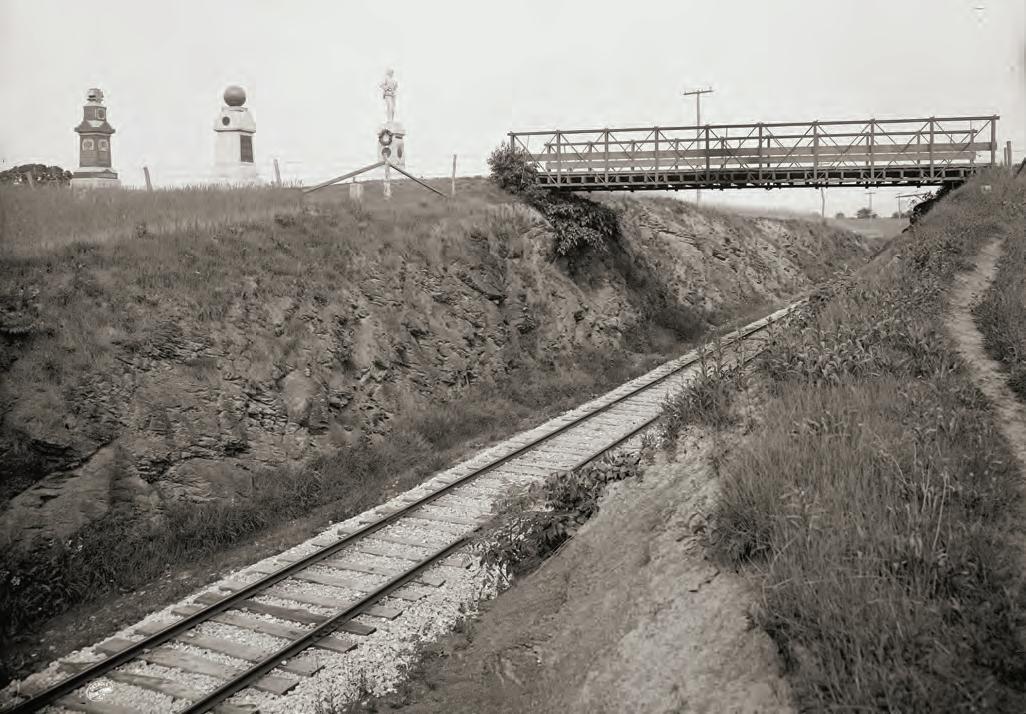
ANOTHER CUT CROSSING
A bridge constructed in 2008 now spans the cut. A 1958 bridge substantially altered the surrounding landscape, and necessitated the movement of the three monuments seen in the early-1900s photo farther from the roadway.
and captures the first of the four bridges that have spanned this gap between 1887 and 2023. The image also depicts the original depth of “the cut” and the 6th Wisconsin, 95th New York, and 14th Brooklyn monuments on its southern bank.
58 CIVIL WAR TIMES SUMMER 2023 COURTESY OF DAYTON HISTORY; PHOTO BY MELISSA A, WINN PHOTO BY MELISSA A. WINN; LIBRARY OF CONGRESS
CWTP-230700-GETTYSBURG.indd 58 4/4/23 8:29 AM
WHEATFIELD TROLLEY
Gettysburg National Military Park has faced its share of challenges since its inception. Few would prove as controversial as the appearance of an electric railway on battlefield land in 1893.

Fully operational by May 1894, the eight-mile “trolley” circuit, which cost $170,000, emanated from the heart of Gettysburg and made seven stops while crossing over some of the most sacred lands of the second and third day’s battlefields.
Ohio photographer Albert Kern captured a portion of the “electric road” at the Wheatfield stop below The Loop in this late 19th-century image. Note the planking for passenger boarding and unboarding. From this point, the trolley continued southward to Devil’s Den and Little Round Top.
A groundswell of opposition to the trolley quickly arose, led by former Maj. Gen. Daniel E. Sickles, veterans, and popular newspapers. Harper’s Weekly led the charge, running an article, “The Gettysburg Desecration” in its July 1, 1893, edition. Lamented battlefield historian John Bachelder in the article: “The railway cuts straight through lines of battle, forest trees are levelled, boulders and ledges blasted...and the whole character of the field is changed.” Harper’s Weekly author John Reed Scott emphatically declared, “The trolley vandals have hewed their course of destruction, and all the pristine beauty is gone forever, the victim of corporate greed.”
But the trolley proved popular with tourists for a time. Ultimately, the rise of the automobile, improved park roads, and the general deterioration of the trolley infrastructure would drive the electric railway’s demise in 1916. Traces of the trolley route remain discernible on the battlefield today.

AT “THE LOOP”
The trolley stopped here at The Loop before heading on to Devil’s Den and Little Round Top. Modern tree cover blocks the view of Big Round Top visible in the image above, but the 1st Michigan monument is still prominent.
Michael J. Waricher, a Carlisle, Pa., native, is a professional artist and lifelong student of the Battle of Gettysburg. Through his Facebook page, “Michael Waricher’s Gettysburg Perspectives,” he shares his research of the battlefield’s history through photos.
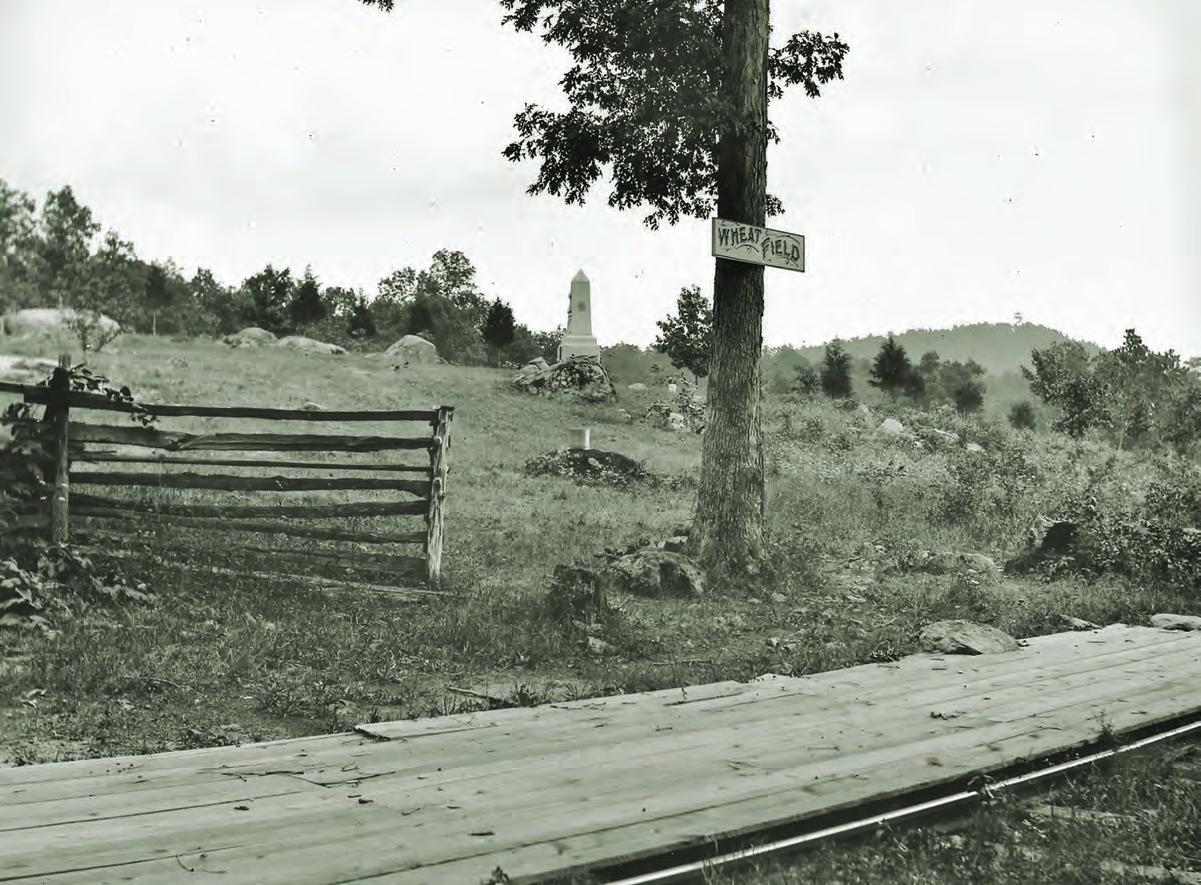
SUMMER 2023 CIVIL WAR TIMES 59 COURTESY
OF DAYTON HISTORY; PHOTO BY MELISSA A, WINN PHOTO BY MELISSA A. WINN; LIBRARY OF CONGRESS
CWTP-230700-GETTYSBURG.indd 59 4/4/23 8:30 AM
SEVEN SHOTS IN A ROW
CHRISTOPHER SPENCER’S WEAPONS CHANGED THE FACE OF WARFARE

THE BREECHLOADING seven-shot, metallic-cartridge rifles invented by Christopher Miner Spencer were the most innovative and reliable repeaters of the conflict. The deadly weapons were the precursor to modern assault rifles.
Spencer was born in 1833, and grew up in Connecticut, a hotbed of industrial innovation. After cutting his gunmaking teeth working for Samuel Colt’s factory, Spencer left to develop his repeating rifle.
The inventor moved to Massachusetts, working in a silk mill by day and making drawings and wooden models of his firearm by night. After being satisfied his concept would work, he applied for and received a patent for his prototype in early 1860.
It’s a familiar story that the U.S. Army was hesitant to adopt new weapon technologies, and chose to rely on single-shot muzzleloaders to arm the volunteer regiments that formed after the Civil War began.
Secretary of the Navy Gideon Welles, however, was impressed with a demonstration of his repeater, and the Navy ordered 700 of them. Spencer then pressed his case all the way to President Lincoln, who ordered 10,000 in 1861. But it wasn’t until January 1863, when the weapons were in the hands of Union land troops. Four companies of Ohio sharpshooters were the first infantrymen to carry the weapon, and the 5th and 6th Michigan Cavalry used Spencer rifles to good effect at Gettysburg.
The gun’s reputation soared, and after Lincoln test fired a Spencer at the White House, their production and usage greatly increased. More than 200,000 were made at Spencer’s factory or under contract at the Burnside Rifle Company by 1869.
Spencer lived until 1922, long enough to see rapid-firing guns using metal cartridges dominating battlefields. —D.B.S.
MOBILE FIREPOWER
Two no-nonsense Union cavalrymen pose with the weapons of their trade, including Spencer carbines. The carbine model did not begin to get issued until October 1863. The federal government eventually purchased more than 95,000 Spencer carbines. That would be more than any other model.
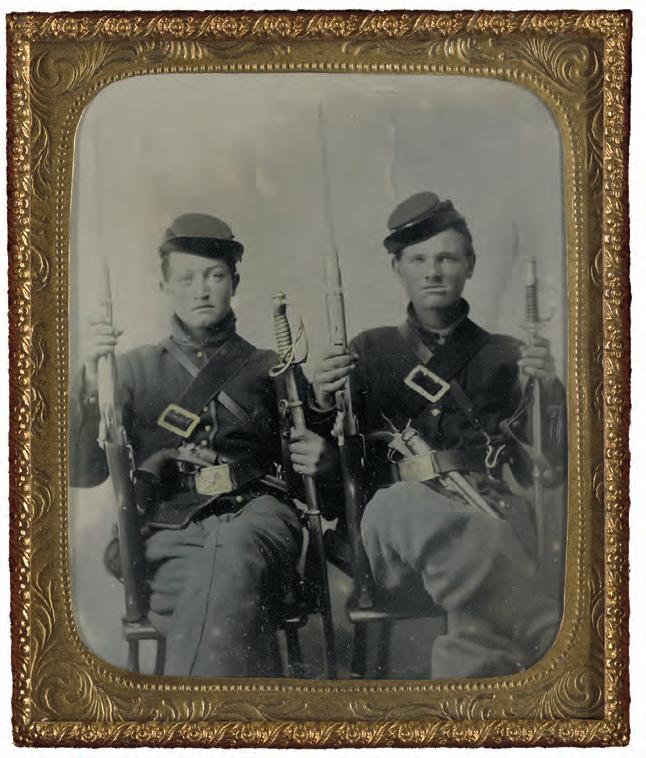
60 CIVIL WAR TIMES SUMMER 2023 ARMAMENT LIBRARY OF CONGRESS CLOCKWISE FROM TOP LEFT: U.S. PATENT OFFICE; WHS COLLECTIONS 2015.1.114; HERITAGE AUCTIONS, DALLAS (2)
CWTP-230700-ARMAMENT.indd 60 4/4/23 8:25 AM
SPENCER AND HIS PATENT
Christopher Spencer, above, received a patent for his breechloader on March 6, 1860. The drawing at left illustrates how .52-caliber metal cartridges were fed through a “tunnel” in the gun’s butt. A user loaded the magazine with seven rounds, dropped and raised the trigger guard to feed a cartridge into the breech and eject a used case, and then cocked and fired Spencer’s invention. The rimfire cartridges meant that no percussion caps were needed, speeding the process.
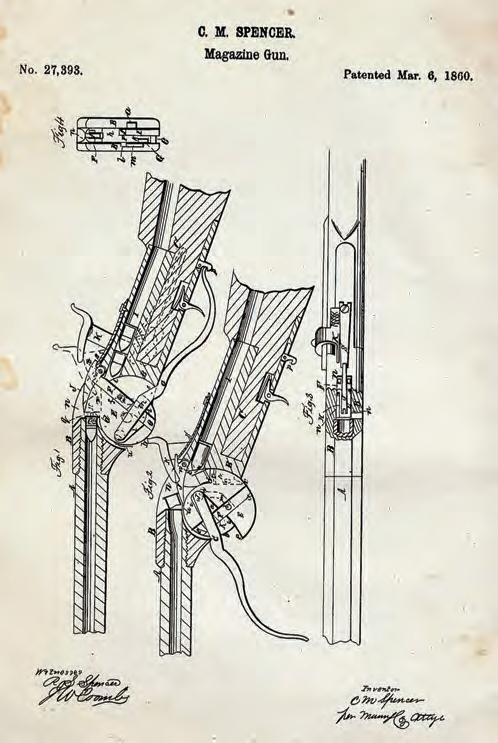


THE CHANGING FACE OF WARFARE
The seven-shot Spencer rifle and carbine provided Union soldiers with weapons that could fire, for the time, a blistering 20 rounds a minute. The rifle weighed in at 10 pounds and 47 inches, and infantry troops who were issued the weapon also received a socket bayonet — rare collectibles today. The carbine was 8 inches shorter and about two pounds lighter. Even today, Spencers still look sleek and capable.


SUMMER 2023 CIVIL WAR TIMES 61 LIBRARY OF CONGRESS CLOCKWISE FROM TOP LEFT: U.S. PATENT OFFICE; WHS COLLECTIONS 2015.1.114; HERITAGE AUCTIONS, DALLAS (2)
CWTP-230700-ARMAMENT.indd 61 4/4/23 8:25 AM
LOADING UP THE “HORIZONTAL SHOT TOWER”
A Union soldier poses with the magazine removed from the butt of his Spencer rifle. The magazine’s internal spring forced rounds forward. An admiring Federal officer wrote, the Spencer “never got out of repair. It would shoot a mile.... It could be taken all to pieces to clean, and hence was little trouble to keep in order — quite an item to lazy soldiers.”

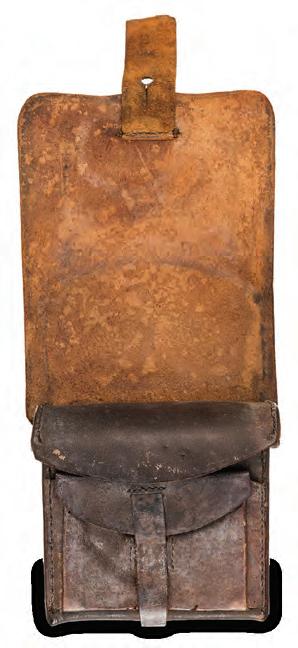
SPEED LOADERS
Most soldiers, like the man at left, carried their Spencer rounds in a cartridge box, above left. In December 1864, however, Erastus Blakeslee of the 1st Connecticut Cavalry invented the “Blakeslee Box.” It held seven tubes of seven .52-caliber rounds, below. Each tube could be quickly dumped into the Spencer’s magazine. The boxes, though, were found to be bulky and awkward.



62 CIVIL WAR TIMES SUMMER 2023 ARMAMENT CLOCKWISE FROM LEFT: ©DON TROIANI/BRIDGEMAN IMAGES; HERITAGE AUCTIONS, DALLAS (2); ©DON TROIANI/BRIDGEMAN IMAGES
CWTP-230700-ARMAMENT.indd 62 4/4/23 8:25 AM
Hunting is our heritage, our heart, and our future.
Hunting is our heritage, our heart and our future.
A DEFINITIVE STUDY OF THE MIND, BODY, AND ECOLOGY OF THE HUNTER IN THE MODERN WORLD

Where does hunting fit in the modern world? To many, it can seem outdated or even cruel, but as On Hunting affirms, hunting is holistic, honest, and continually relevant. Authors Lt. Col. Dave Grossman, Linda K. Miller, and Capt. Keith A. Cunningham dive deep into the ancient past of hunting and examine its position today, demonstrating that we cannot understand humanity without first understanding hunting. Readers will…
• discover how hunting formed us,
• examine hunting ethics and their adaptation to modernity,
• understand the challenges, traditions, and reverence of today’s hunter,
• identify hunting skills and their many applications outside the field,
• learn why hunting is critical to ecological restoration and preservation, and



• gain inspiration to share hunting with others.
Drawing from ecology, philosophy, and anthropology and sprinkled with campfire stories, this wide-ranging examination has rich depths for both nonhunters and hunters alike.
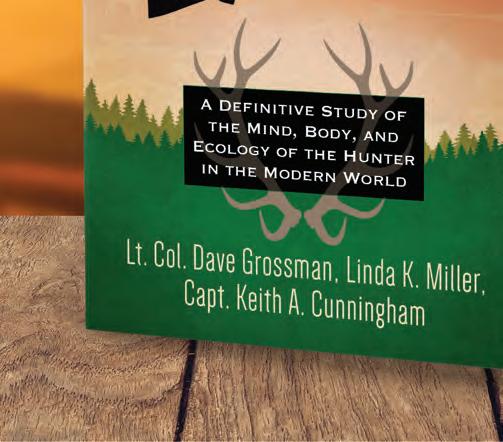
On Hunting shows that we need hunting still—and so does the wild earth we inhabit.

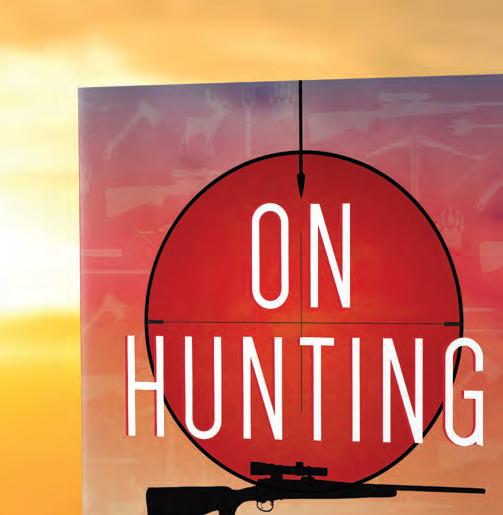
“All true hunters ‘feel’ the truth, but few are able to ‘articulate’ that truth. Now, thankfully, we have On Hunting to be our champion of the wild!”
Order your copy today at GrossmanOnTruth.com CWT-230516-004 Grossman On Truth.indd 1 3/30/2023 2:50:37 PM
—JIM SHOCKEY, Naturalist, Outfitter, TV Producer and Host
By Richard M. McMurry Savas Beatie, 2023, $34.95

REVIEWS
NO FRIEND OF JEFF DAVIS
General Joe Johnston seemed to check all the right boxes: West Point graduate, distinguished service in the Mexican and Seminole Wars, among others. But his Confederate career was a rocky one due to personality conflicts.

the debate over Confederate defeat came from the great Emory University historian Bell I. Wiley, who argued historians needed to pay greater attention to the phenomenon of “BigMan-Me-ism.” Unfortunately for those who fought and bled for Southern independence, the raging egos of too many Confederate generals and politicians rendered them incapable of setting aside their outsized senses of self on behalf of the greater cause.
Lacking the humility of an Abraham Lincoln or Ulysses S. Grant, Confederate leaders were incapable of cooperating with each other when circumstances made such cooperation critical. Not surprisingly, given he is one of the most accomplished of Wiley’s doctoral students, a central theme of the first volume of Richard M. McMurry’s new study of General Joseph E. Johnston, is the stormy relationship Johnston had with fellow “Big-Man-Me-ist” President Jefferson Davis.
“BIG-MANME- ISM”
ubiously presuming that a different outcome was either feasible or desirable in light of the material, moral, and managerial superiority of their opponents, White Southerners fiercely debated after Appomattox and Durham Station why their war against the United States had failed so spectacularly. Historians have debated the question no less robustly. Indeed, David H. Donald mused in the 1950s that there had to be more historians writing about the war than generals who had fought it— with the historians the more belligerent.
Among the more interesting contributions to
That Johnston, admired by many inside and outside the Confederate Army, had a difficult relationship with Davis is of course well-known. Their civil war within the Civil War figures prominently in Craig Symonds’ biography of Johnston, Steven Newton’s study of his service in Virginia, and recent studies of the Atlanta Campaign. Yet, the fact that it has been more than 30 years since Symonds’ study was published and there has been an extensive body of scholarship since then that has added to the debate over the Confederate war effort, makes a well-crafted new study of Johnston eminently justifiable.
In this volume, McMurry carries the story of Johnston’s Confederate service through the desultory Vicksburg Campaign, engaging and drawing from previous works on Johnston and recent analyses of the Southern war effort. (Interested readers will, though, lament the lack of a bibliography or full citation information for all the works that appear in the notes.) The product of McMurry’s efforts is a provocative and highly critical study that will leave readers eagerly awaiting the second volume of what promises to be an important study of a general who—for good and for ill—was truly one of the biggest of the Confederacy’s “Big Men.”
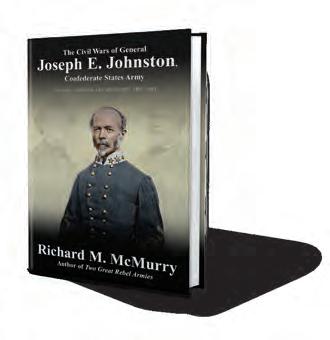
64 CIVIL WAR TIMES SUMMER 2023
NATIONAL PORTRAIT GALLERY
General Joseph E. Johnston, Confederate States Army, Volume I: Virginia and Mississippi, 18611863
REVIEWED BY ETHAN S. RAFUSE
CWTP-230700-REVIEWS.indd 64 4/11/23 1:20 PM
A LOST OPPORTUNITY
REVIEWED BY GORDON BERG

In the summer of 1863, a divided nation focused its attention on two of the Civil War’s largest military campaigns half a continent apart. One at Gettysburg ended on July 3; the other at Vicksburg finished a day later. But there was a third campaign that had the potential to significantly affect the course of the war and possibly end it in one bold stroke. That’s the campaign Hampton Newsome has focused on with a monograph infused with meticulous research, probing analysis, and a smooth narrative style that can serve as a model for today’s historians attempting to write a modern campaign study.
In June, Robert E. Lee’s Army of Northern Virginia began slipping out of its defenses below the Rappahannock River near Fredericksburg, headed toward the passes into the Shenandoah Valley and then turning north into Maryland and Pennsylvania. Union Maj. Gen. Joseph Hooker, bested by Lee at Chancellorsville in May, wanted to ignore Lee’s threat and strike for Richmond, hoping to end the war with one bold stroke. President Lincoln, however, vetoed that move, ordering Hooker—and later Maj. Gen. George Meade—to pursue Lee, rightly believing that the Confederate Army and not the Confederate capital, was the prize to be won.
“As Lee’s force marched away from Central Virginia,” Newsome writes, “Henry Halleck knew the supply lines behind the Army of Northern Virginia would be vulnerable and that Richmond would be, in all likelihood, lightly defended.” So “Old Brains” had a brainstorm. “He sensed an opportunity,” says Newsome, “and began to consider possible operations against the railroads in Virginia and North Carolina, as well as against Richmond itself.” For this operation, he intended to use about 20,000 mostly inexperienced soldiers from the 4th and 7th Corps under the command of Maj. Gen. John A. Dix, quartered in and around Fort Monroe, Va. In mid-June, Halleck ordered Dix “to threaten Richmond, by seizing and destroying their railroad bridges over the South and North Anna Rivers and do them all the damage possible.”
Halleck’s plan also had a North Carolina component. From the Union enclave at New Bern, forces under Brig. Gen. John G. Foster were to move against the Wilmington & Weldon Railroad, a strategic supply link moving foodstuffs into Richmond from breadbasket states farther south. Opposing them were Confederates under the command of pugnacious Maj. Gen. D.H. Hill. In far western Virginia, a third offensive under Brig. Gen. Benjamin F. Kelley aimed to cut the Virginia and Tennessee line. Together, Halleck hoped these operations would reap significant Union gains while the Confederacy’s main army was occupied in Maryland and Pennsylvania. Why they didn’t is the story Newsome tells with verve and detail.
Gettysburg’s Southern Front: Opportunity and Failure at Richmond
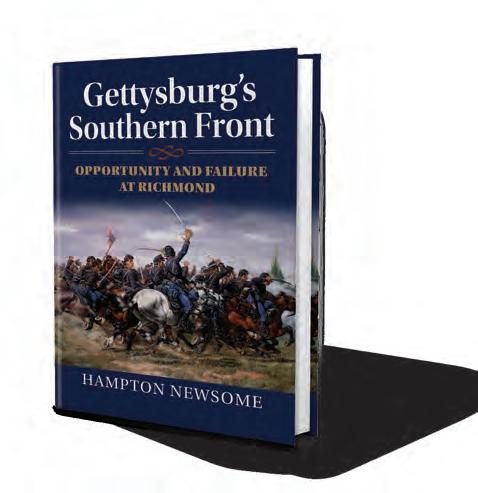 By Hampton Newsome University Press of Kansas, 2022, $36.95
By Hampton Newsome University Press of Kansas, 2022, $36.95
All three operations devolved into a series of uncoordinated raids. Hundreds of Union cavalrymen under Colonel Samuel P. Spear moved against the rail bridges spanning the South Anna River; 10,000 under Brig. Gen. George Getty moved into Hanover County with orders to seize and destroy the Richmond, Fredericksburg, & Potomac Railroad bridge over the South Anna; a sharp firefight at Crump’s Crossroads between 4th Corps troops under Erasmus Keyes and defenders under Hill; and strikes against North Carolina targets at Gardner’s Bridge and Warsaw exemplified the type of encounters Newsome describes.
Newsome writes “it is no stretch to posit that the conditions outside the Confederate capital in June and July 1863 offered a chance for a decisive blow to the rebellion.” But, in the end, “the campaign is the story of failure, a breakdown not only in execution but also in conception, design, and communication.” Newsome concludes that the disappointing results of the raids “highlighted the risks of saddling inexperienced commanders with hazy goals and little guidance.” That would all change in 1864 when Ulysses S. Grant took charge of all Union’s armies and organized a comprehensive plan to beat the Confederacy into submission and end the war.
SUMMER 2023 CIVIL WAR TIMES 65 NATIONAL PORTRAIT GALLERY
CWTP-230700-REVIEWS.indd 65 4/11/23 1:20 PM
In his diary, Secretary of the Navy Gideon Welles described Union Maj. Gen. John A. Dix as “a pure man….but without much force or energy. He has abilities to fill any station respectably, but can give character to none.”
EASTERN THEATER STALWARTS
REVIEWED BY STEPHEN DAVIS

Abook can be indefatigably researched and provide loads of information, but still be considered underwhelming. Such is John B. Cameron’s new study of the 30th North Carolina.

The regiment formed in Fall 1861, joined Lee’s army by the Seven Days, and fought on till the surrender at Appomattox. The author admits he offers only a cursory history of the regiment’s campaigns and battles—Gettysburg gets a sentence—and refers those so interested to regimental studies published in 1998 and 2018.
Cameron is to be commended for doggedly researching the regiment’s strength; half the book relates casualty figures. He finds that of 1,506 officers and men who served in the regiment during the war, 14 percent were KIA or MW. Twenty-three percent succumbed to noncombat deaths; fully a fifth went AWOL. His findings are often personalized. Of the four Goodin brothers, for instance: one was killed at Gettysburg; another was captured and died in prison; and one died of typhoid. Only the youngest, Joseph (who enlisted in March 1864 at age 20), survived.
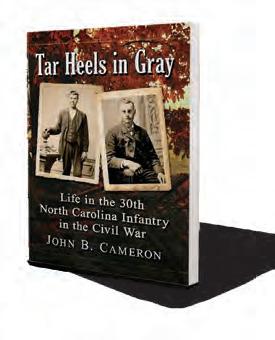
About a fifth of the book studies soldiers’ diseases. Fevers, diarrhea, and dysentery took their toll for reasons the author deftly explains. On the other hand, Cameron’s scientific zeal (such as his charts on regression analysis and the Kaplan-Meier Test on survivability) can be wearying.
What Are You Reading?
TOM HUNTINGTON
AUTHOR OF MAINE ROADS TO GETTYSBURG AND SEARCHING FOR GEORGE GORDON MEADE: THE FORGOTTEN VICTOR OF GETTYSBURG
Life in the 30th North Carolina Infantry in the Civil War
By John B. Cameron McFarland, 2022, $29.95 paperback
Unfortunately, the author’s narrative is marred by editorial judgments, especially about slavery. North Carolinians, he argues, “fought…to preserve the abhorrent system of enslavement of their fellow humans.” He argues that rich landowners essentially duped non-slaveholding Whites into fighting their war. Worse, they fell for it, believing they were defending their homes from invasion. Then, when the war was clearly lost, leaders such as Jefferson Davis and Robert E. Lee persuaded the people to fight on; too late did the survivors “realize that they had been tricked.” As Cameron declares: “It is difficult not to feel anger on behalf of the men, for all the betrayals they suffered.”
It is clear that this book was a labor of love for its author. But laden with these burdens, Tar Heels in Gray is too often for the reader merely a labor.
I just finished Troy Harman’s new All Roads Led to Gettysburg: A New Look at the Civil War’s Pivotal Campaign, which stresses the important role that roads, railways, and waterways played in how, why, and where the battle was fought. I am also reading Gettysburg as the Generals Remembered It: Postwar Perspectives of Ten Commanders by Robert P. Broadwater. It analyzes the accounts various Union generals wrote for the North American Review after they visited the battlefield in October 1890. It’s always illuminating to see how memories evolve over the years. If that weren’t enough, on my Kindle I have The Summer of ’63: Gettysburg: Favorite Stories and Fresh Perspectives from the Historians at Emerging Civil War, a collection of essays on different aspects of the battle taken from various Emerging Civil War blogs and podcasts. Gettysburg is an inexhaustible topic, always open to interpretation and re-interpretation.
All Roads Led to Gettysburg: A New Look at the Civil War’s Pivotal Campaign
 By Troy D. Harman Stackpole Books, 2022, $29.95
By Troy D. Harman Stackpole Books, 2022, $29.95
66 CIVIL WAR TIMES SUMMER 2023
REVIEWS
CWTP-230700-REVIEWS.indd 66 4/11/23 1:21 PM
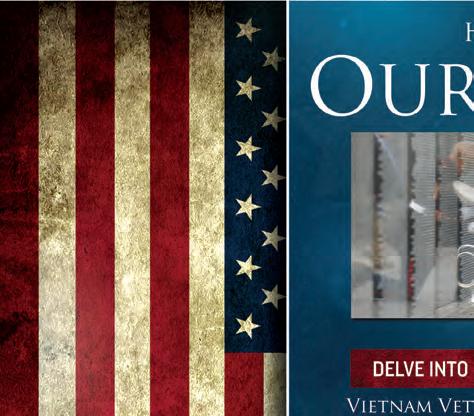





1 4/10/23 12:53 PM CWTP-230700-REVIEWS.indd 67 4/11/23 1:21 PM
CWT-230516-001 Tupelo Tourism.indd
TRANS-MISSISSIPPI COMMANDER
REVIEWED BY GORDON BERG
According to the author, Samuel Curtis “was the most important figure in the Civil War west of the Mississippi River.” Why, then, has there been no book-length biography about him until now? It’s certainly not for the sparsity of source material. Information about Union Maj. Gen. Samuel Ryan Curtis rests in libraries and archives from California to Connecticut, and William L. Shea, perhaps the premier historian of the war in the Trans-Mississippi Theater, has plumbed them all. The result is a sturdy study of a no-frills military man.
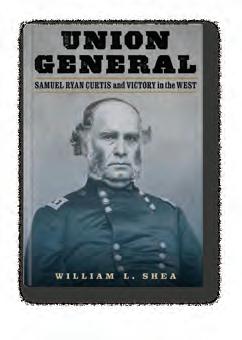
Curtis entered West Point from Ohio in 1827 and ranked 27th in a graduating class of 33 in 1831. He resigned his commission after only six months active duty and went to work as a surveyor and studied law in his spare time. When the Mexican War broke out, Shea reports, “Curtis jumped at the chance to exchange a suit for a uniform.” He found no glory in Mexico and af ter he returned home in June 1847, Curtis and his family decamped for Iowa where he enjoyed varying degrees of success and “almost incidentally, embarked on a flourishing career in politics.”
Curtis was serving as Iowa’s first Republican congressman when war broke out. The War Department appointed him mustering officer for Iowa, and the 2nd Iowa Infantry quickly elected him as their commanding officer while still serving as a sitting congressman. He witnessed the Union debacle at First Bull Run and, Shea contends, “Curtis was more convinced than ever that preparation was the key to military success.” President Lincoln soon appointed Curtis brigadier general of U.S. Volunteers and ordered him to St. Louis. After the dismissal of Maj. Gen. John C. Fremont, Maj. Gen. Henry C. Halleck placed Curtis in charge of the newly created District of Southwest Missouri with orders “to defeat, disperse, or destroy the [Confederate] Missouri State Guard.”
Curtis is best known for victories in two important Trans-Mississippi campaigns: Pea Ridge and Westport. Shea gives both superb in-depth treatment. In the March 7-8, 1862, Battle of Pea Ridge in northwestern Arkansas, Curtis triumphed against a numerically superior Confederate force and, according to Shea, “Few Civil War commanders...exhibited such a sure touch in their first engagement.”
The Missouri Expedition and Westport Campaign, from September to November 1864, were actually a bevy of battles including Newtonia, Pilot Knob, Lexington, Big Blue, and Westport. The aim was to drive Confederate General Sterling Price out of Missouri and the opposing armies “became locked in a nearly continuous series of battles, skirmishes, and r unning fights that extended over three hundred-miles from the Missouri River to the Arkansas River.”

The Ozark Plateau and the surrounding territory are particularly well-suited to guerrilla warfare that bedeviled Curtis throughout the war. At one time, he was responsible for territory that “extended from the Mississippi River to the Rocky Mountains, and included the well-worn routes of the Santa Fe and Overland Trails and the projected route of the Union Pacific Railroad.” It was, Shea informs, “the largest and most diverse of the nation’s military departments....”
At the war’s conclusion, Curtis was appointed a commissioner with the Northwest Treaty Commission tasked with convincing Indian tribes to relocate from their traditional homelands to more remote locations. His final days were spent as a commissioner resolving issues arising as part of the building of the Transcontinental Railroad, a project he helped initiate as a congressman. Curtis died at age 61 on December 26, 1866, in a railroad carriage near Council Bluff, Iowa.
68 CIVIL WAR TIMES SUMMER 2023
NATIONAL PORTRAIT GALLERY
REVIEWS
Ryan Curtis and Victory in the West By William L. Shea Potomac Books, 2023, $34.95
CWTP-230700-REVIEWS.indd 68 4/11/23 1:21 PM
Samuel Ryan Curtis, an overlooked general.
A ROAD TRIP LIKE NO OTHER! BATTLEFIELDS, FORTS AND A WILD BOAR
For more than a year, John Banks crisscrossed the country, exploring battlefields, historic houses, forts, and more. He rode on the back of an ATV with his “psychotic connection” in Mississippi, went under the spell of an amateur hypnotist at a U.S. Army fort in Tennessee, admired a sunset from the grounds of the notorious Andersonville prison camp in Georgia, prayed during a tense boat ride in Charleston Harbor in South Carolina, and briefly interviewed Louie the wild boar in Virginia’s Shenandoah Valley. Join him on a road trip like no other.
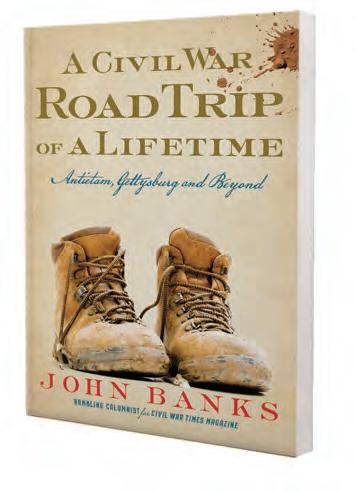
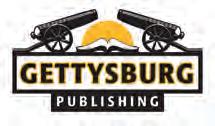
John Banks, a longtime journalist, is a columnist for Civil War Times magazine. His work has also appeared in the New York Times , Dallas Morning News , American History, America’s Civil War and elsewhere. Banks is secretary-treasurer of The Center for Civil War Photography and a board member of the Save Historic Antietam Foundation and Battle of Nashville Trust. He lives in Nashville with his wife, Carol—his beloved “Mrs. B.”
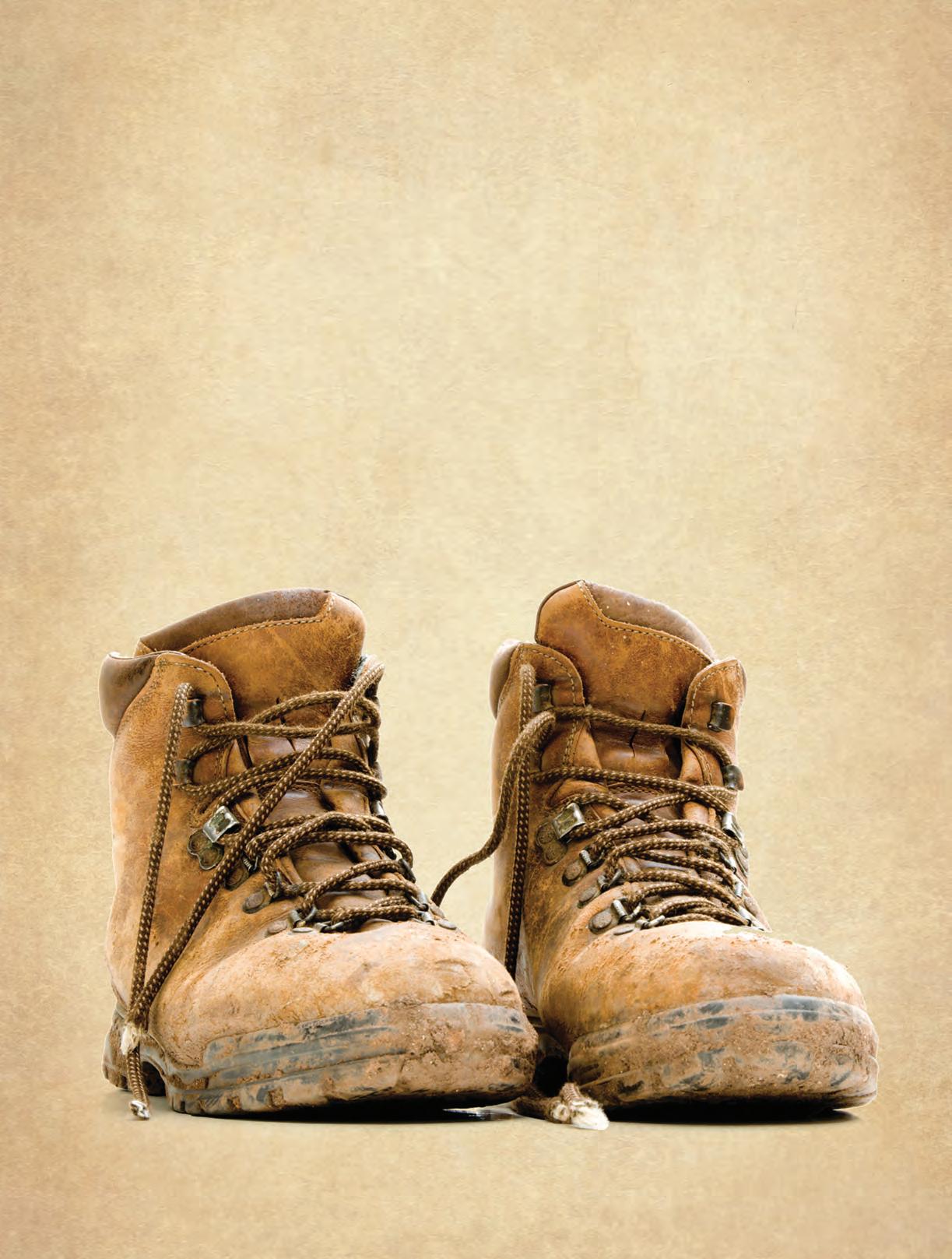
GETTYSBURGPUBLISHING.COM
PRE-ORDER NOW! JUNE 2023 RELEASE GBURGPUB-BANKS-AD.indd 20 4/10/23 4:54 PM
REVIEWS
ATTIC INSPIRATION
REVIEWED BY GEORGE SKOCH
William Iseminger was a youngster exploring the dark and dusty corners of the attic in his grandparent’s home in Heyworth, Ill., in McLean County, when the origins for this book first emerged. Amid the “trappings of several generations,” recalls Iseminger, was an “old rifle, a bayonet with a scabbard, and a leather cartridge box, which we were told once belonged to our great-grandfather, Tubal Wile Iseminger.” Tubal served as a private in the 94th Illinois Infantry, Company B, from August 1862 until July 1865.
Over time, the author inherited these relics, plus a trove of Tubal’s Civil War–era letters and diaries. Later, the wartime diary and letters written by the author’s maternal great-grandfather were passed on to him. “Harrison Henson Clark…also served in the…94th Illinois Infantry Regiment,” Iseminger writes, “although in a different company.” Clark became a private in Company I in August 1862, and mustered out as a sergeant in July 1865.
“The concept of this book began with the author’s transcribing the diaries and letters of…his great-grandfathers.” He gradually expanded on these to include “letters and diaries of 21 additional soldiers in the Regiment.” Iseminger further uses “many letters” written from the ranks of the 94th Illinois and published in the Bloomington Daily Pantagraph newspaper. He presents original documents verbatim, and acknowledges “quite a variation in penmanship, spelling, and grammar (or lack thereof)…”
Noteworthy are the previously published (though on a limited scale) letters of Colonel William W. Orme, who was instrumental in raising the regiment and became its first commander, receiving praise from Abraham Lincoln as one of the “best men in the world.” Orme’s letters to his wife are especially informative and poignant.
This volume, however, is not a conventional regimental history, nor does the author claim it to be. “The book,” Iseminger concedes, “is…more… a personalized history of the Regiment as viewed by the soldiers and expressed in their own word…essentially as a daily record of the movements, activities, and encounters of the unit throughout their three years of service…”
The unit’s principal actions came at the Battle of Prairie Grove, and during the Vicksburg and Mobile campaigns.
It must be noted that the book lacks an index and is devoid of standard notations—serious drawbacks for researchers and earnest students of the war. The author admits “liberally” paraphrasing some entries, and where he felt a “need for clarification” used an informal mode of brackets [ ] and italicized brackets [ ] to distinguish documents and individual writers.
The book’s strength is the sheer number of human interest stories Iseminger has amassed and arranged chronologically. Consider, for example, the case of Private Frederick Schlagel of Company A, who died during an action at Vicksburg on June 24, 1863. Several witnesses recorded events in their diaries, each with a fresh viewpoint.
From McLean to Mobile: A History of the 94th Illinois Infantry Regiment Volunteers, 1862-1865—“The McLean Regiment”
By William Iseminger
Self-Published, 2022, $34.61
After describing the action, Iseminger writes: “Co. B was held in reserve most of the day, but at 4 pm they were ordered to support Co. A in a charge on a rifle pit but heavy cross-fire of grape and shell from Rebel artillery forced them back. One man, Frederick Schlagel, was killed by....”
Recalls another soldier: “The rifle pits were taken…Frederick Schlagel…was wounded in the side, by a piece of a shell and died about dusk.”
Finally, Colonel Orme reveals in a letter to his wife: “Our boys…took the rifle pit & got eight prisoners…Fred Schlagel, who used to butcher for Mrs. White…was killed by a shell which nearly cut him in two through the bowels…”
Their are more than 100 photographs, illustrations, and maps, many in color. His appendices, garnered from the Internet, include a regimental roster, and a list of McLean County soldiers from the 94th Illinois who perished. The illfated Fred Schlagel was one of the nine enlisted men killed and mortally wounded; four officers and 162 enlisted men died of disease.
The homespun nature of this volume may turn away scholars, but much of it will interest the diligent and persistent casual reader willing to invest time and patience to seek it. Meanwhile, the 94th Illinois Infantry still awaits a modern history. William Iseminger’s From McLean to Mobile may be a helpful starting point.
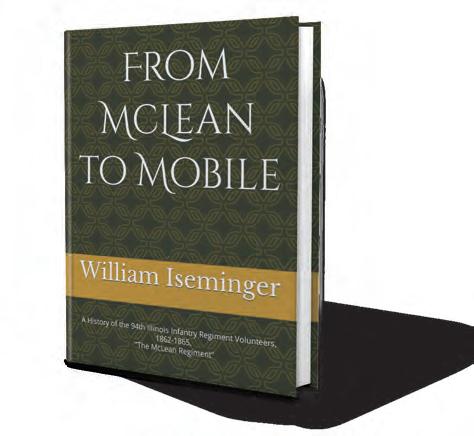
70 CIVIL WAR TIMES SUMMER 2023
CWTP-230700-REVIEWS.indd 70 4/11/23 1:21 PM
TODAY IN HISTORY
MAY 13, 1865
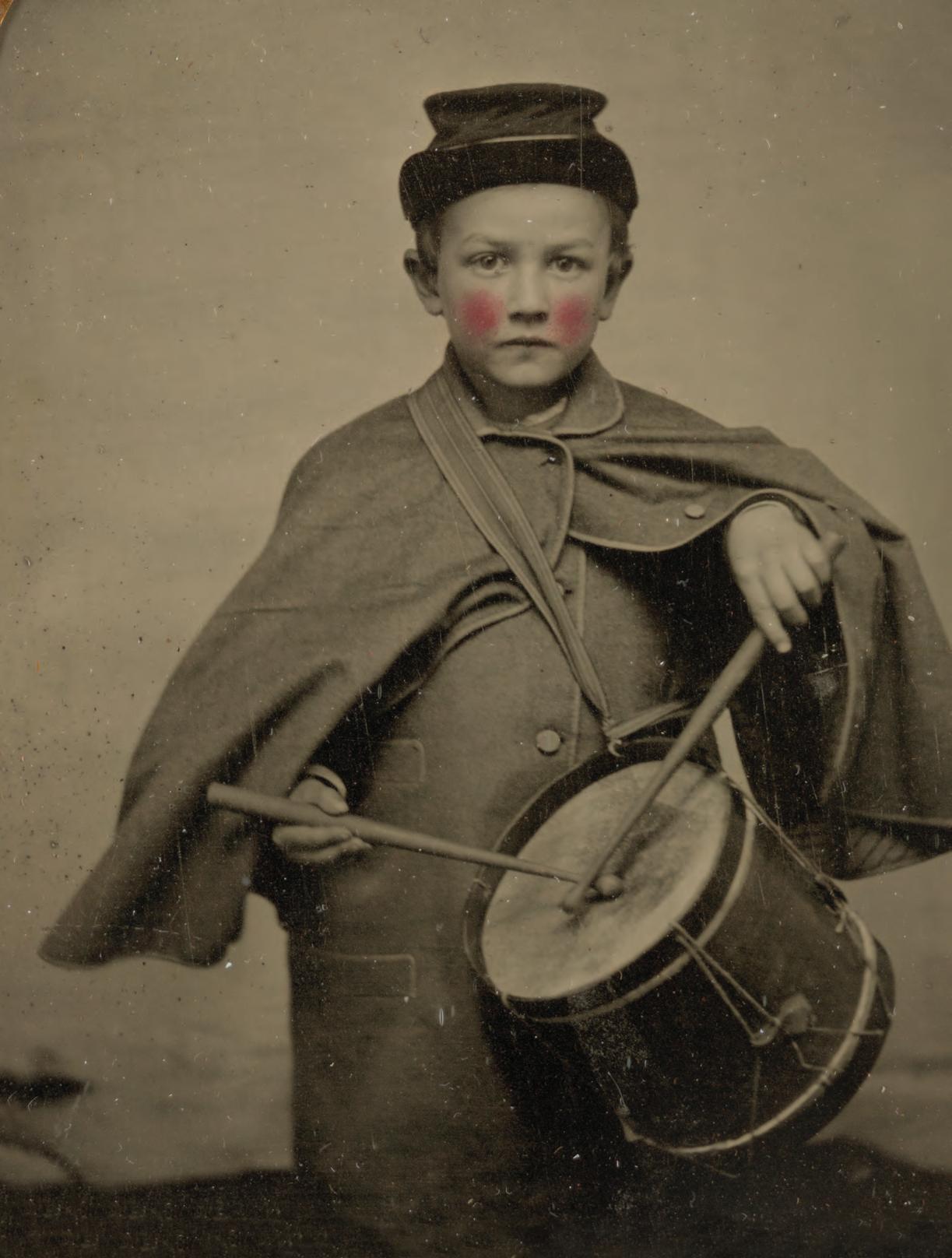
UNION SOLDIER JOHN J. WILLIAMS IS KILLED ON THE BANKS OF THE RIO GRANDE DURING THE BATTLE OF PALMITO RANCH. RECOGNIZED AS THE LAST MAN TO DIE IN THE AMERICAN CIVIL WAR, HE WAS ONE OF AN ESTIMATED 700,000 MEN—ROUGHLY 2% OF THE U.S. POPULATION AT THE TIME— WHO LOST THEIR LIVES DURING THE CONFLICT. THOSE DEATHS ROUGHLY EQUAL THE COMBINED AMERICAN FATALITIES IN THE REVOLUTIONARY WAR, THE WAR OF 1812, THE MEXICAN-AMERICAN WAR, THE SPANISH-AMERICAN WAR, WORLD WAR I, WORLD WAR II, AND THE KOREAN WAR.
For more, visit HISTORYNET.COM/TODAY-IN-HISTORY
TODAY-JOHNWILLIAMS.indd 22 3/31/23 8:53 AM
LIGHT ARTILLERY $400
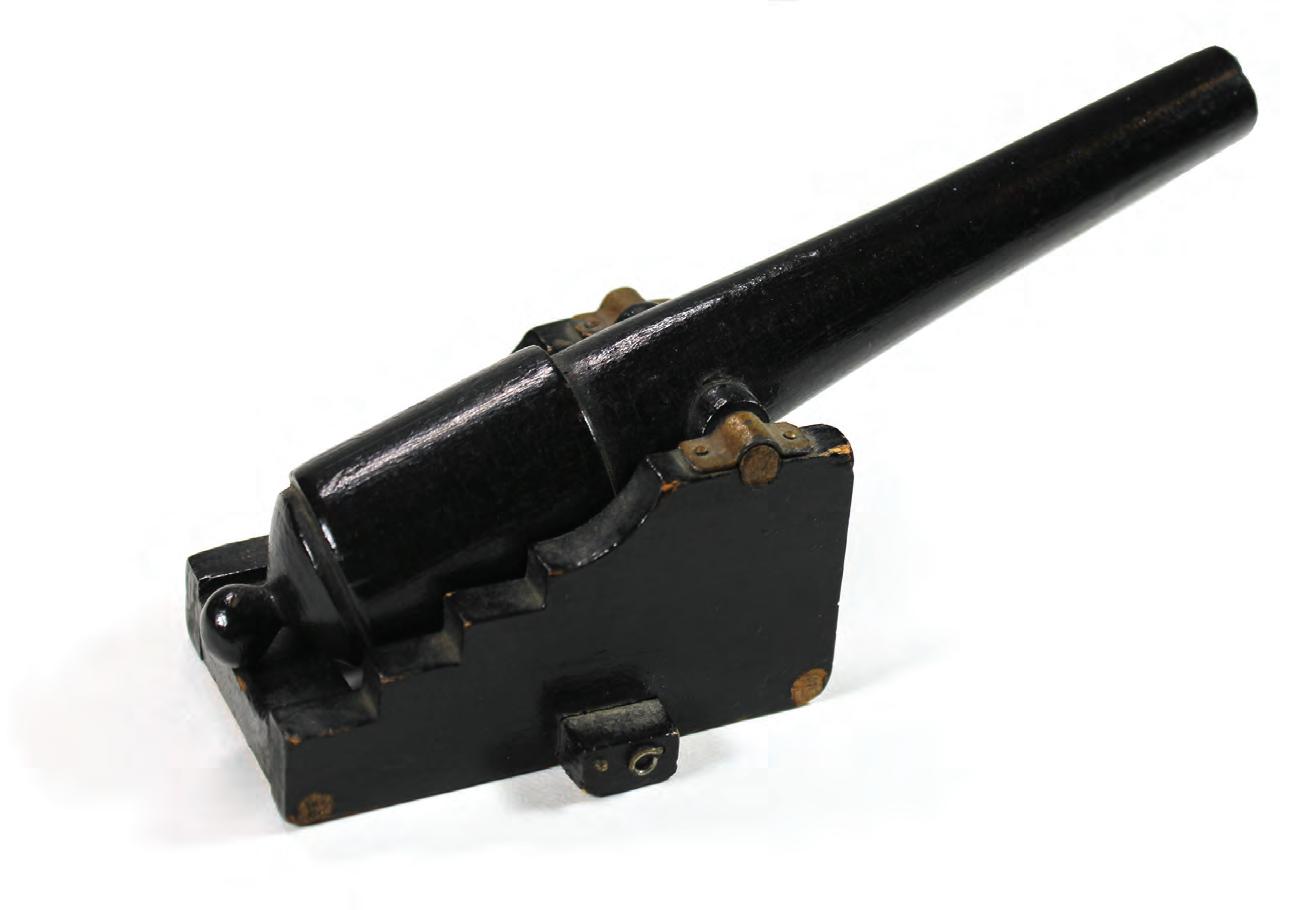
ELISHA HUNT RHODES was one of those rare Civil War soldiers who served the entire conflict from 1861 to 1865 without suffering a major injury despite serving in most of the Eastern Theater’s major engagements. Rhodes enlisted as a corporal in the 2nd Rhode Island Infantry and rose through the ranks until he was discharged as a brevet colonel of the regiment. His name has a familiar ring because Ken Burns plumbed Rhodes’ copious wartime diary for frequent quotes during the riveting PBS documentary The Civil War . This miniature cannon, which Rhodes owned after the war, was recently sold by Fleischer’s Auctions. Measuring 5 ½ inches, it was modeled after a Parrott rifle placed on a garrison or naval carriage. We are left to wonder what thoughts of desperate battle or friends long gone came to Rhodes’ mind when he gazed at the knickknack. — D.B.S.
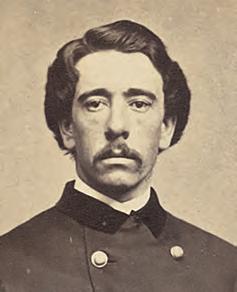
72 CIVIL WAR TIMES SUMMER 2023
FLEISCHER’S AUCTIONS; LIBRARY OF CONGRESS
SOLD!
CWTP-230700-SOLD.indd 72 4/4/23 8:22 AM
Throw Yourself a Bone
Full tang stainless steel blade with natural bone handle —now ONLY $79!
Thevery best hunting knives possess a perfect balance of form and function. They’re carefully constructed from fine materials, but also have that little something extra to connect the owner with nature. If you’re on the hunt for a knife that combines impeccable craftsmanship with a sense of wonder, the $79 Huntsman Blade is the trophy you’re looking for.
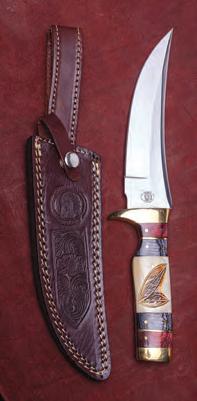
The blade is full tang, meaning it doesn’t stop at the handle but extends to the length of the grip for the ultimate in strength. The blade is made from 420 surgical steel, famed for its sharpness and its resistance to corrosion.
The handle is made from genuine natural bone, and features decorative wood spacers and a hand-carved motif of two overlapping feathers— a reminder for you to respect and connect with the natural world.
This fusion of substance and style can garner a high price tag out in the marketplace. In fact, we found full tang, stainless steel blades with bone handles in excess of $2,000. Well, that won’t cut it around here. We have mastered the hunt for the best deal, and in turn pass the spoils on to our customers.
But we don’t stop there. While supplies last, we’ll include a pair of $99 8x21 power compact binoculars and a genuine leather sheath FREE when you purchase the Huntsman Blade
Your satisfaction is 100% guaranteed. Feel the knife in your hands, wear it on your hip, inspect the impeccable craftsmanship. If you don’t feel like we cut you a fair deal, send it back within 30 days for a complete refund of the item price.
Limited Reserves. A deal like this won’t last long. We have only 1120 Huntsman Blades for this ad only. Don’t let this beauty slip through your fingers. Call today!
Huntsman Blade $249*
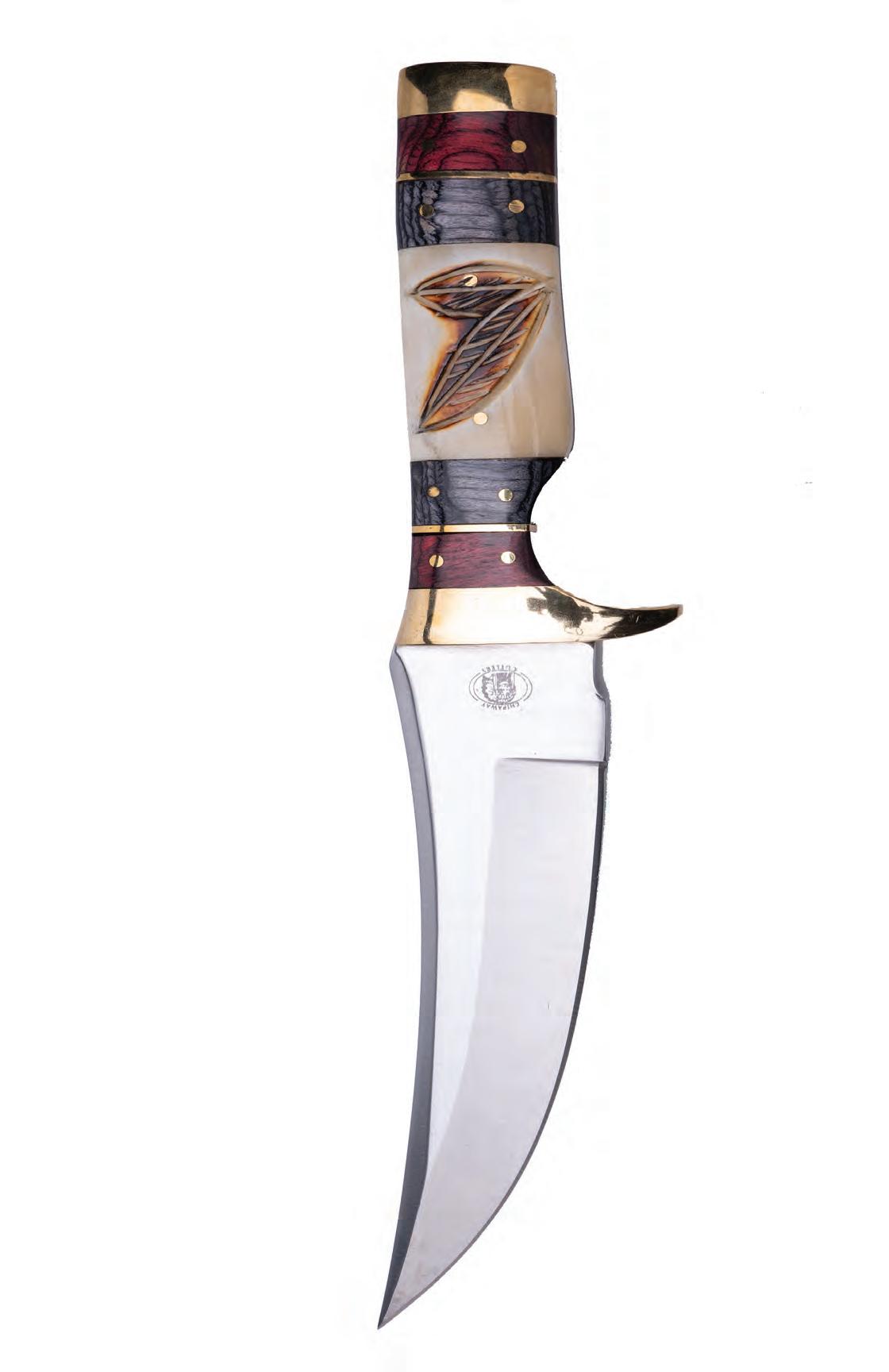
Offer Code Price Only $79 + S&P Save $170
1-800-333-2045
Your Insider Offer Code: HBK145-01
You must use the insider offer code to get our special price.
Stauer ®
Stauer® 8x21 Compact Binoculars -a $99 valuewith purchase of Huntsman Blade
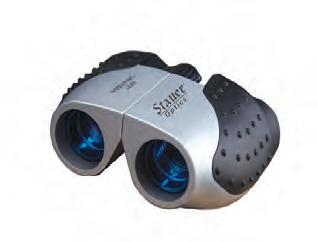
What Stauer Clients Are Saying About Our Knives


“This knife is beautiful!”
— J., La Crescent, MN
“The feel of this knife is unbelievable...this is an incredibly fine instrument.”
— H., Arvada, CO
Rating of A+
14101 Southcross Drive W., Ste 155, Dept. HBK145-01 Burnsville, Minnesota 55337 www.stauer.com
*Discount is only for customers who use the offer code versus the listed original Stauer.com price.
California residents please call 1-800-333-2045 regarding Proposition 65 regulations before purchasing this product.
• 12” overall length; 6 ¹⁄2” stainless steel full tang blade • Genuine bone handle with brass hand guard & bolsters • Includes genuine leather sheath
Stauer… Afford the Extraordinary ®

today and
also receive this genuine leather sheath!
BONUS! Call
you’ll
FREE
EXCLUSIVE
CWT-230516-003 Stauer-Huntsman Blade.indd 1 4/3/2023 7:20:12 AM
Lives Remembered are never Lost
STEPHEN
THIS
THIS HALLOWED GROUND : A
GROUND : A TOUR YOU WON’T FORGET
May 13-21, June 17-25 or September 16-24, 2023
May 13-21, June 17-25 or September 16-24, 2023
Relive Civil War history! Walk This Hallowed Ground at Manassas/Bull Run, Gettysburg and Appomattox to experience the beginning and end of the Civil War. Visit Memphis, Shiloh, Vicksburg and New Orleans on our Mississippi River Campaign Tour, to study “the key to the Confederacy.” Explore the rivers, ridges and the battles that raged from Atlanta to Chattanooga to Nashville on our Civil War on the Rivers, Rails and Mountains Tour Our Civil War, American History and WWII tours are unrivaled in their historical accuracy!
Relive Civil War history! Walk This Hallowed Ground at Manassas/Bull Run, Gettysburg and Appomattox to experience the beginning and end of the Civil War. Visit Memphis, Shiloh, Vicksburg and New Orleans on our Mississippi River Campaign Tour, to study “the key to the Confederacy.” Explore the rivers, ridges and the battles that raged from Atlanta to Chattanooga to Nashville on our Civil War on the Rivers, Rails and Mountains Tour Our Civil War, American History and WWII tours are unrivaled in their historical accuracy!
Relive Civil War history! Walk This Hallowed Ground at Manassas/Bull Run, Gettysburg and Appomattox to experience the beginning and end of the Civil War. Visit Memphis, Shiloh, Vicksburg and New Orleans on our Mississippi River Campaign Tour, to study “the key to the Confederacy.” Explore the rivers, ridges and the battles that raged from Atlanta to Chattanooga to Nashville on our Civil War on the Rivers, Rails and Mountains Tour. Our Civil War, American History and WWII tours are unrivaled in their historical accuracy!
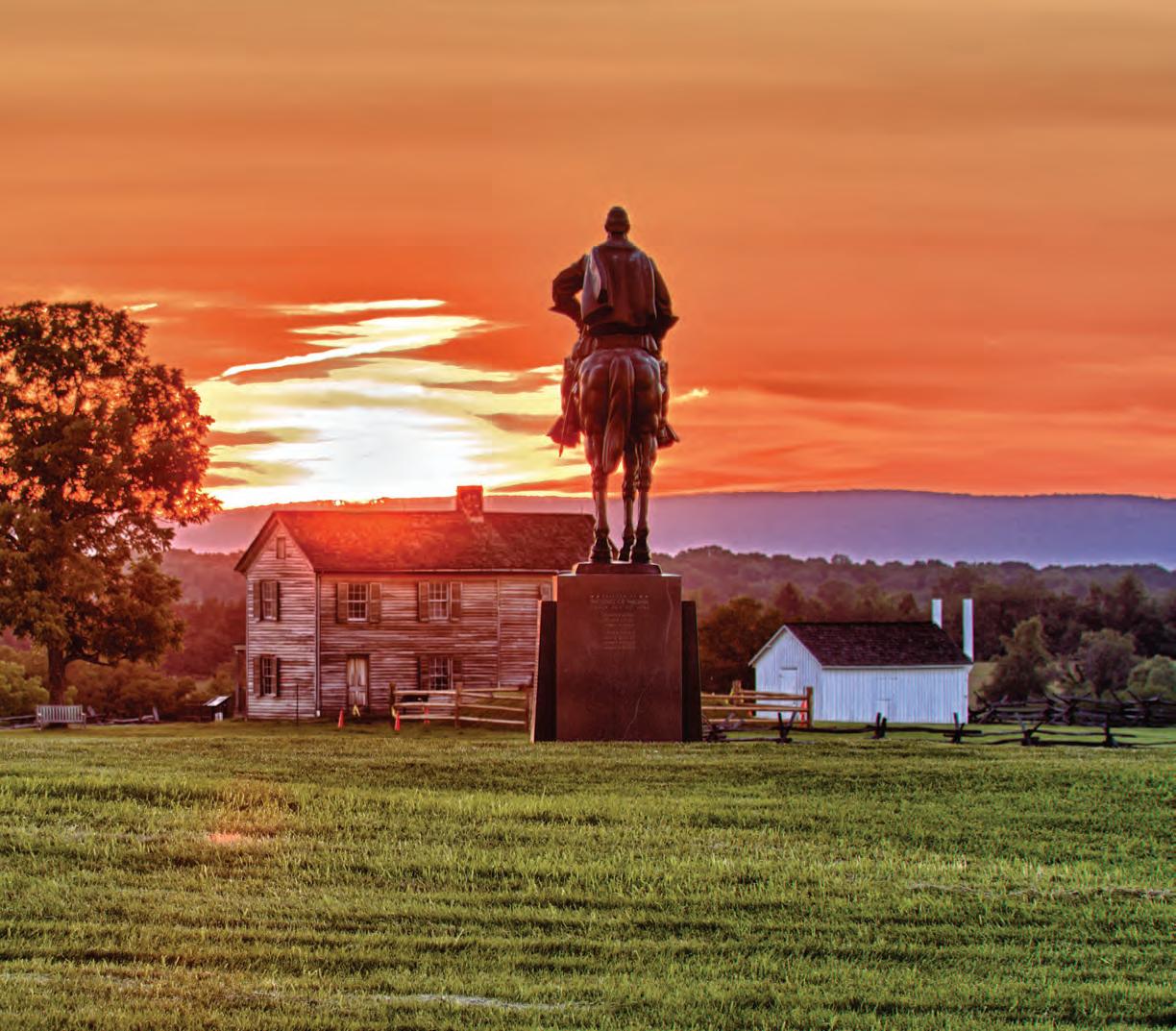


THIS HALLOWED GROUND : A TOUR YOU WON’T FORGET
AMBROSE HISTORICAL TOURS PRESENTS
STEPHEN
EXPLORE NOW AT STEPHENAMBROSETOURS.COM 1.888.903.3329
May 13-21, June 17-25 or September 16-24, 2023
CWT-230516-008 Stephen Ambrose Historical Tours.indd 1 4/11/2023 8:56:38 AM
HALLOWED
AMBROSE HISTORICAL TOURS PRESENTS
EXPLORE NOW AT STEPHENAMBROSETOURS.COM 1.888.903.3329
CWT-230516-008 Stephen Ambrose Historical Tours.indd 1 4/11/2023 8:56:38 AM
TOUR YOU WON’T FORGET STEPHEN AMBROSE HISTORICAL TOURS PRESENTS
EXPLORE NOW AT STEPHENAMBROSETOURS.COM 1.888.903.3329
Travel to Gettysburg on our THISGROUNDHALLOWED TOUR BOOK NOW! CWT-230516-008 Stephen Ambrose Historical Tours.indd 1 4/11/2023 8:56:38 AM AMBROSE.indd 6 4/13/23 8:46 AM







































































































































































 Dale S. Snair
Dale S. Snair


 Pete Beisler
Cumberland, Maine
Pete Beisler
Cumberland, Maine































































































































 BY JARED PEATMAN
BY JARED PEATMAN











 BY STUART W. SANDERS
BY STUART W. SANDERS








 BY HARRY SMELTZER
BY HARRY SMELTZER









 BY MICHAEL WARICHER
BY MICHAEL WARICHER



































 By Hampton Newsome University Press of Kansas, 2022, $36.95
By Hampton Newsome University Press of Kansas, 2022, $36.95



 By Troy D. Harman Stackpole Books, 2022, $29.95
By Troy D. Harman Stackpole Books, 2022, $29.95




















